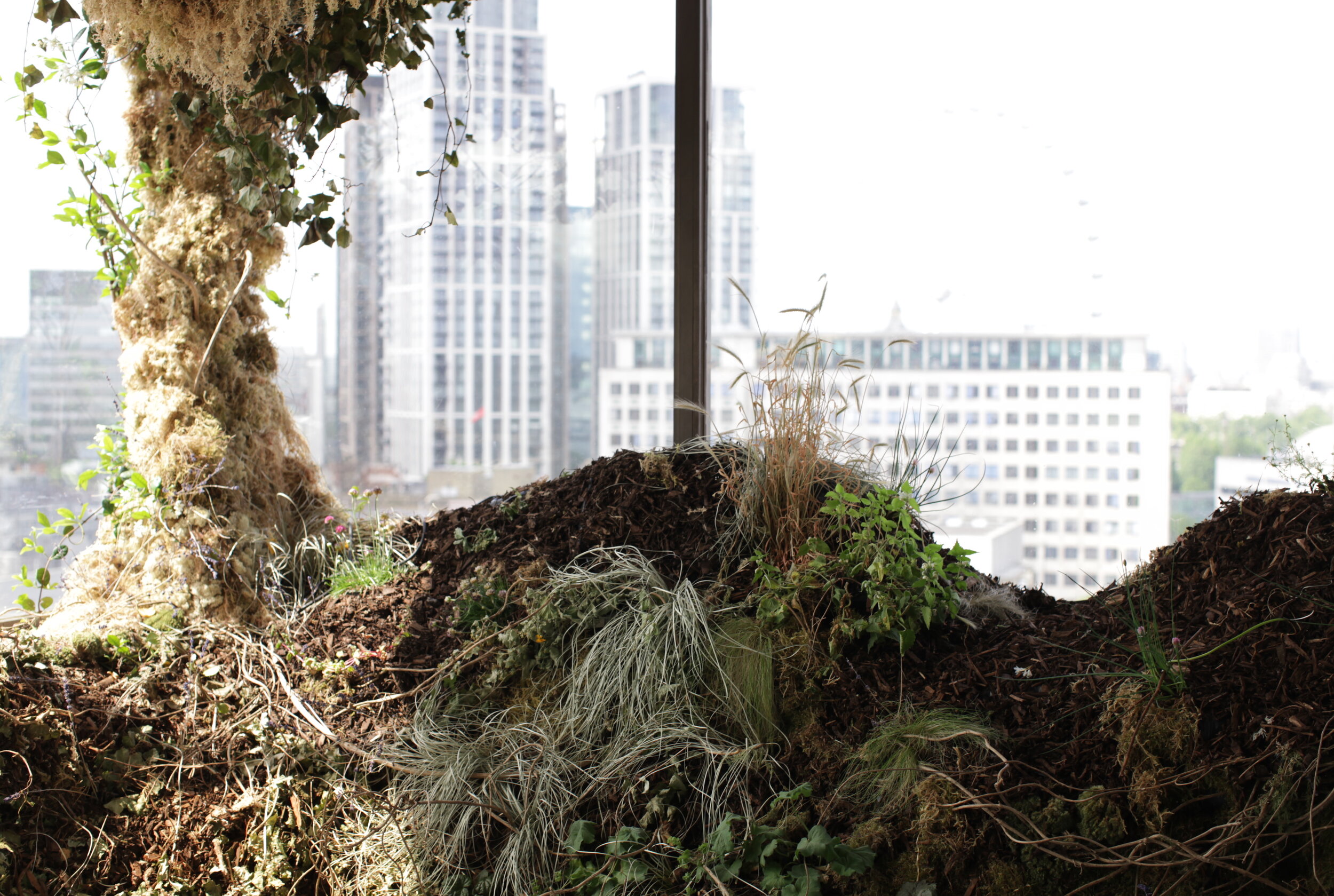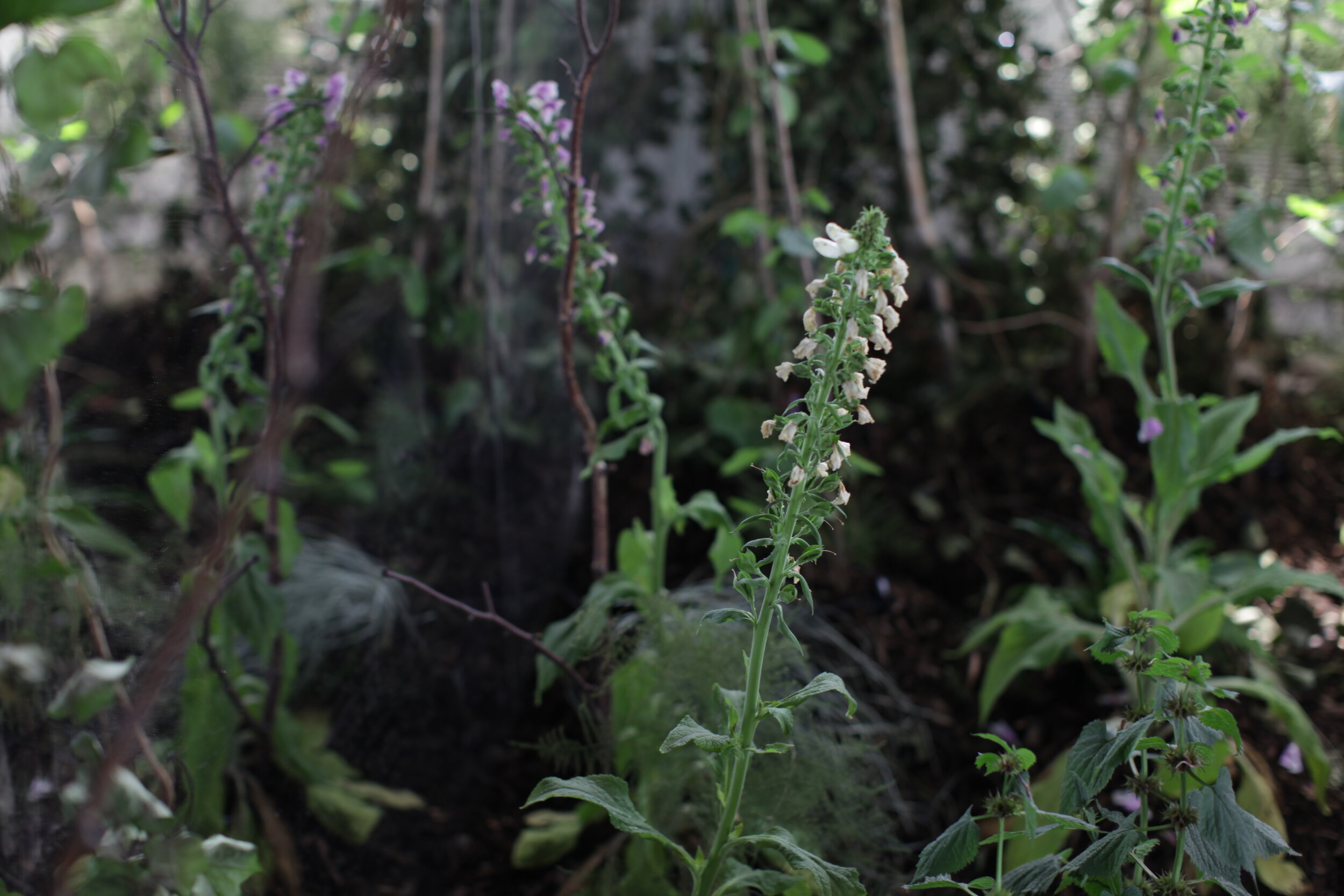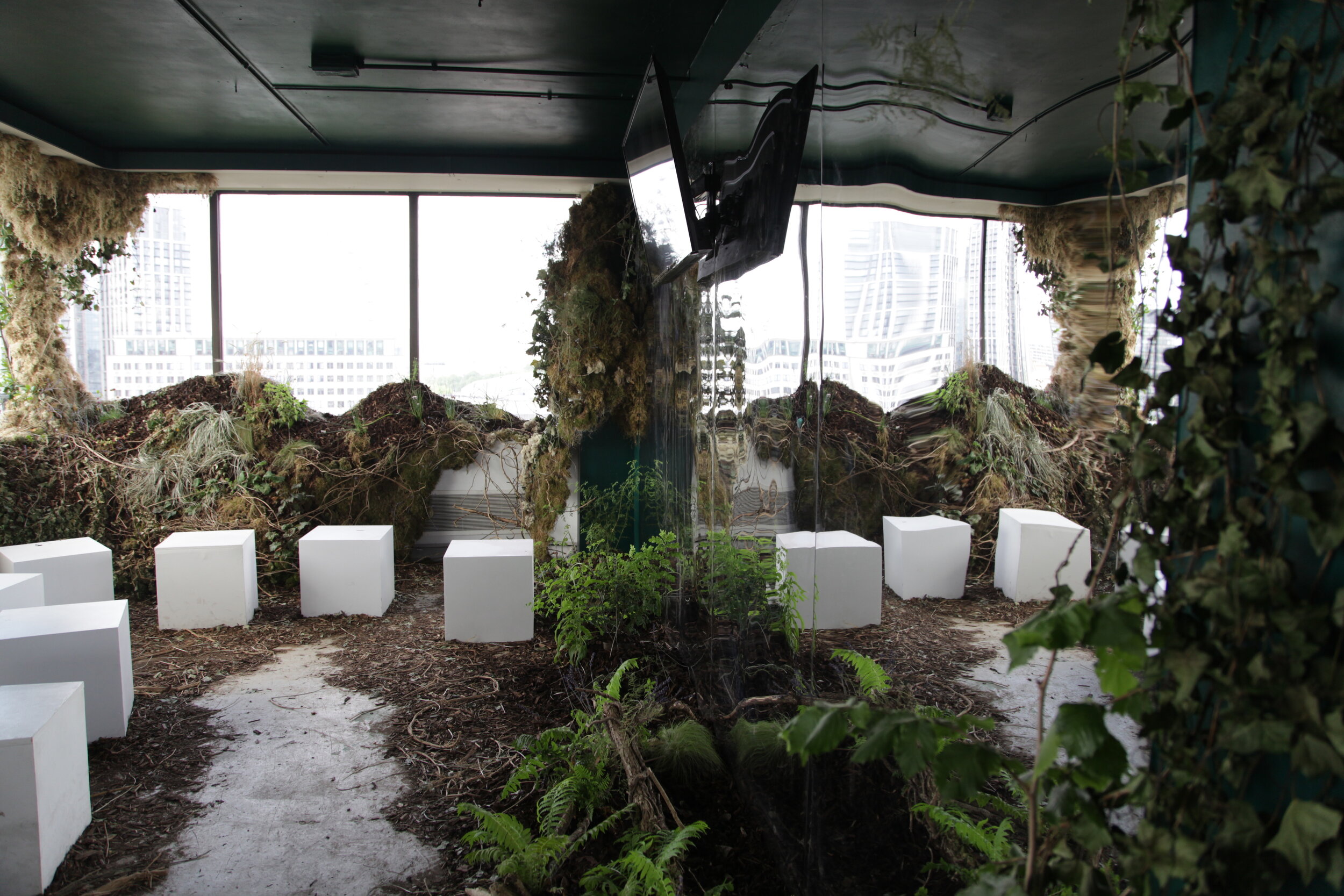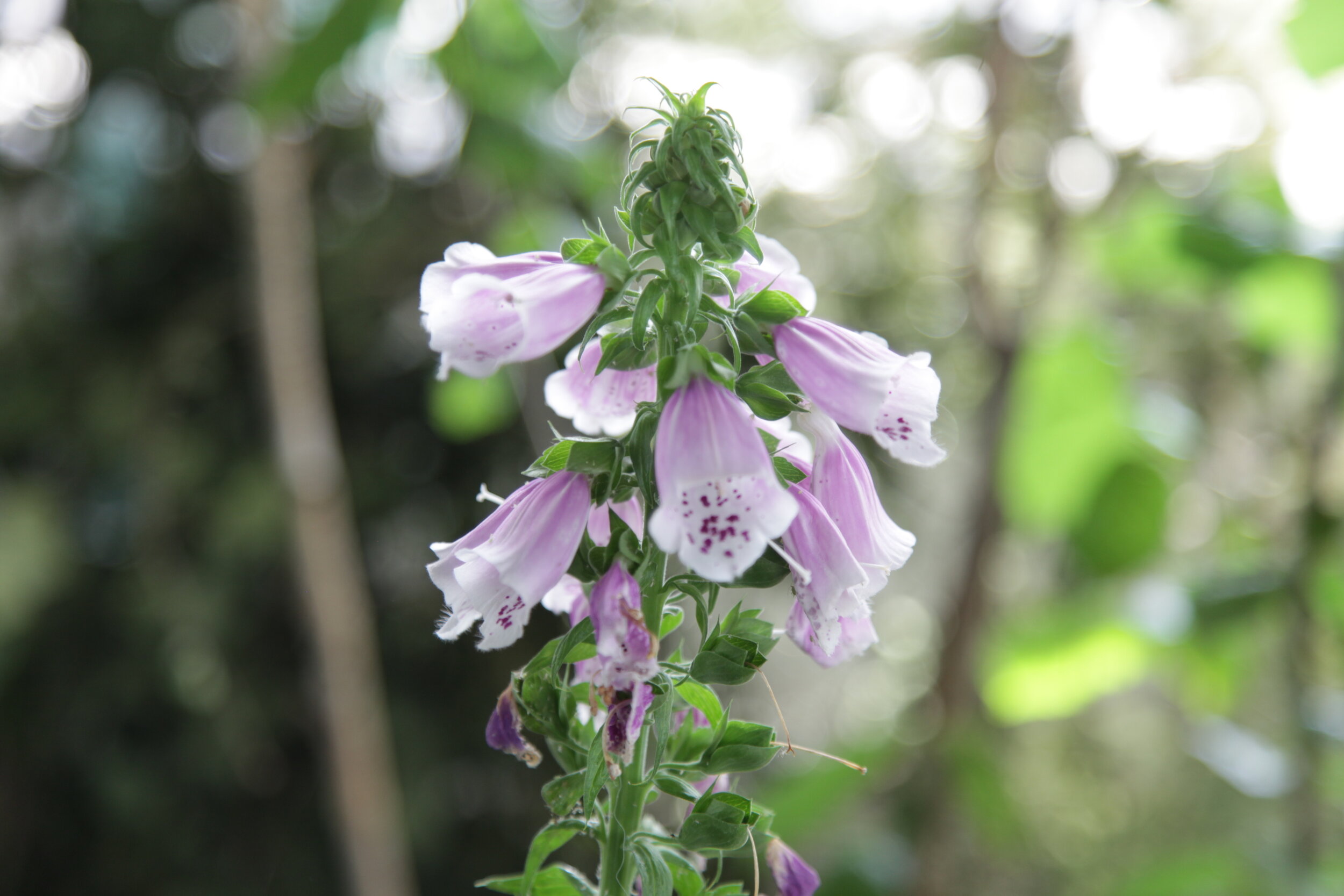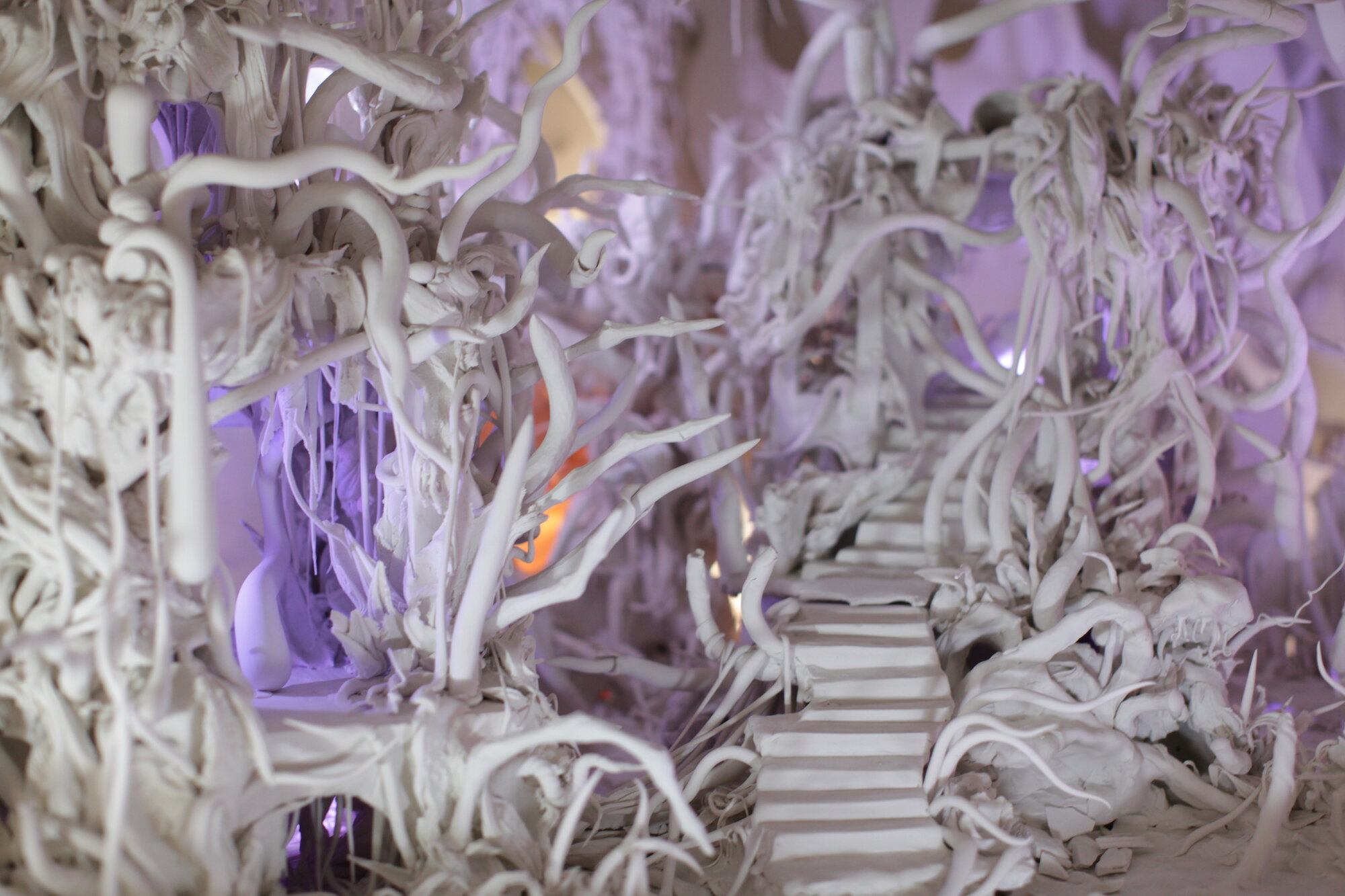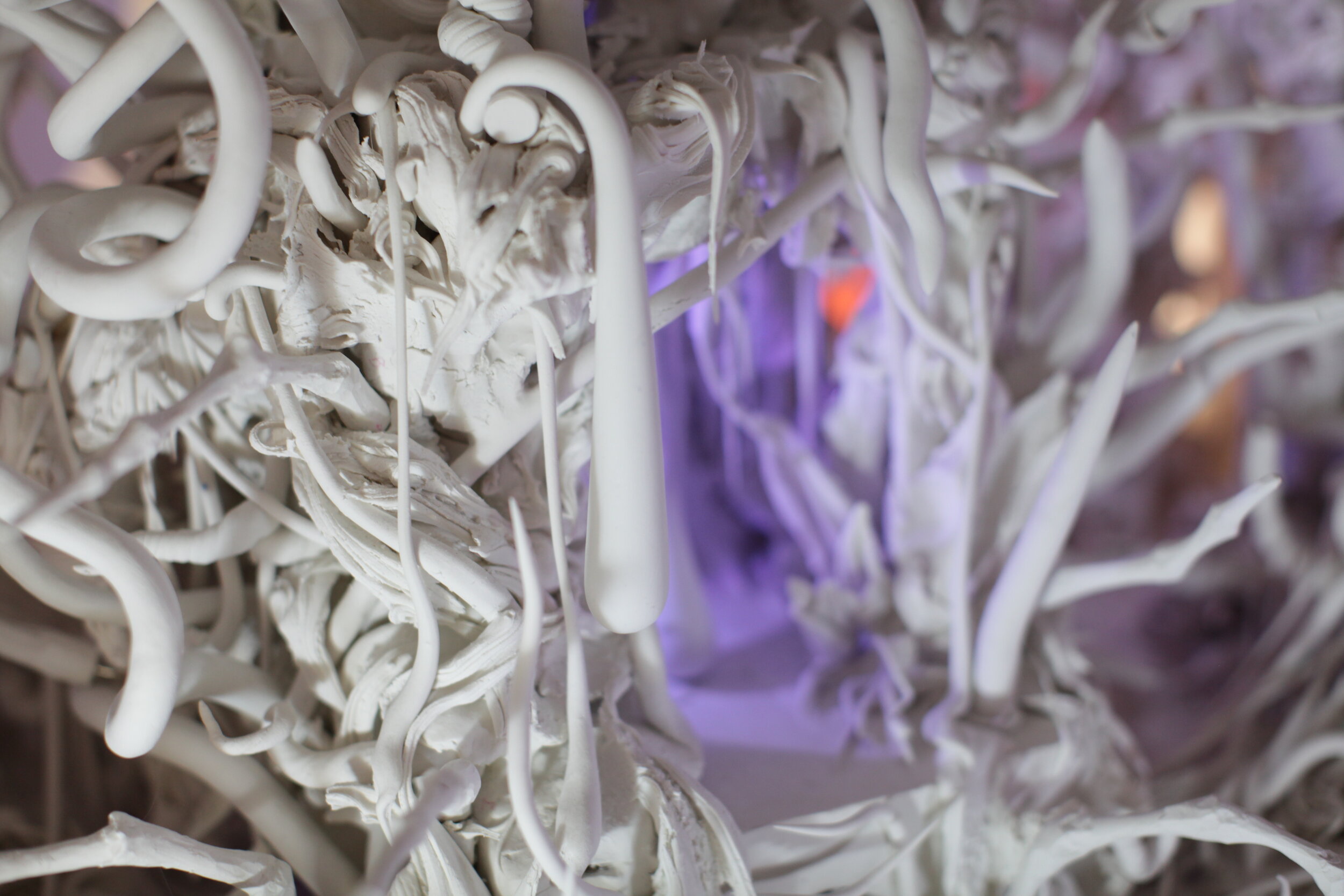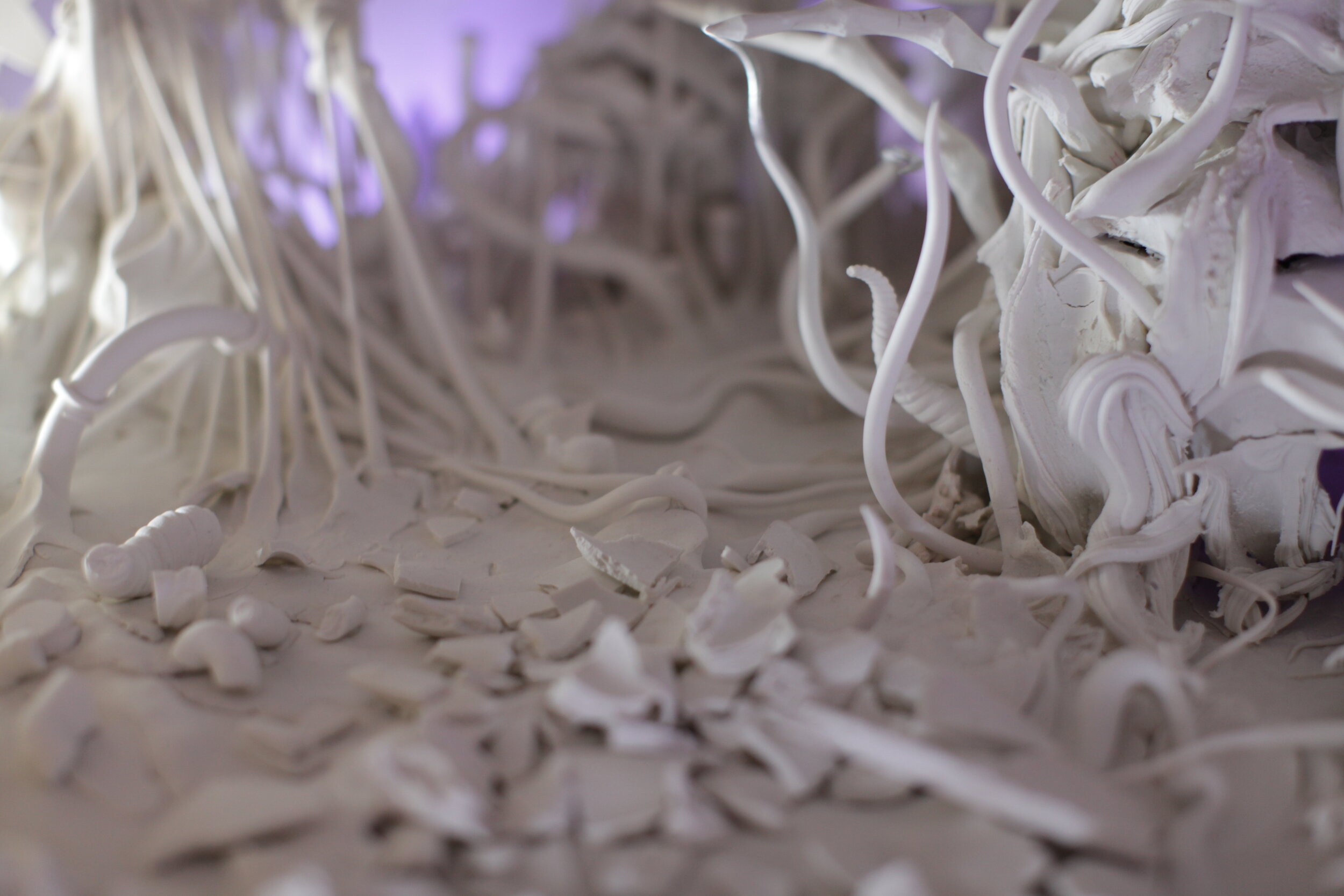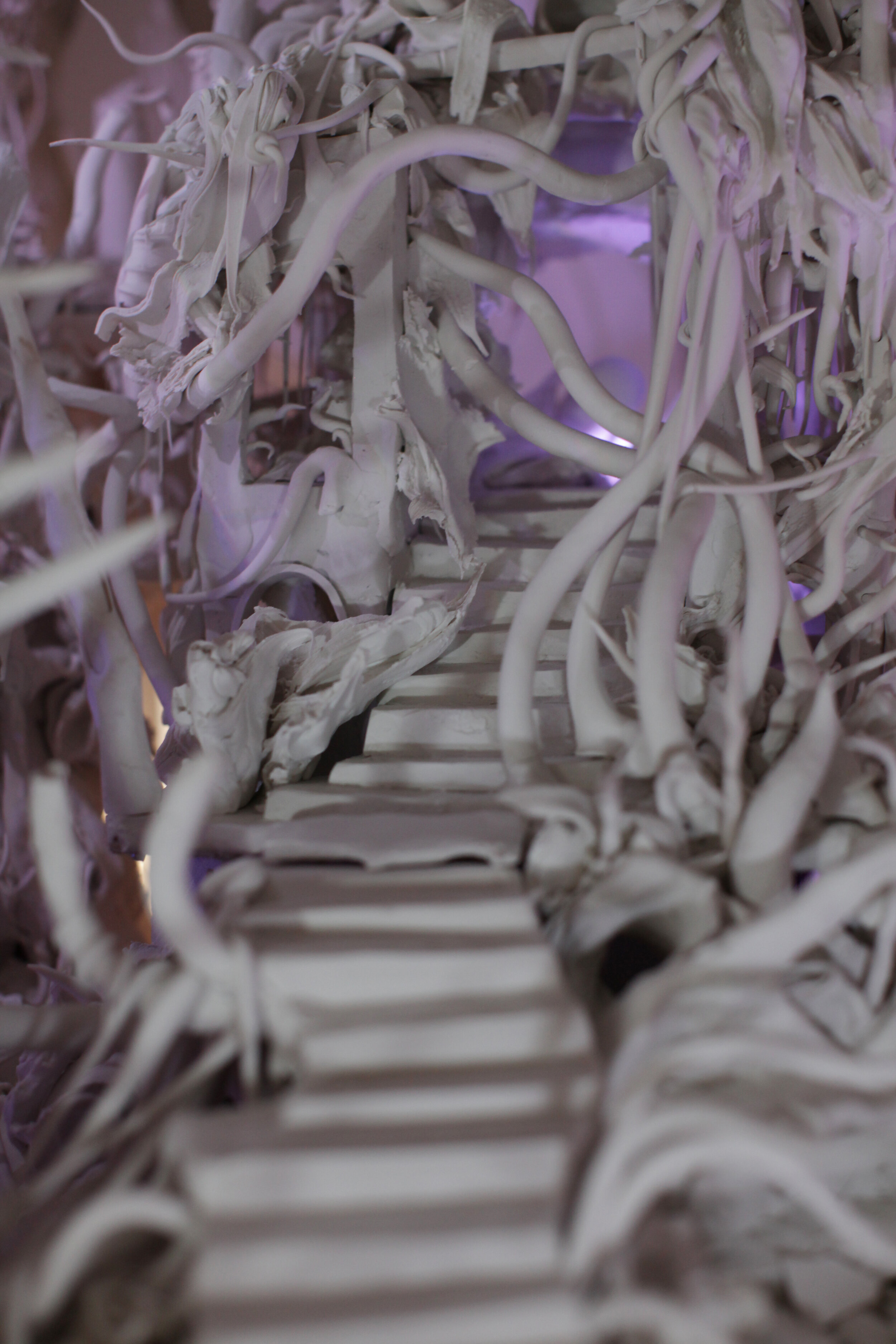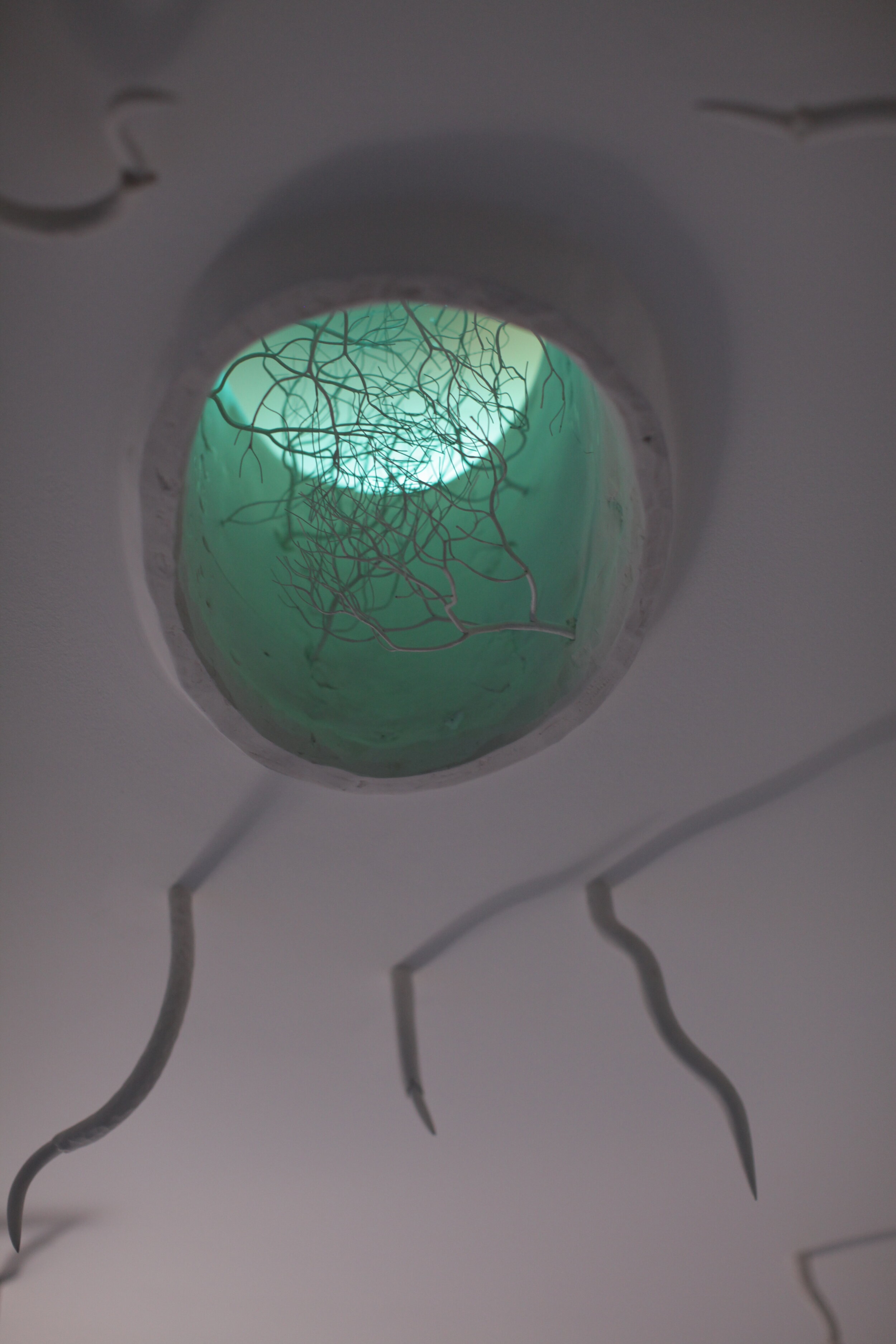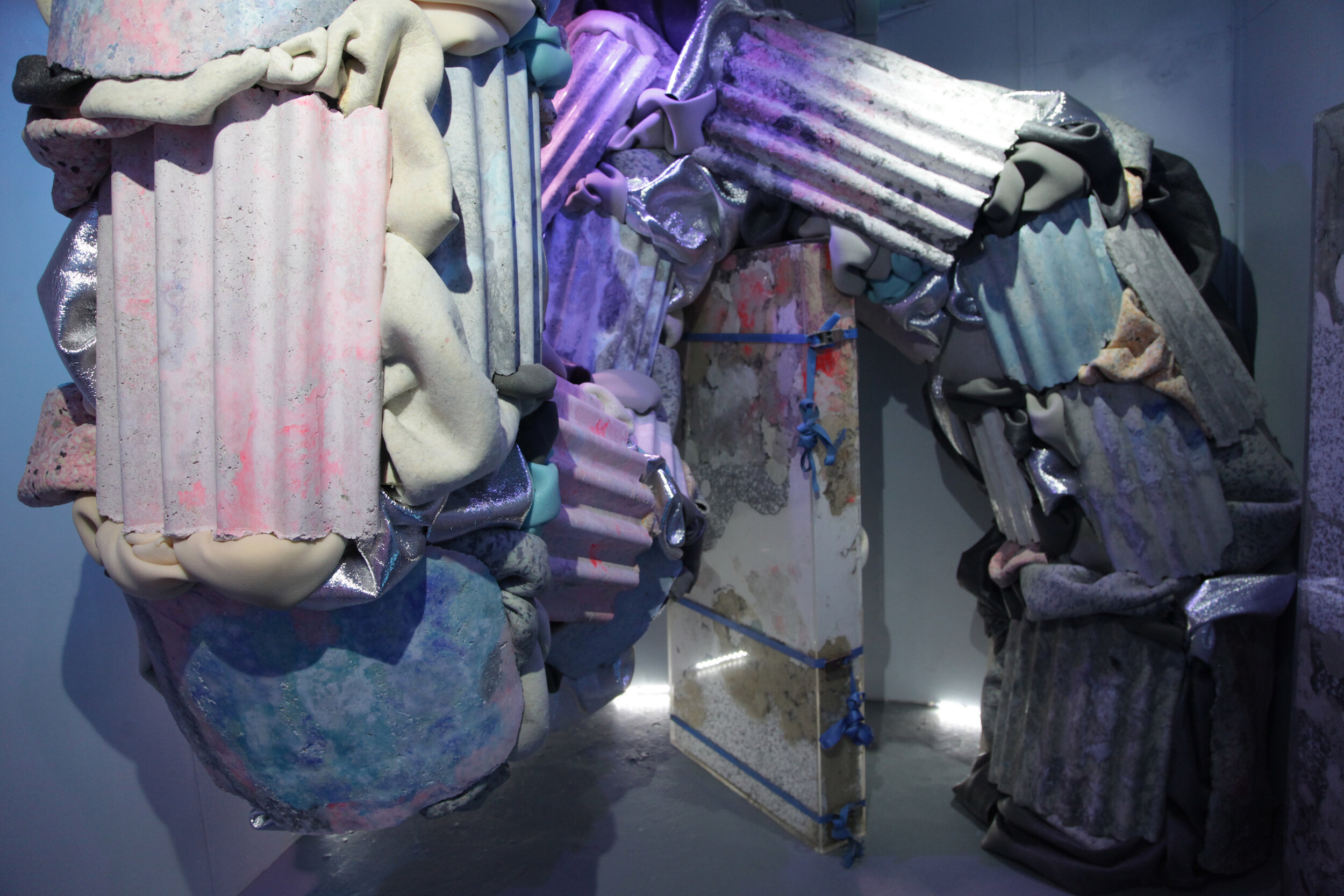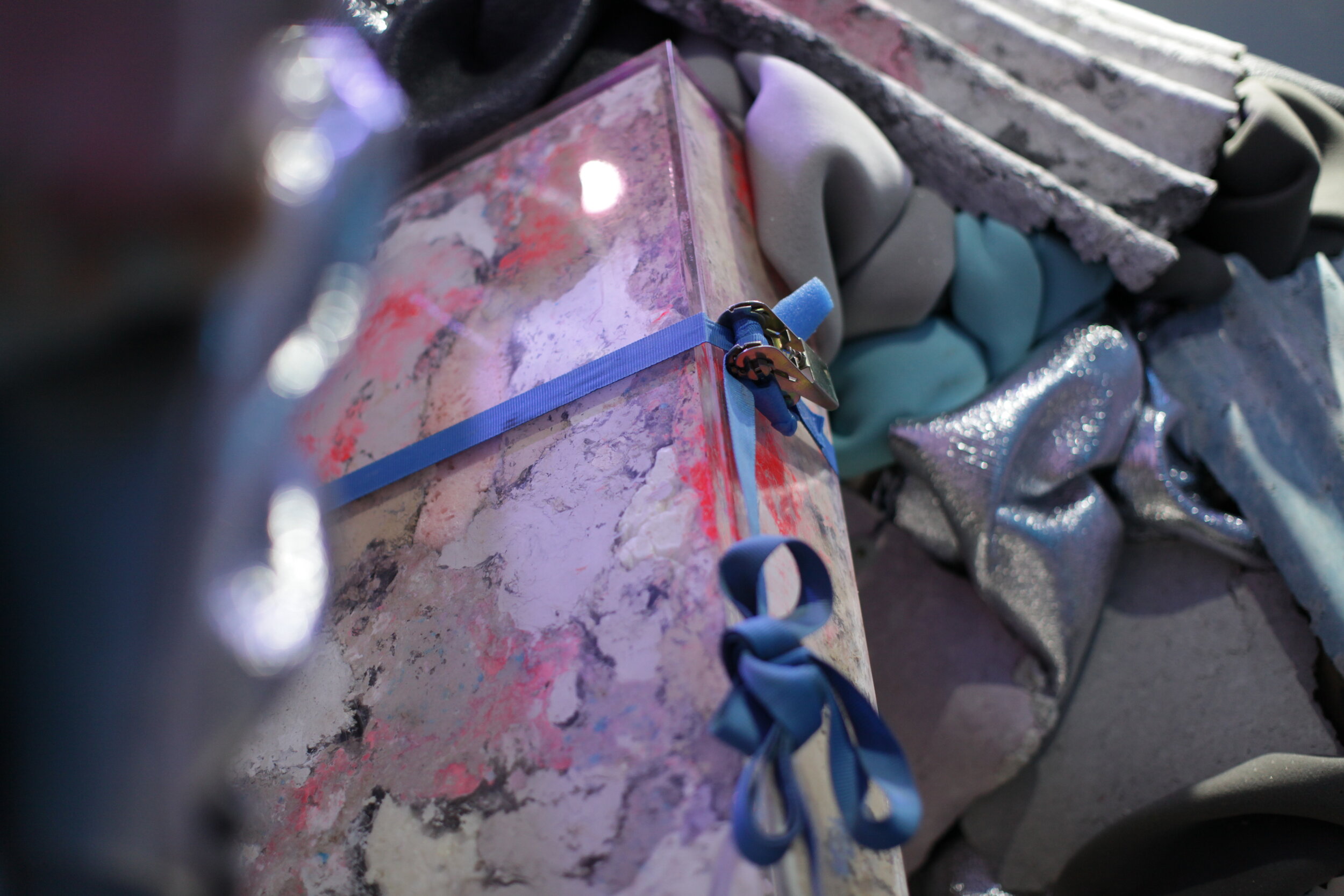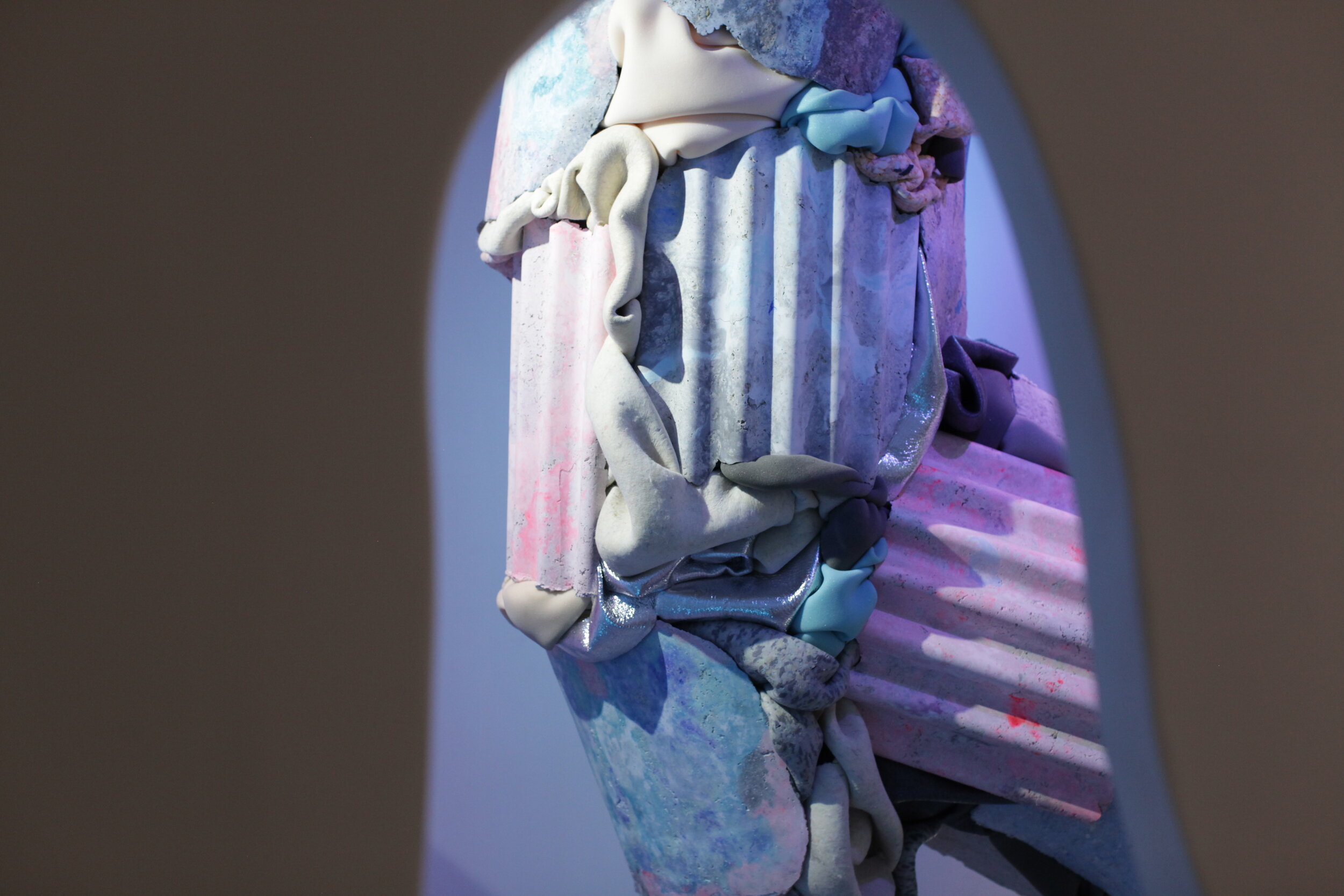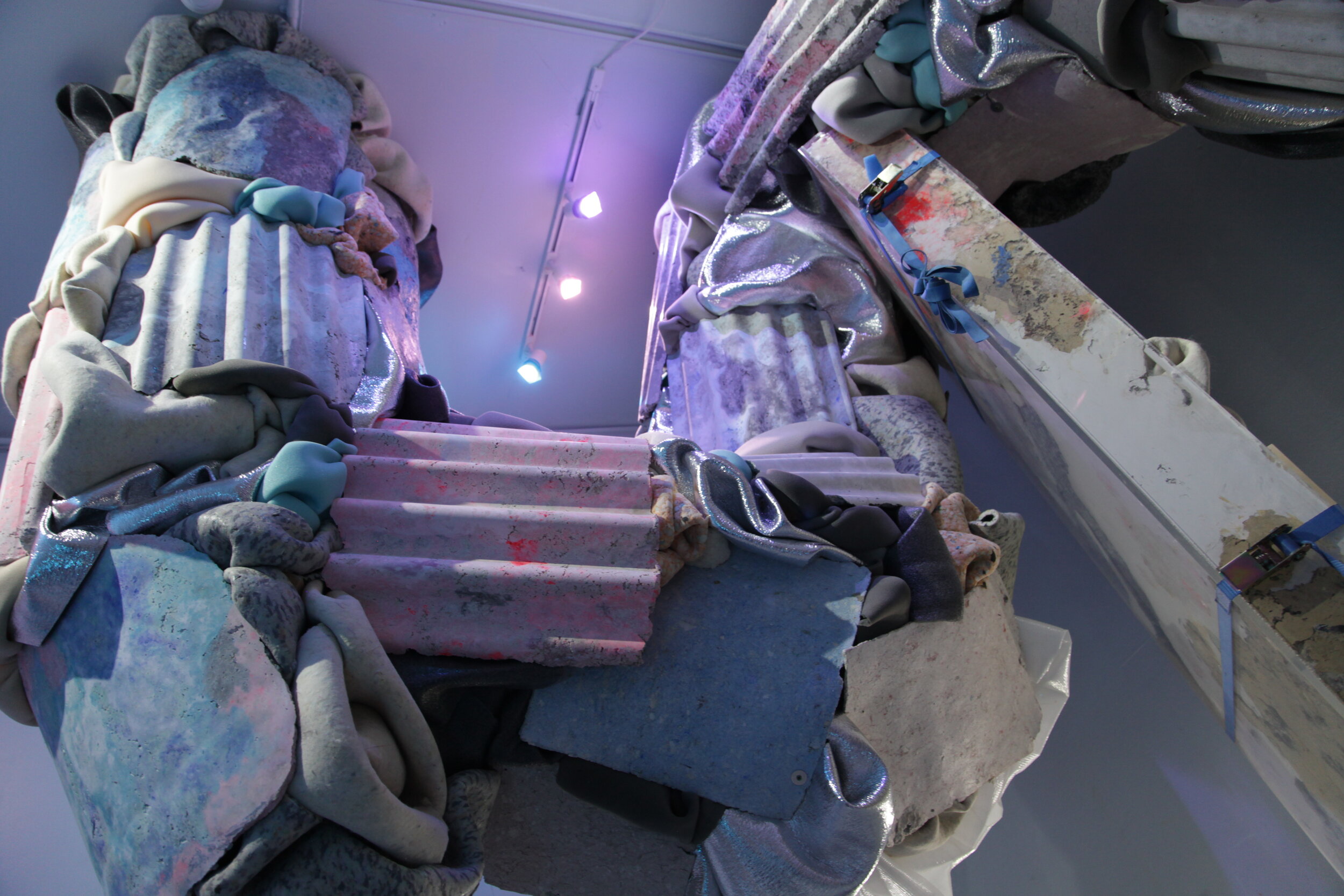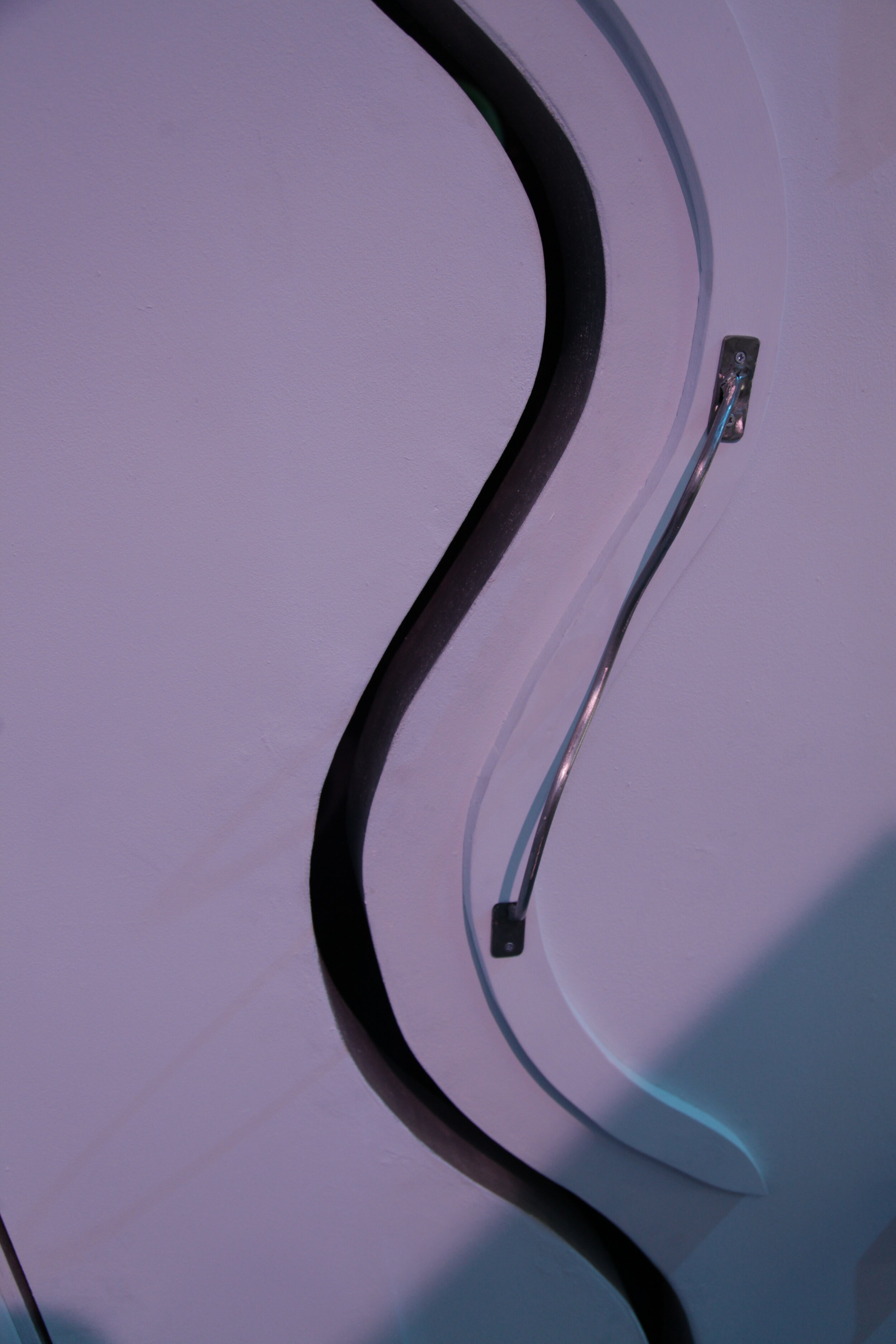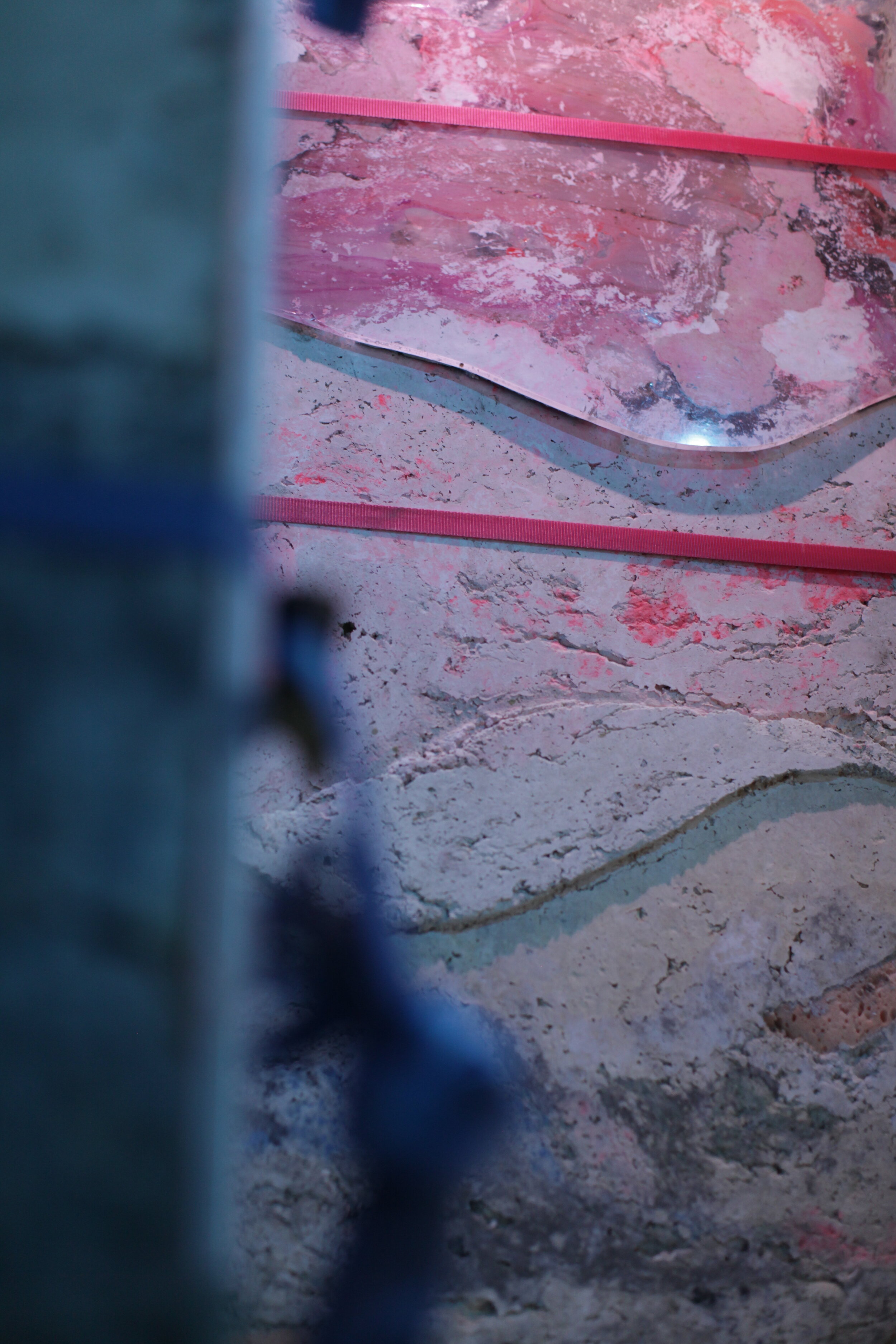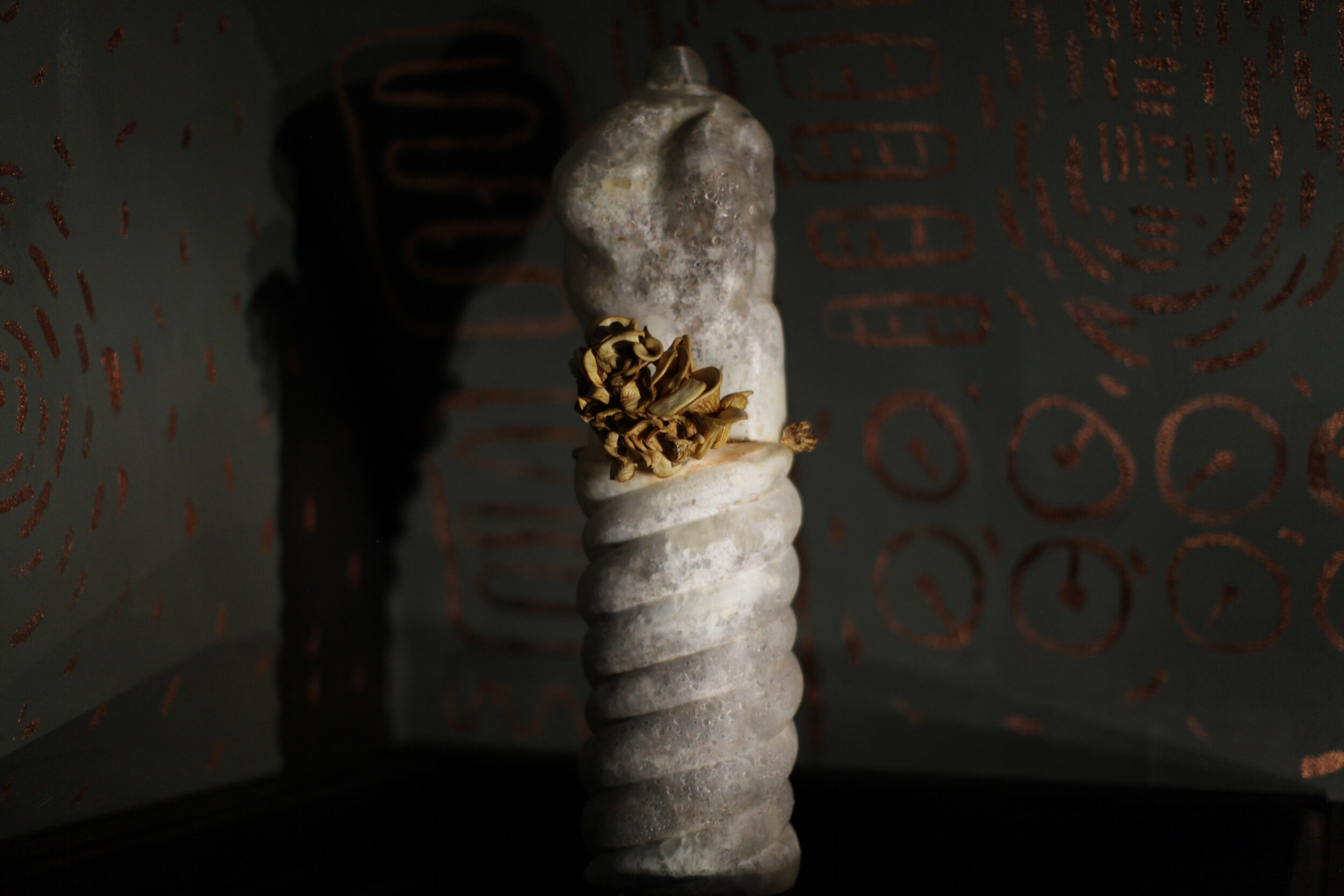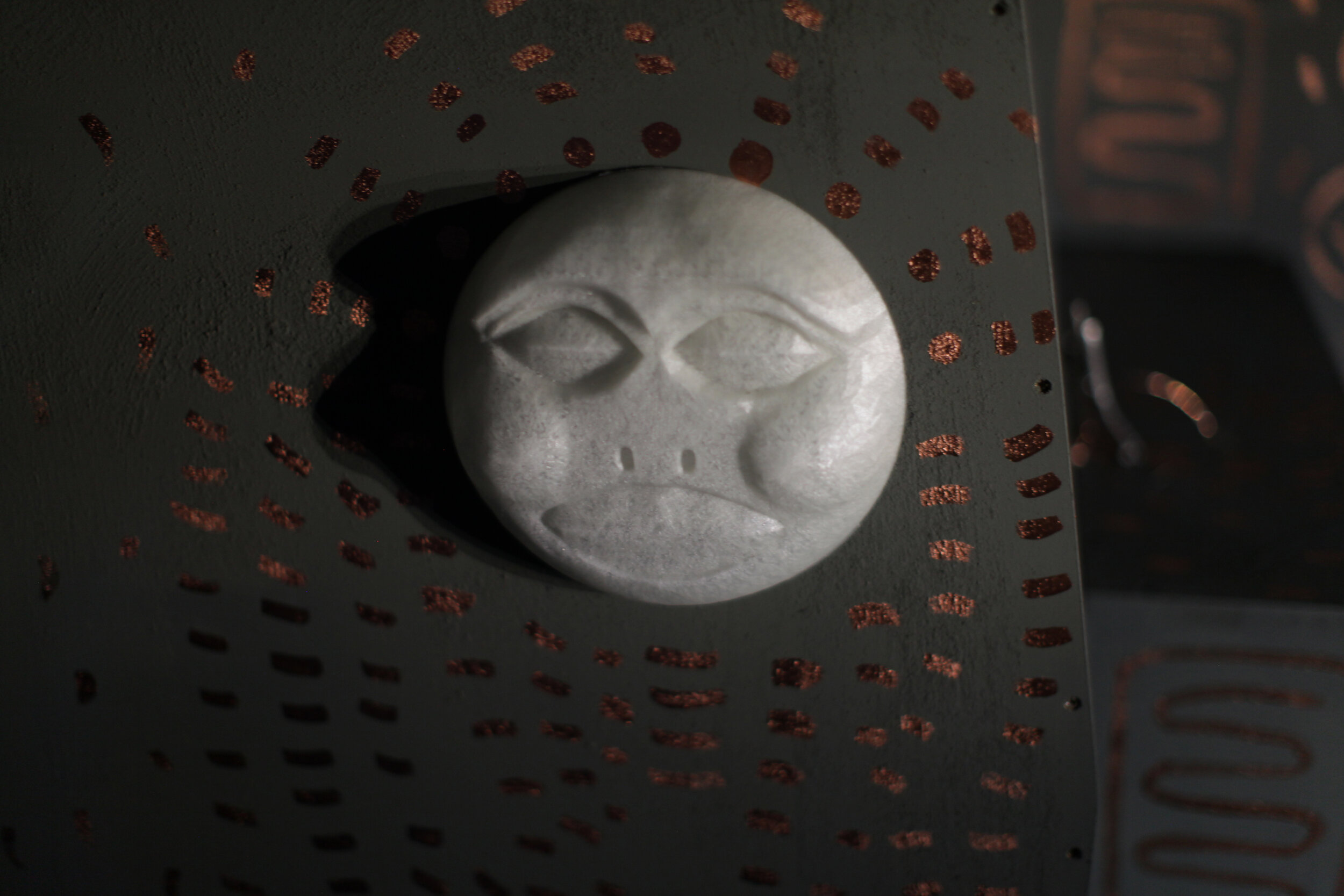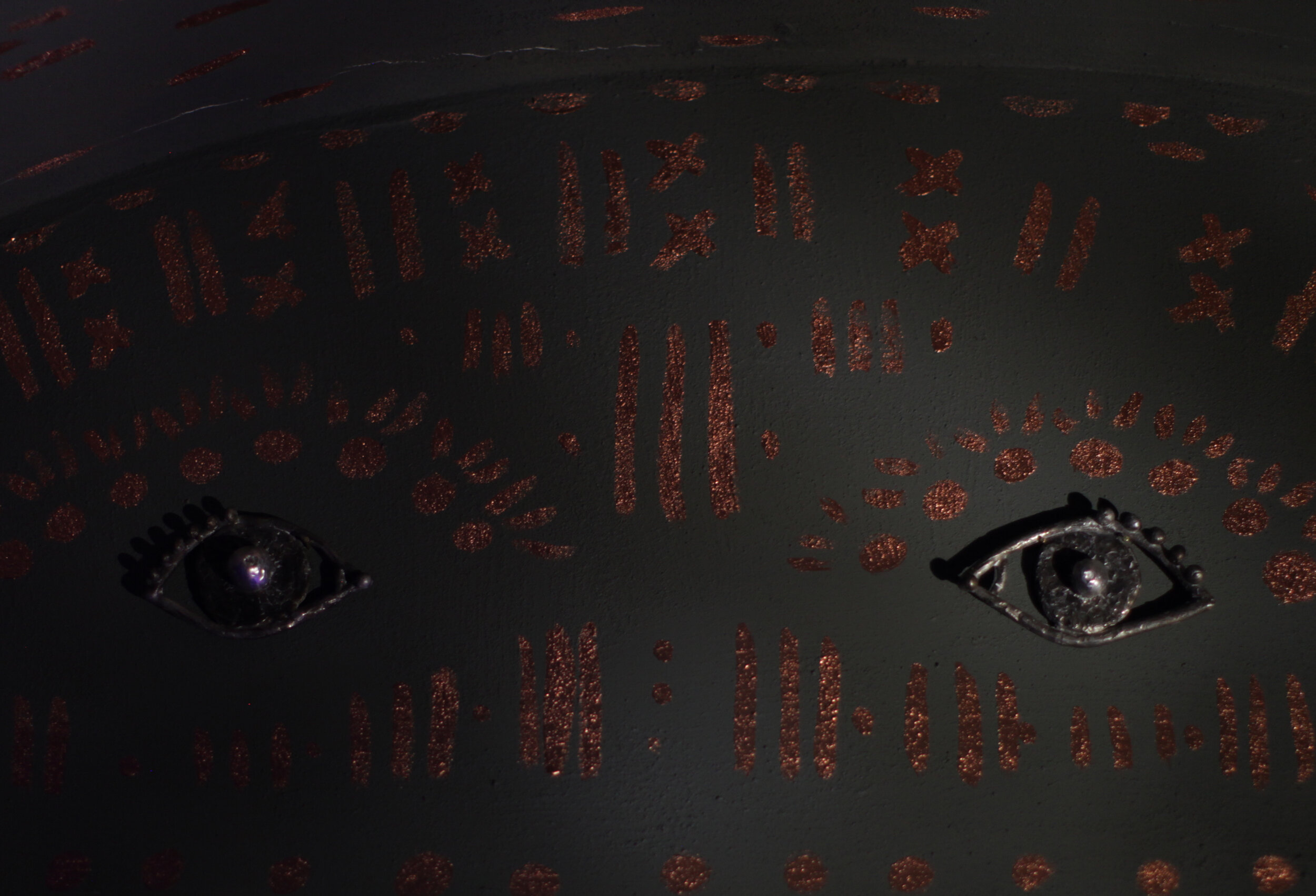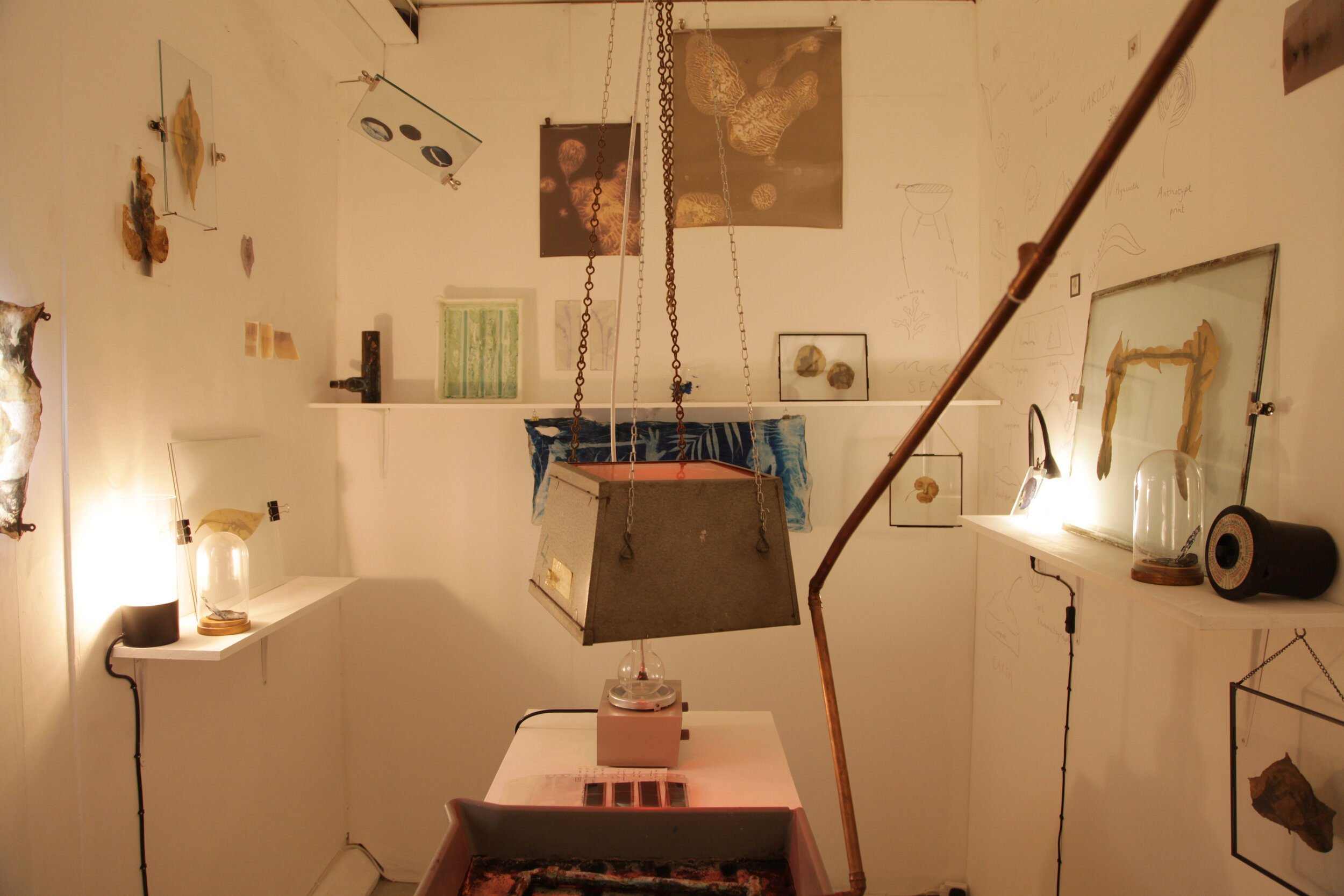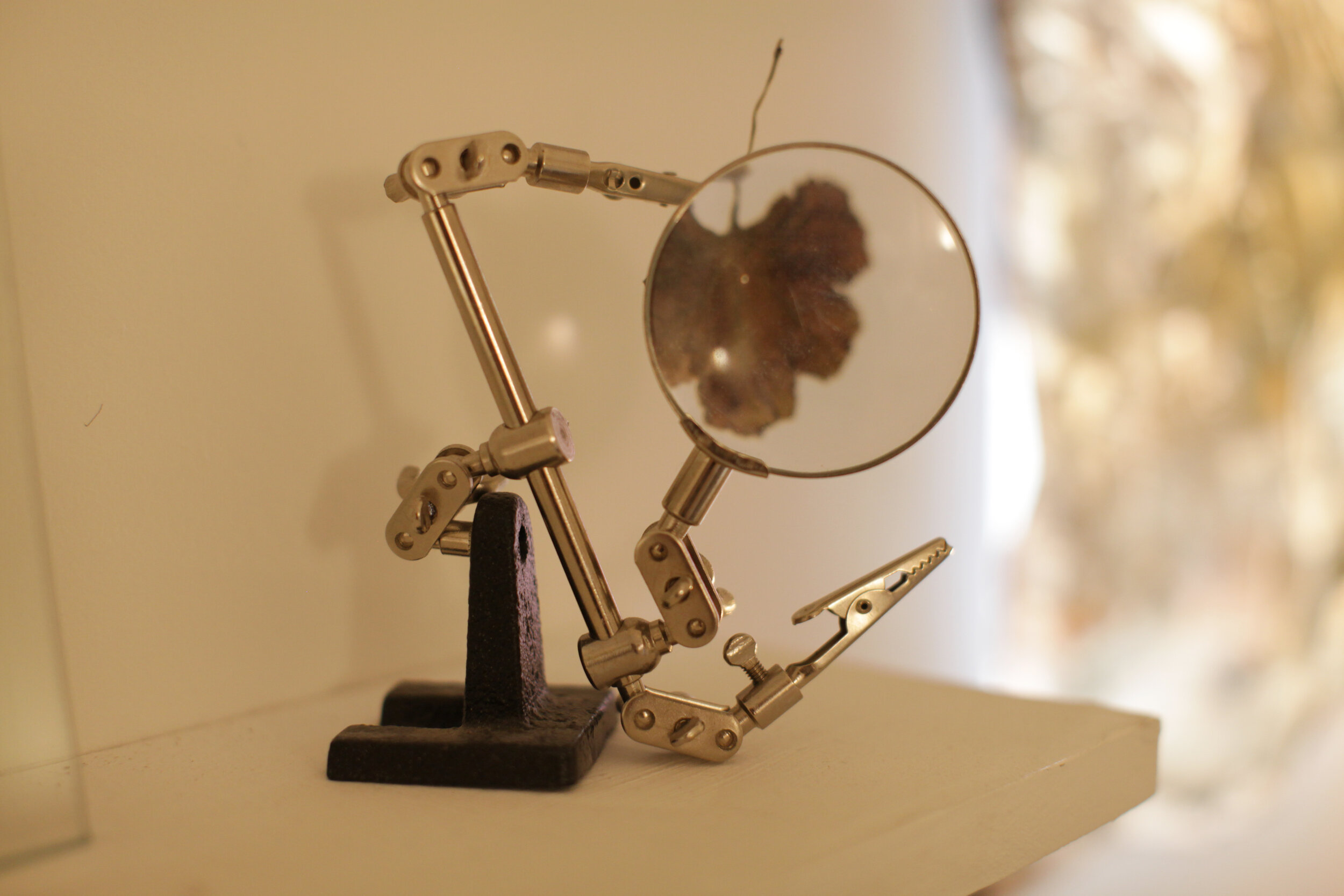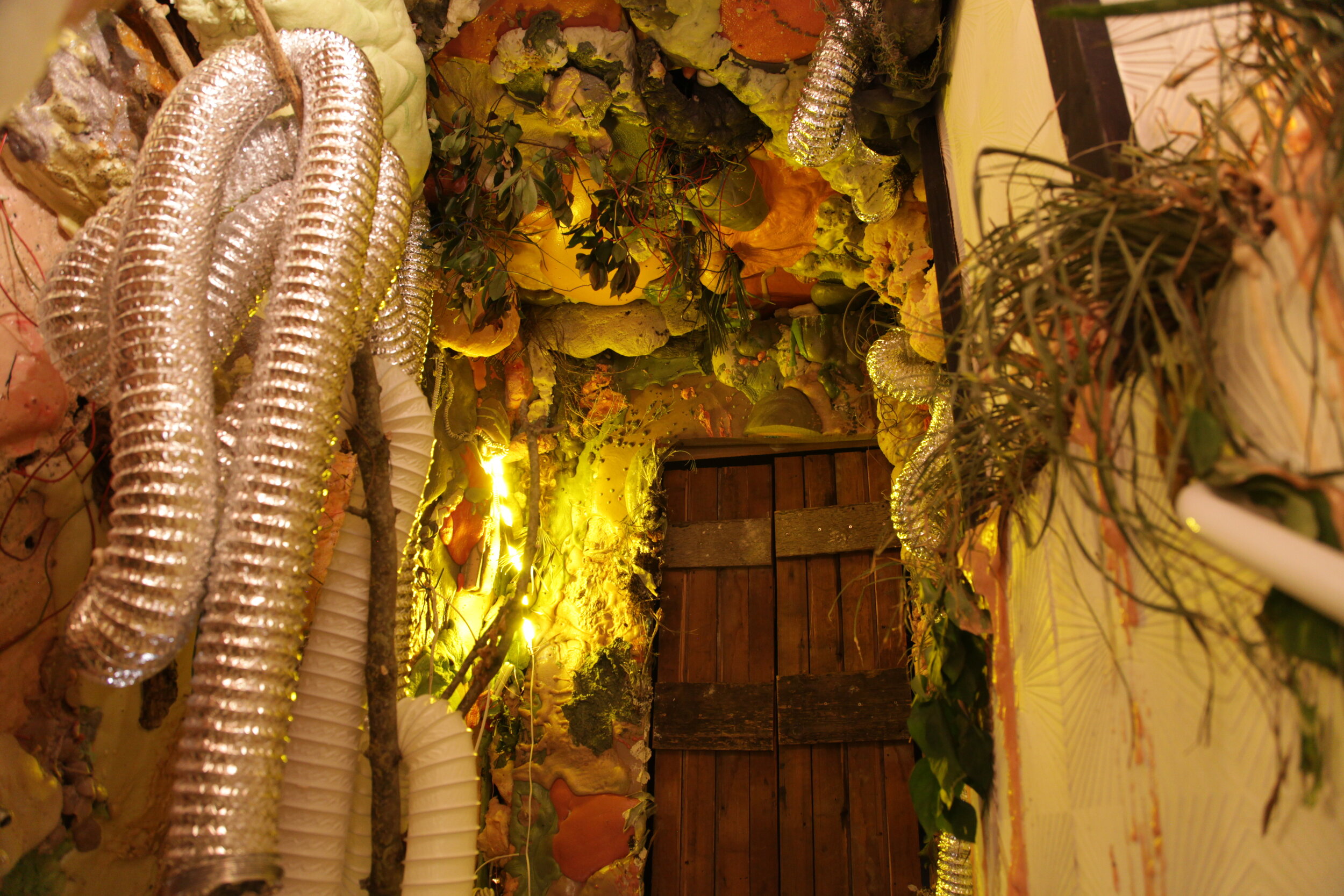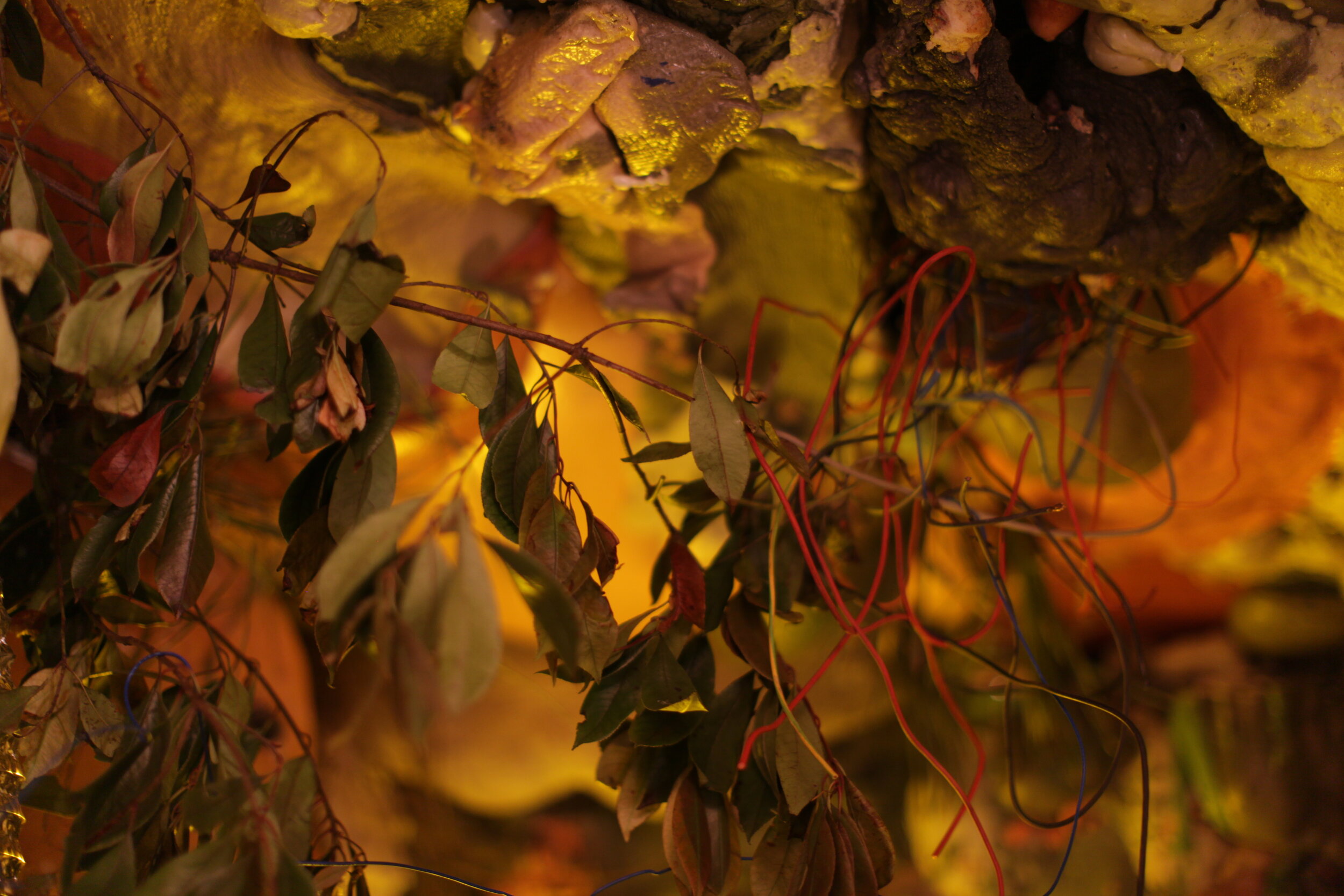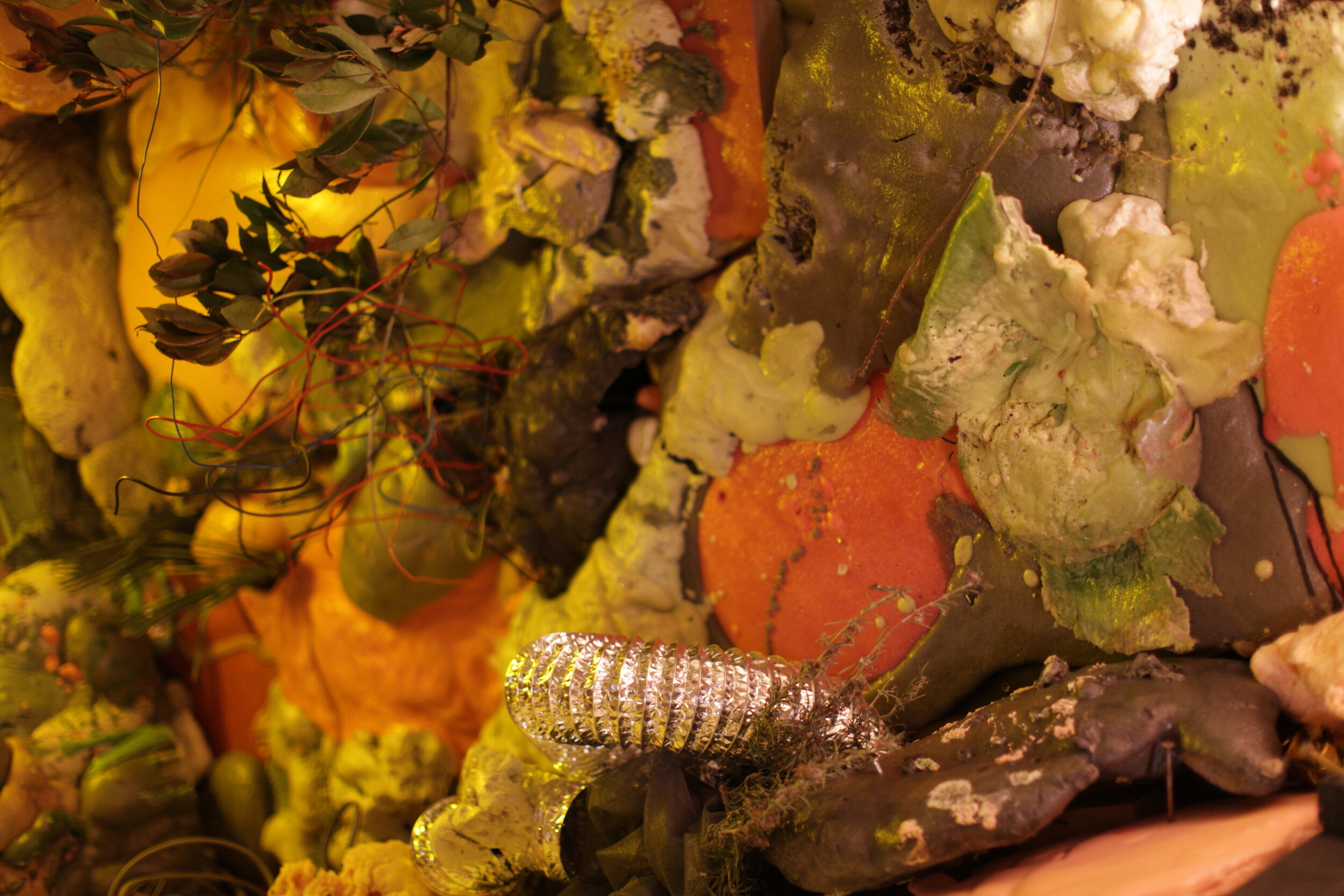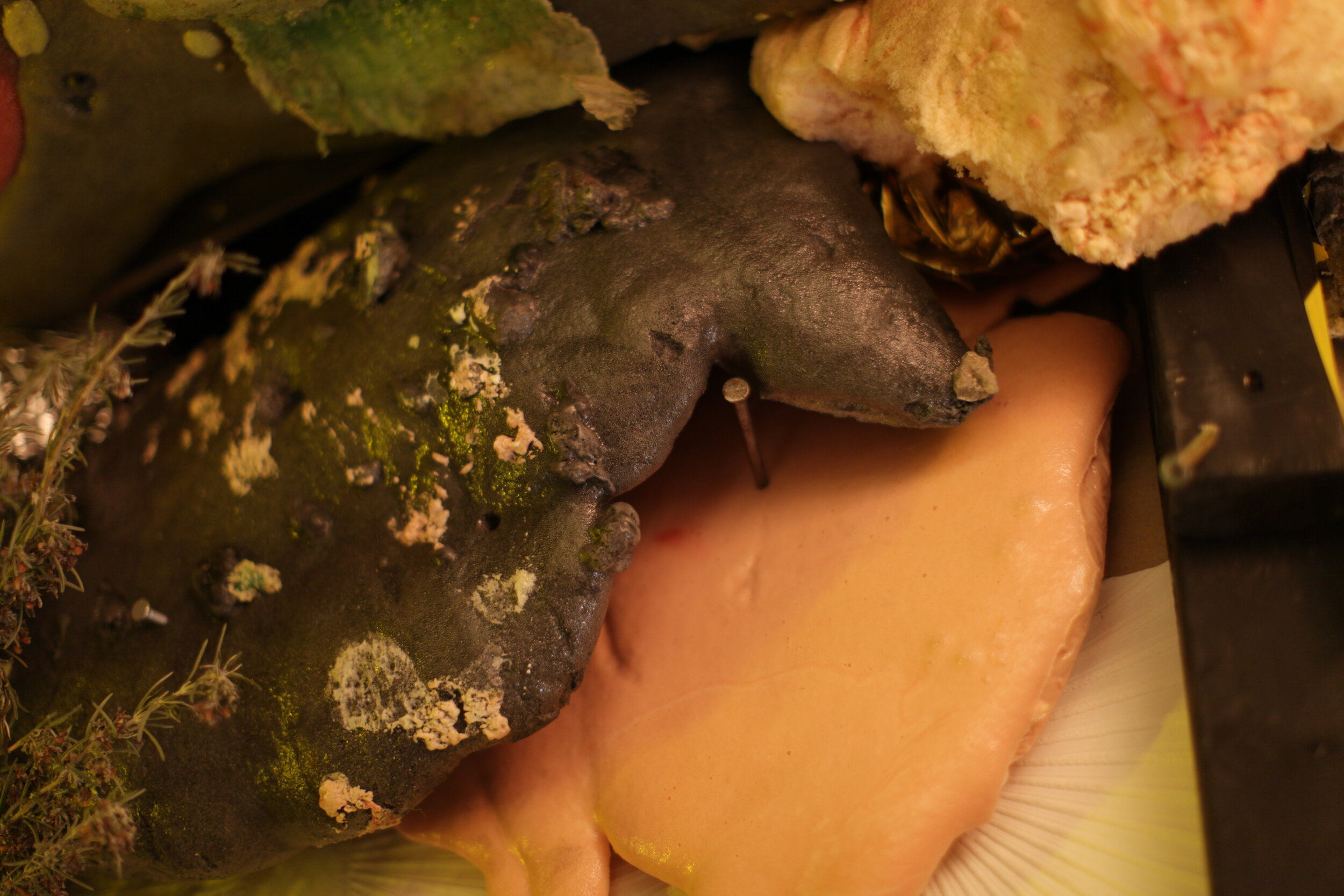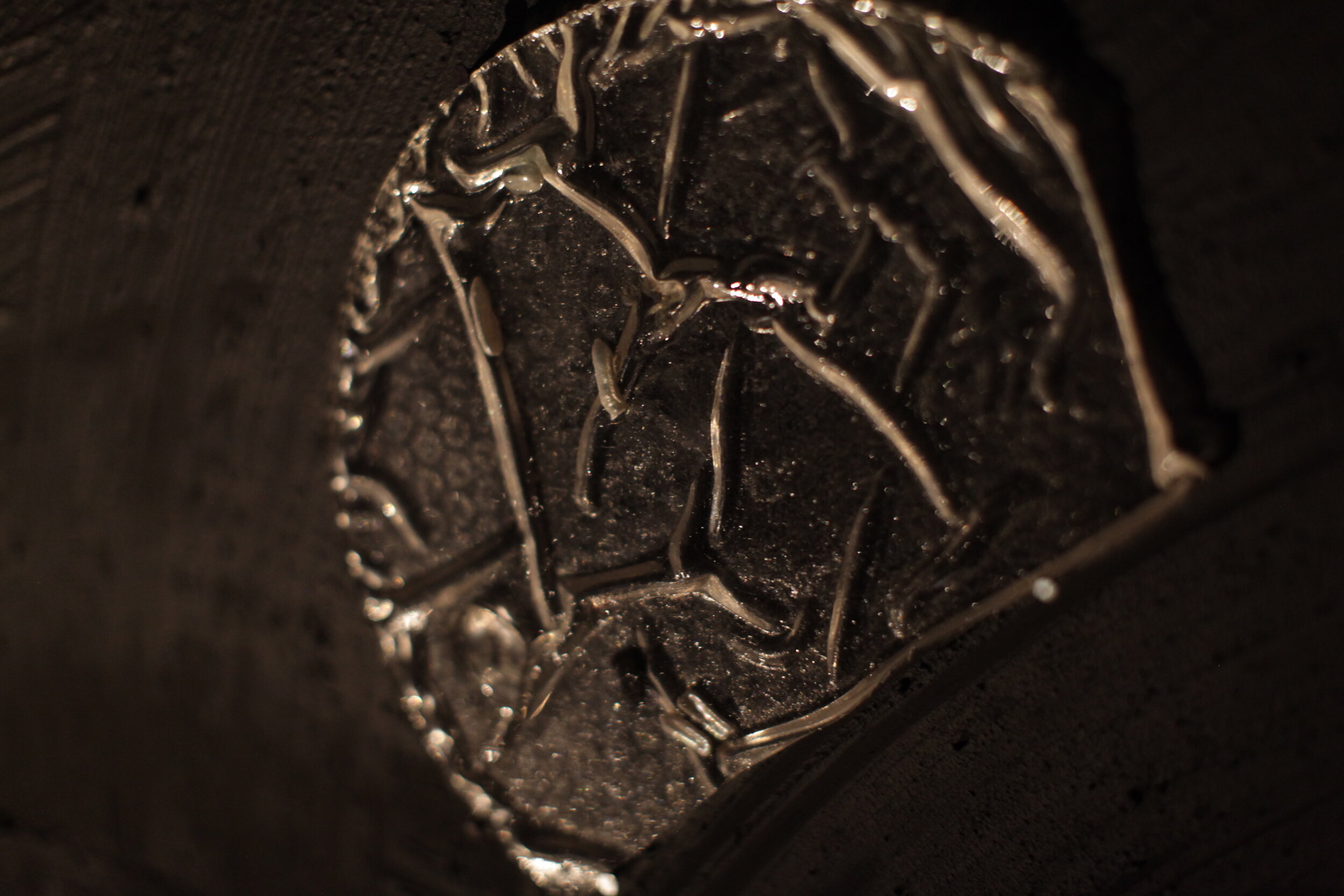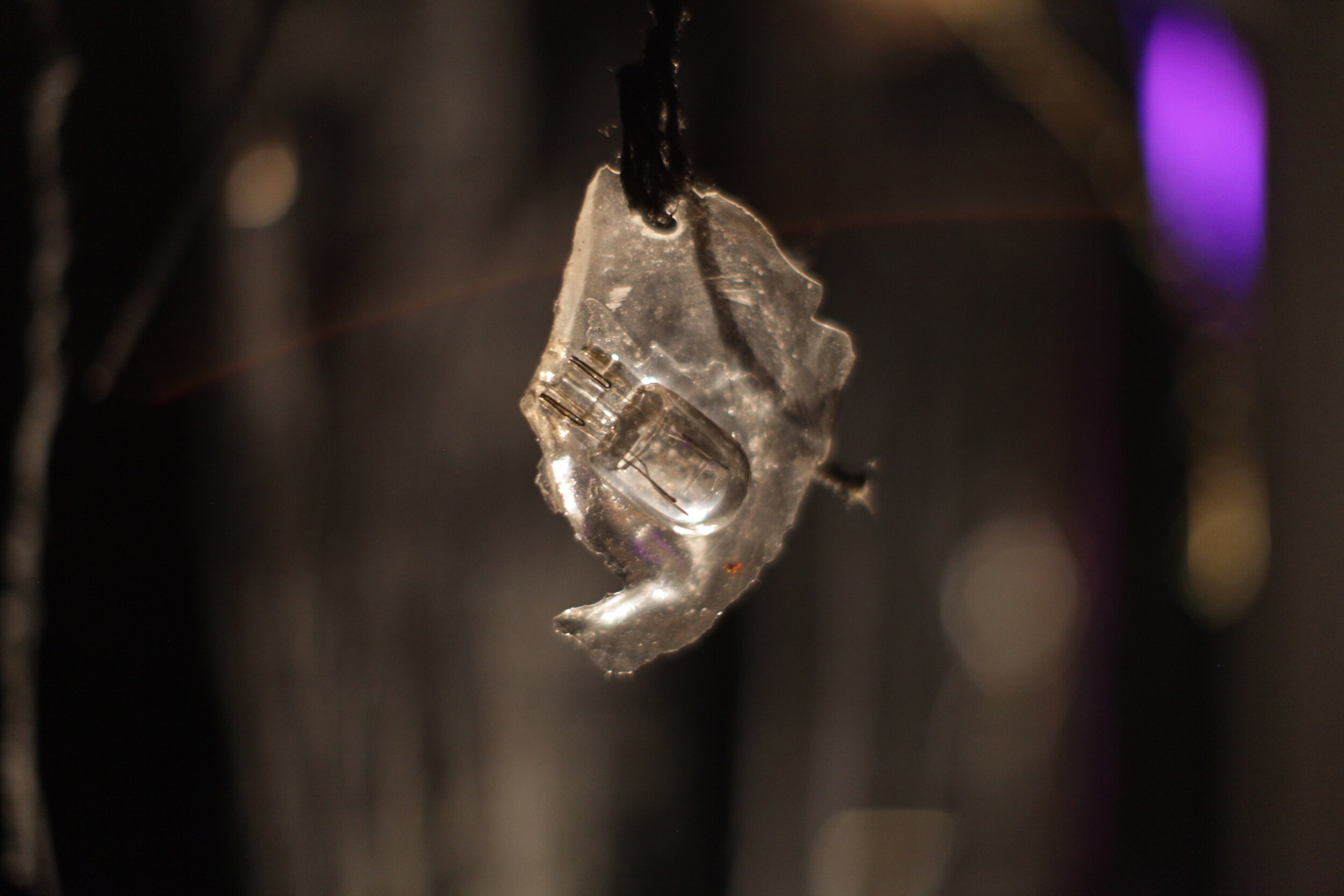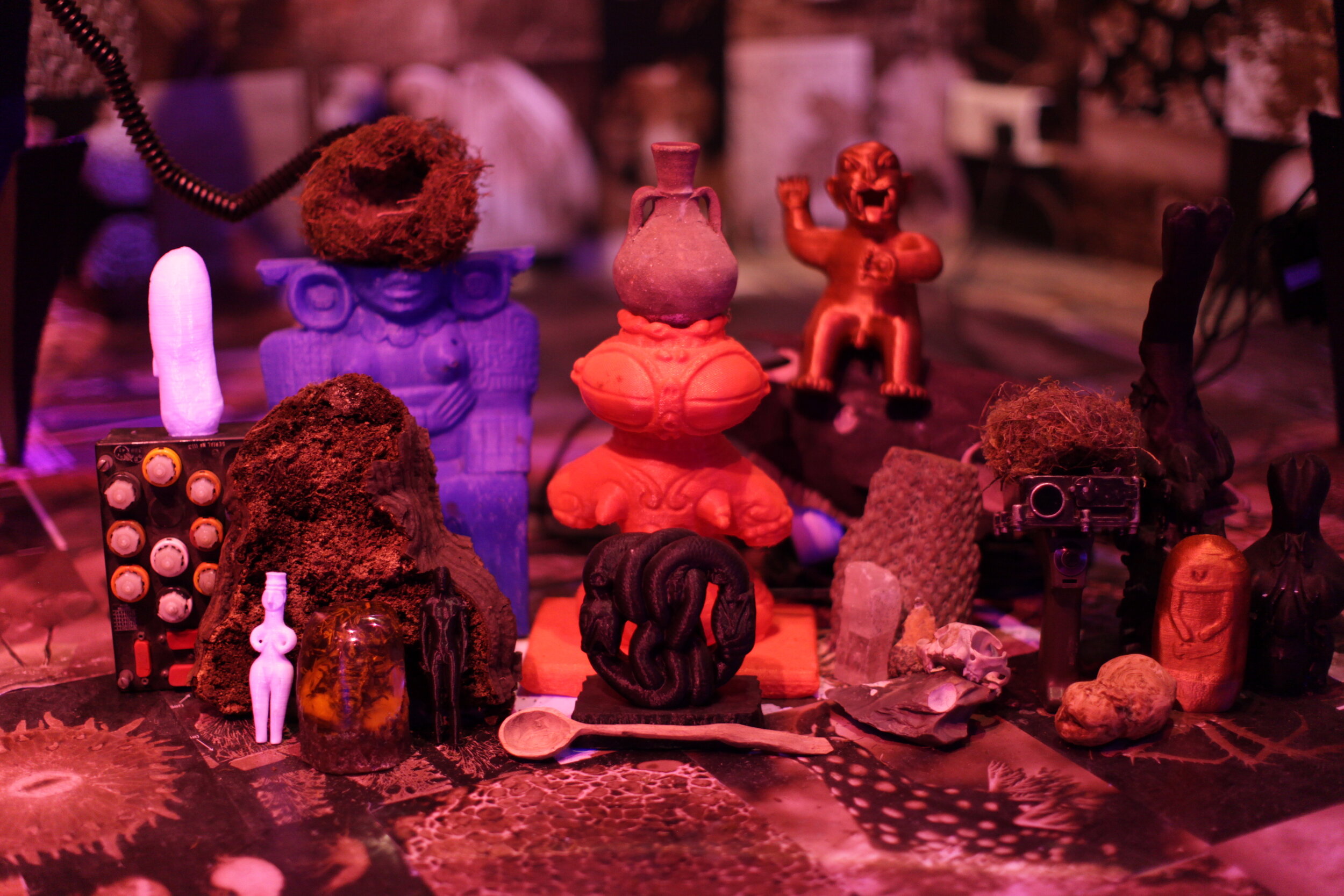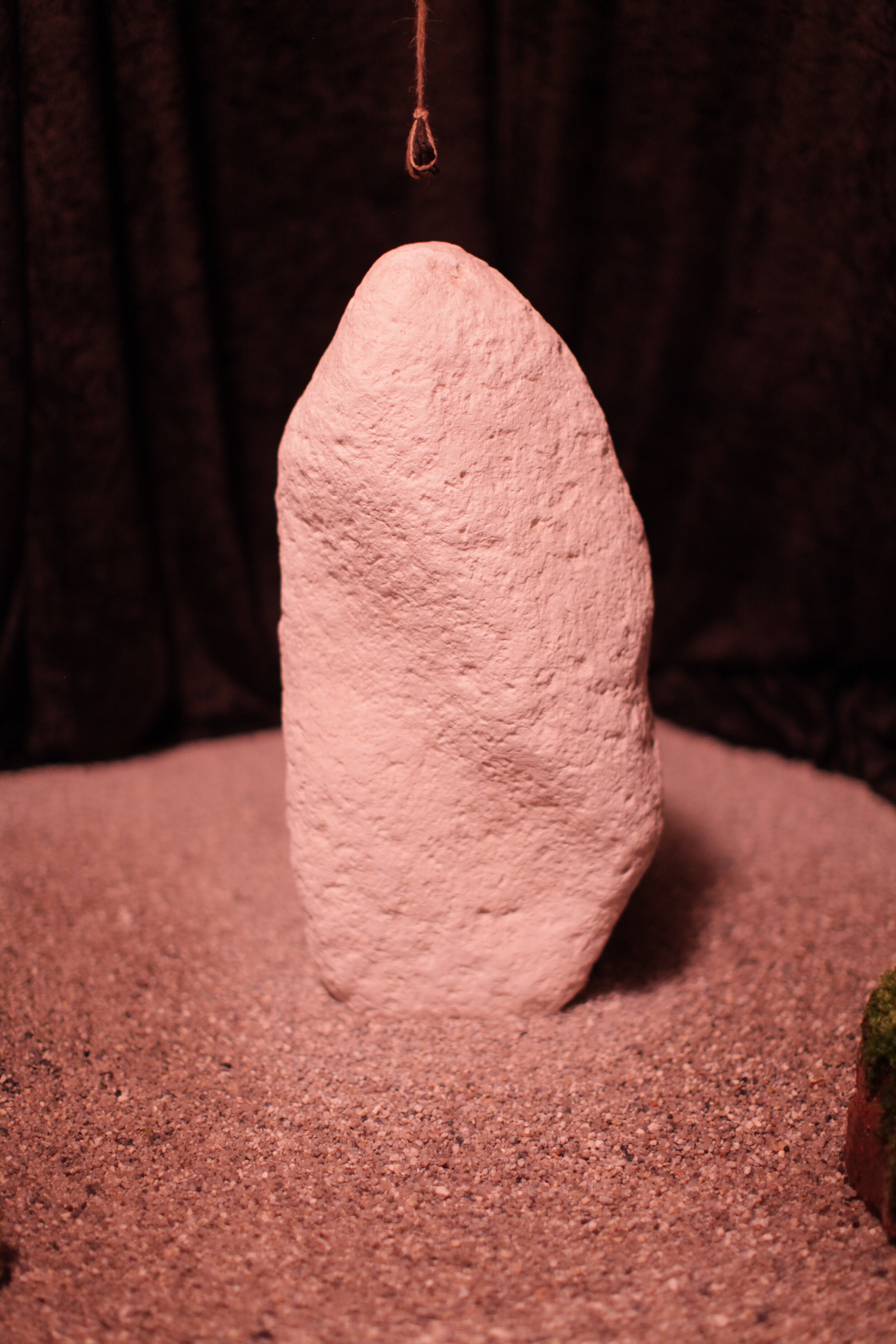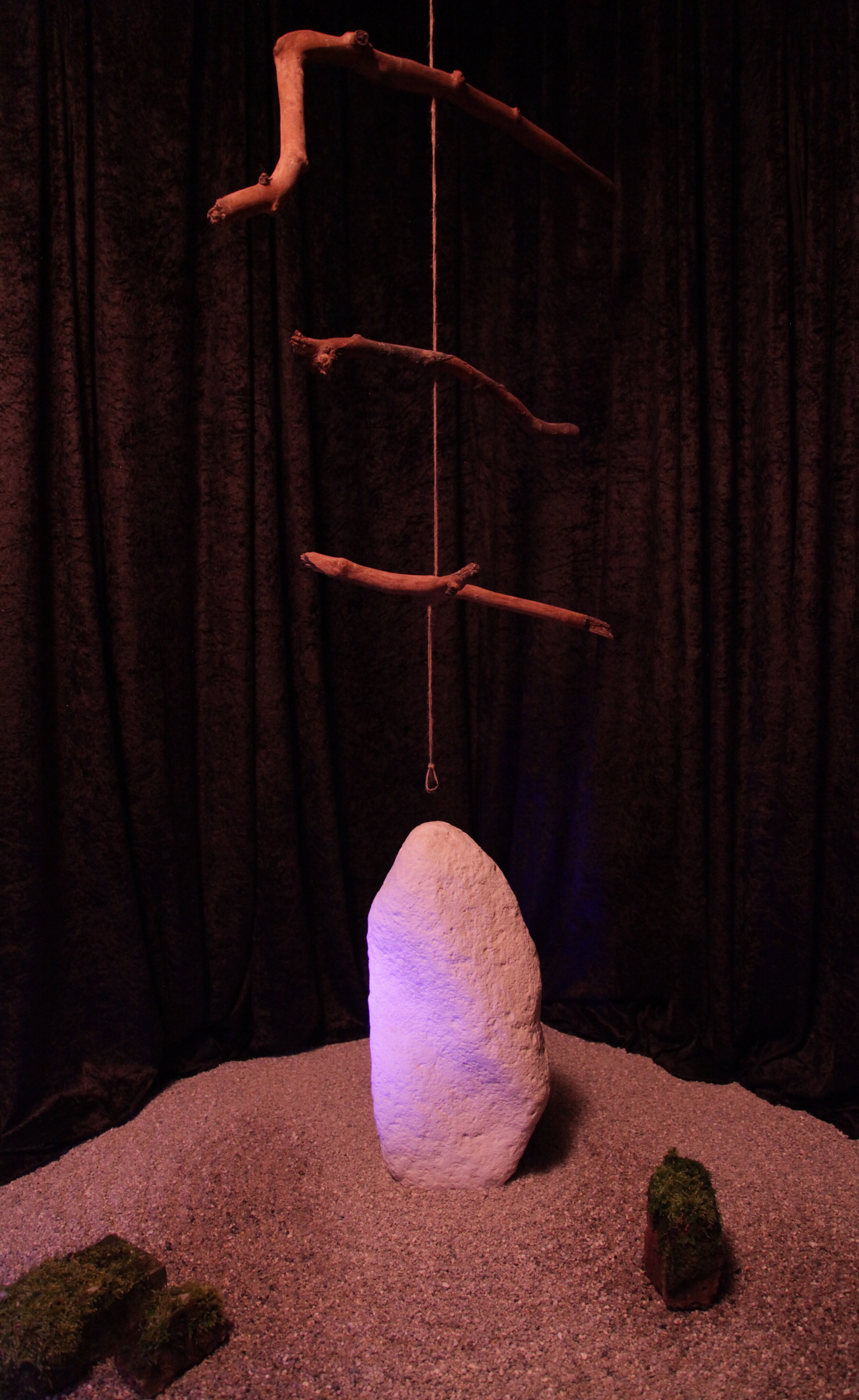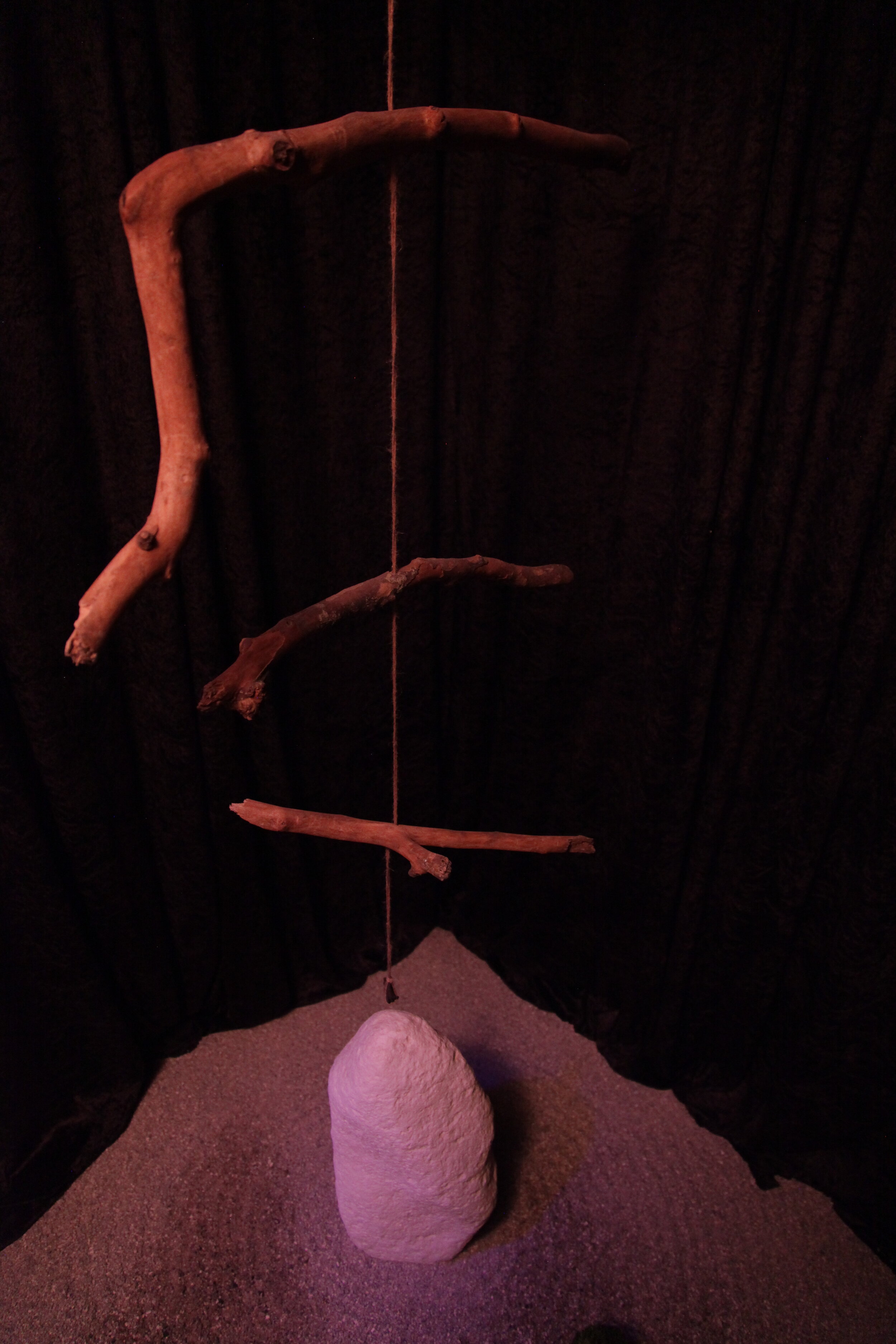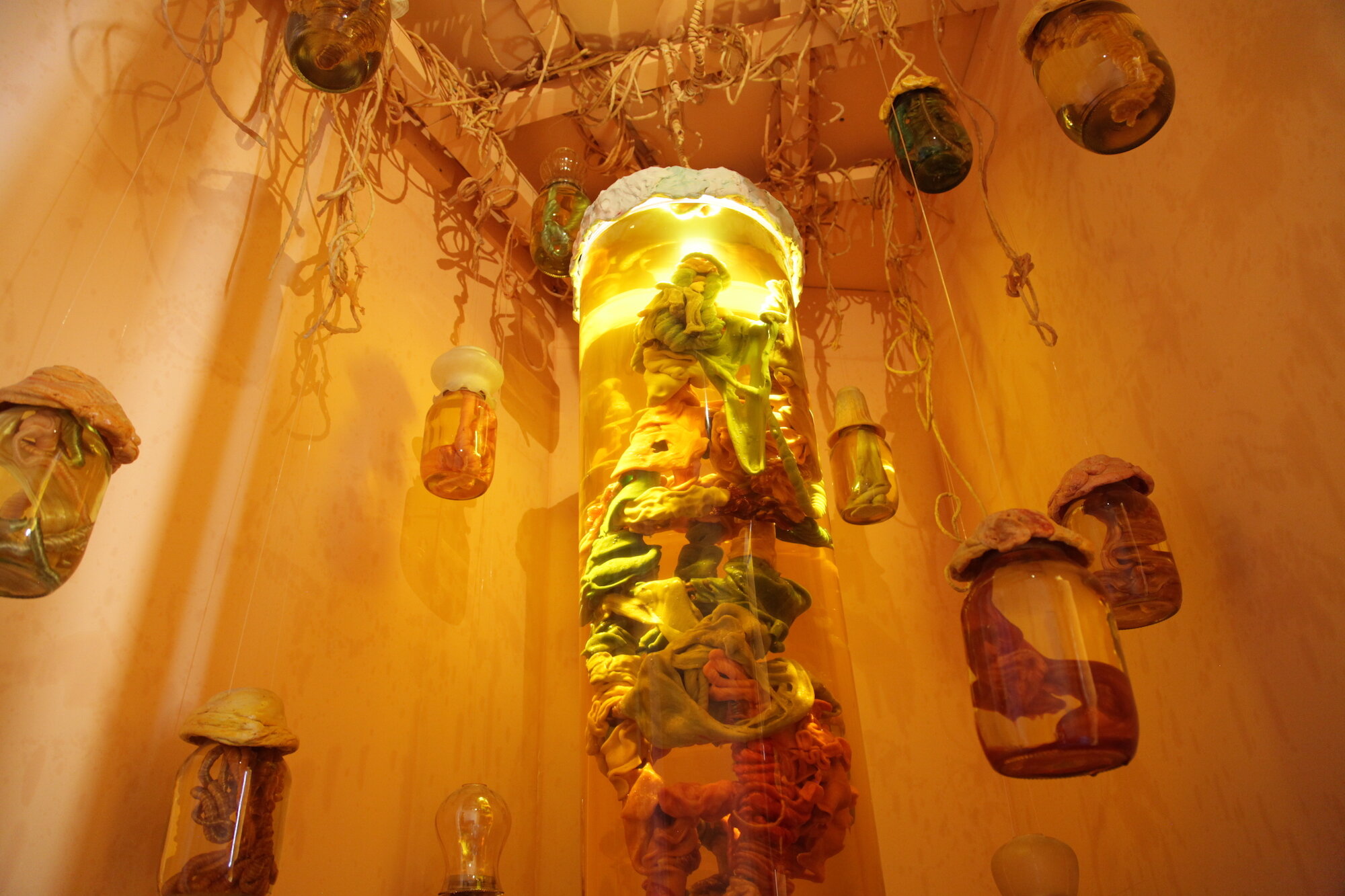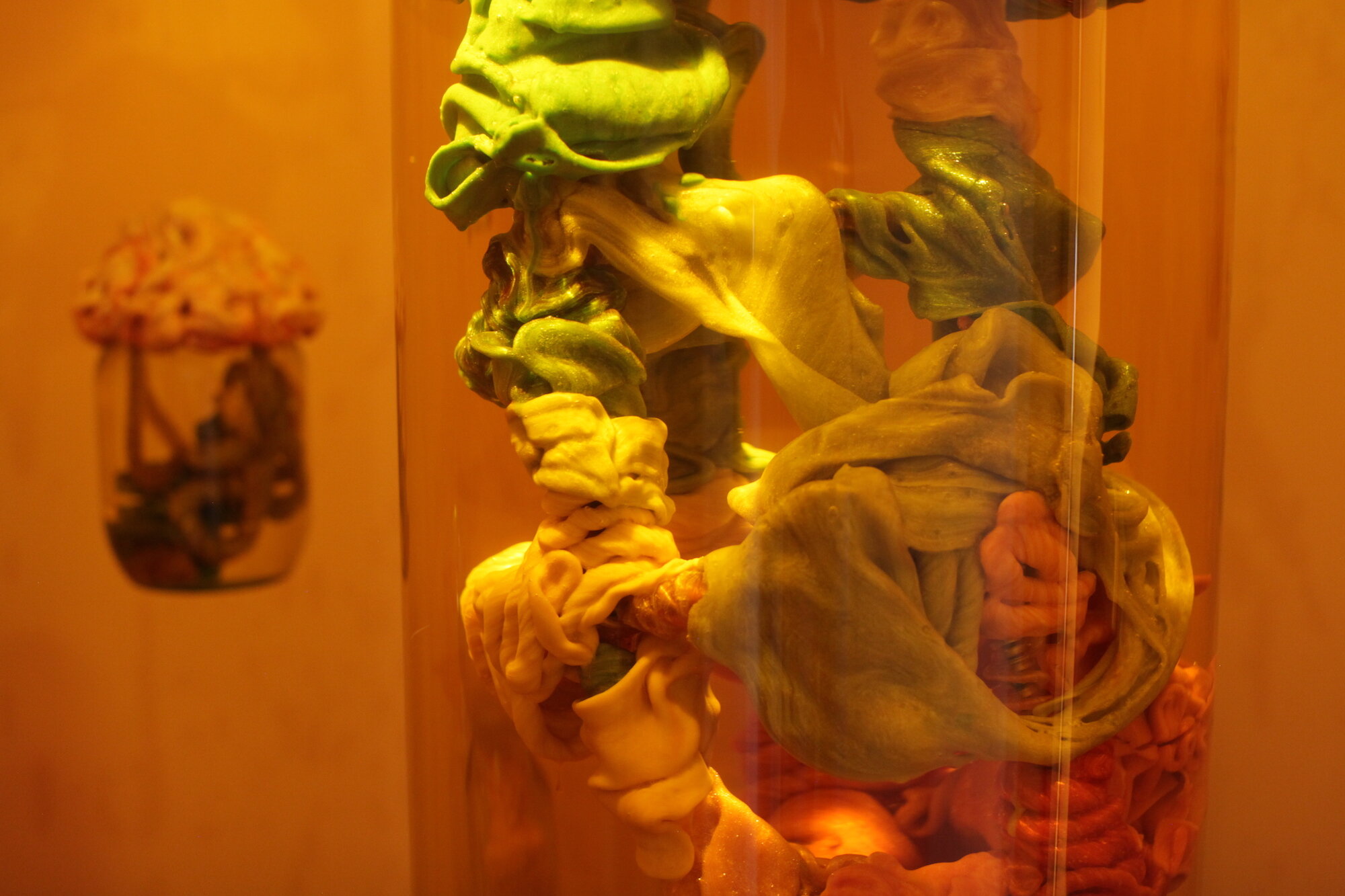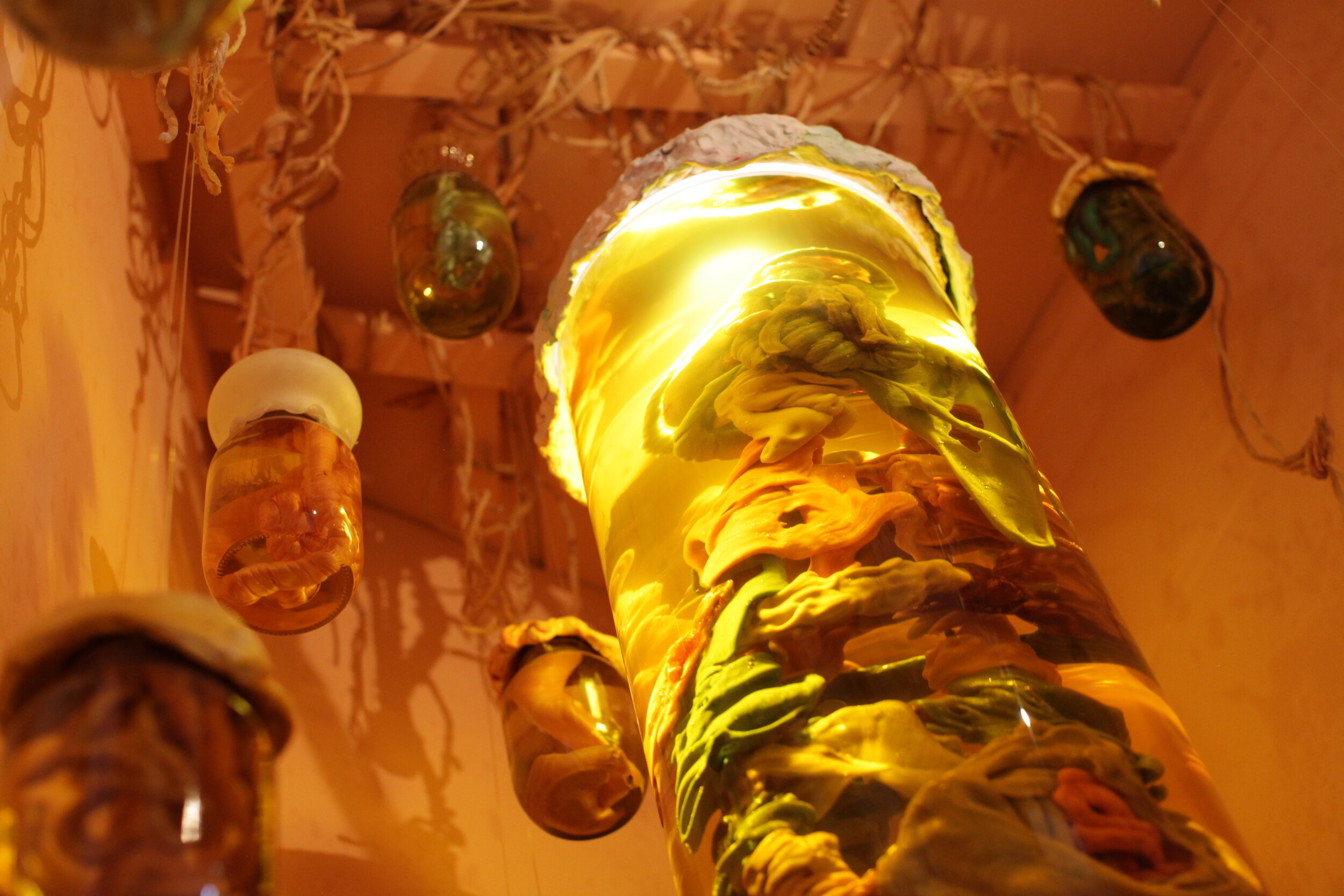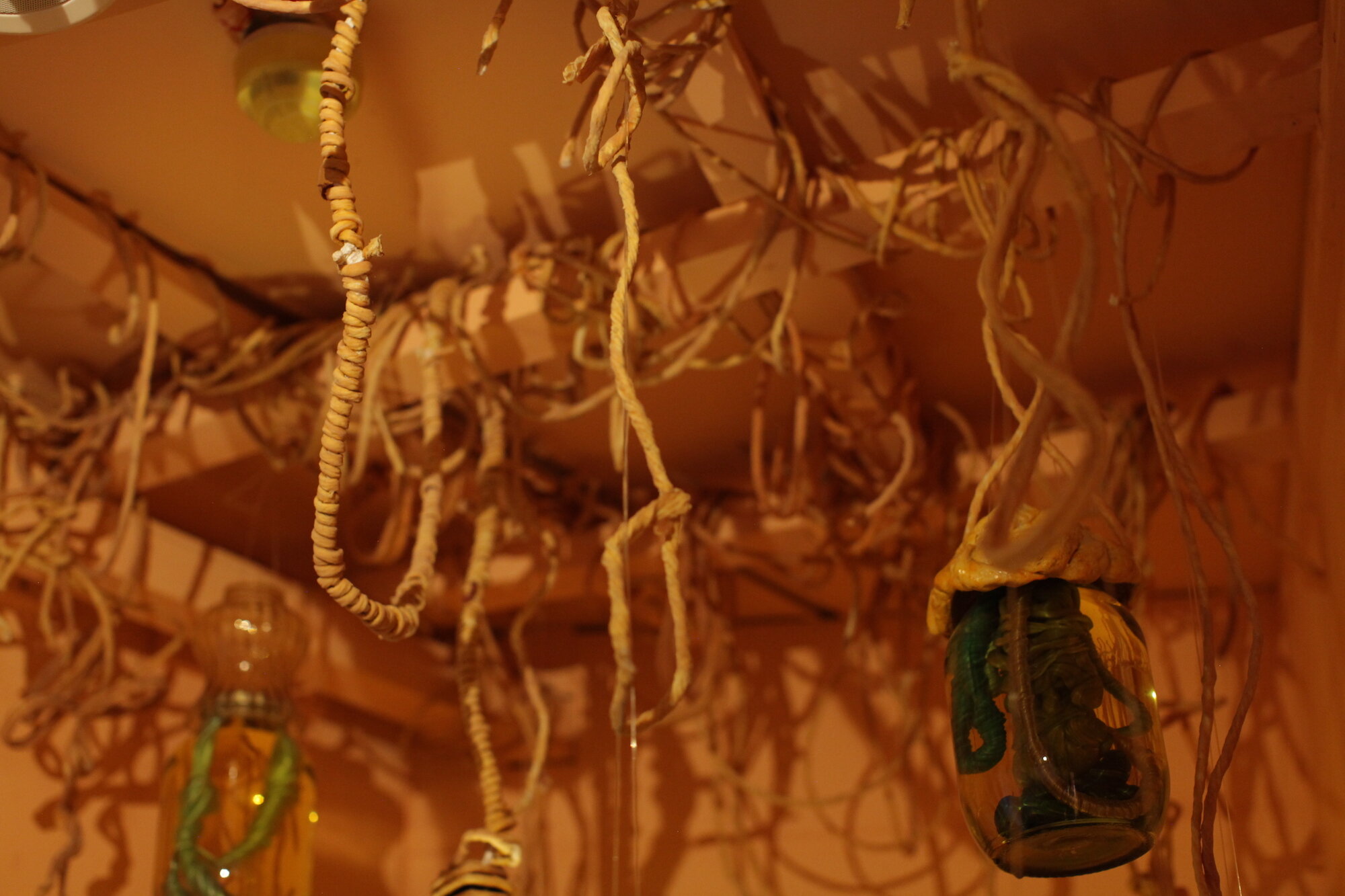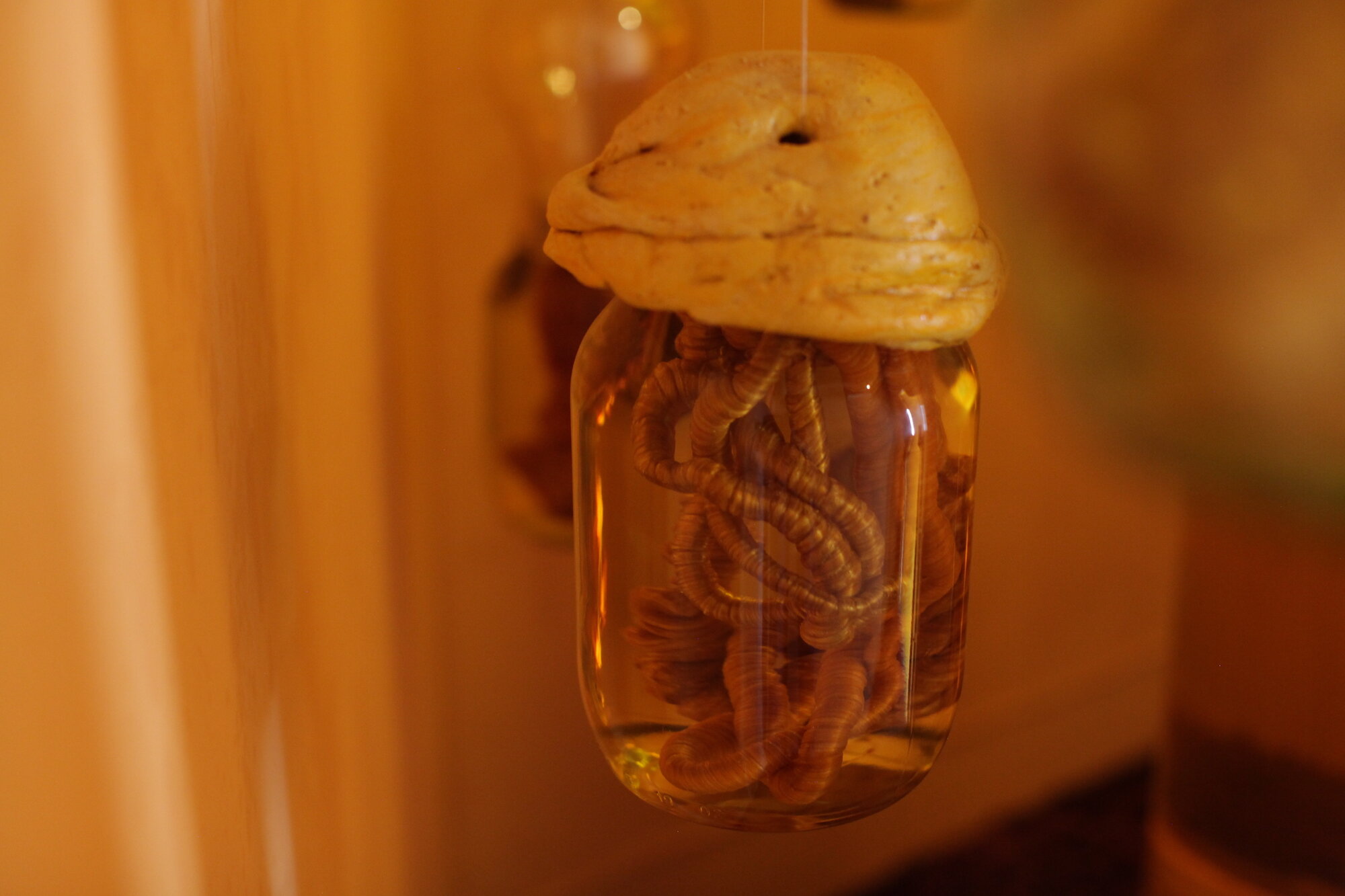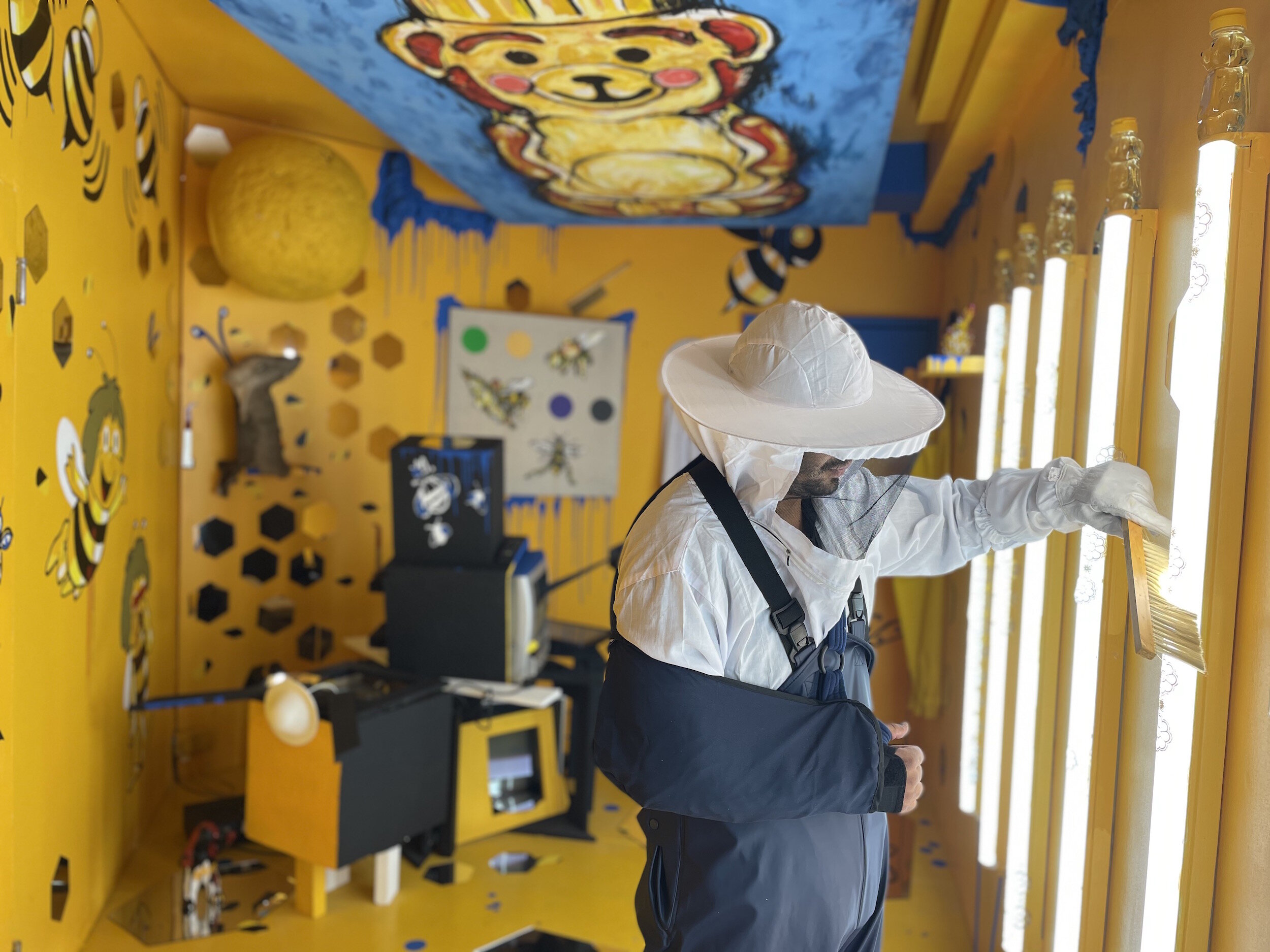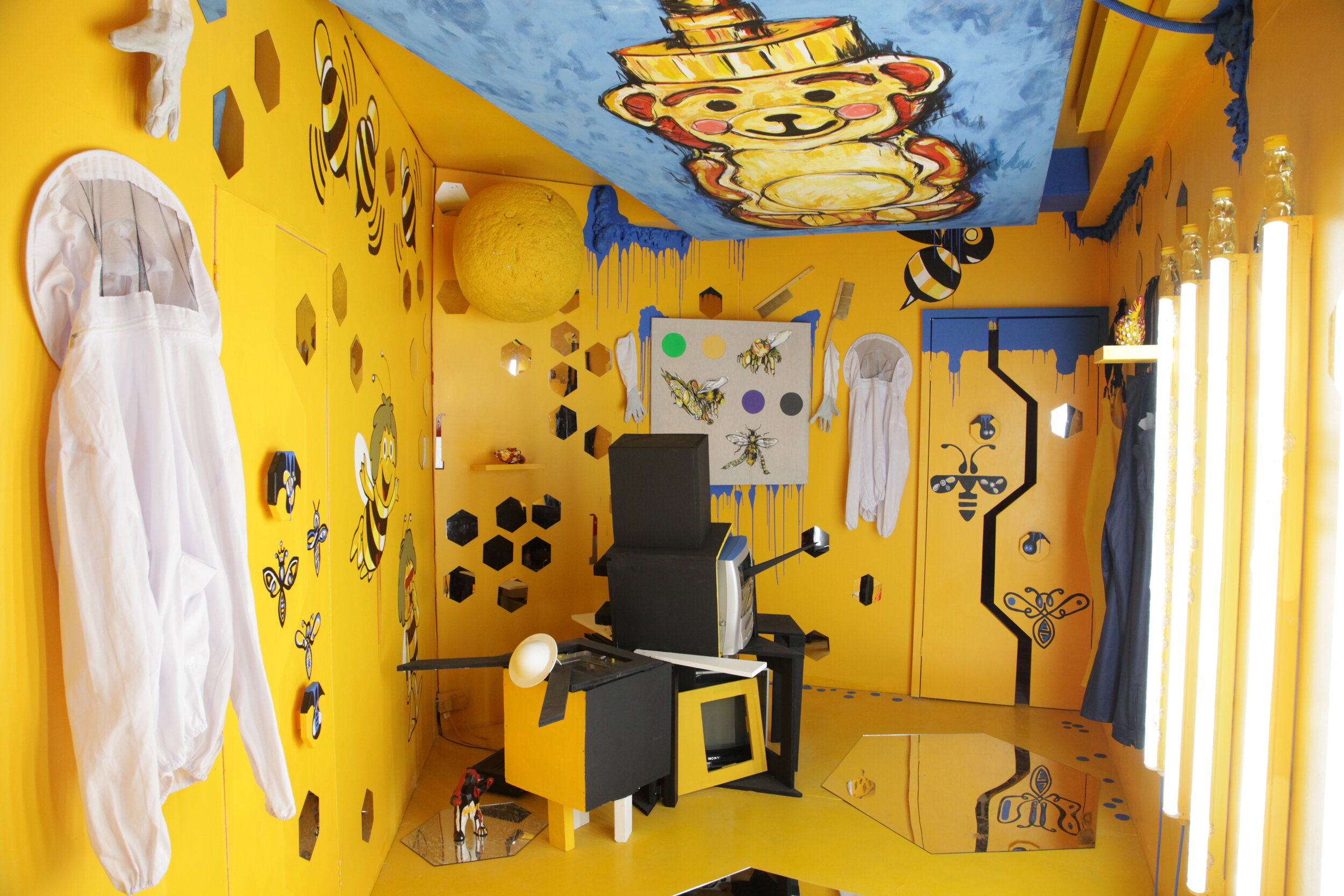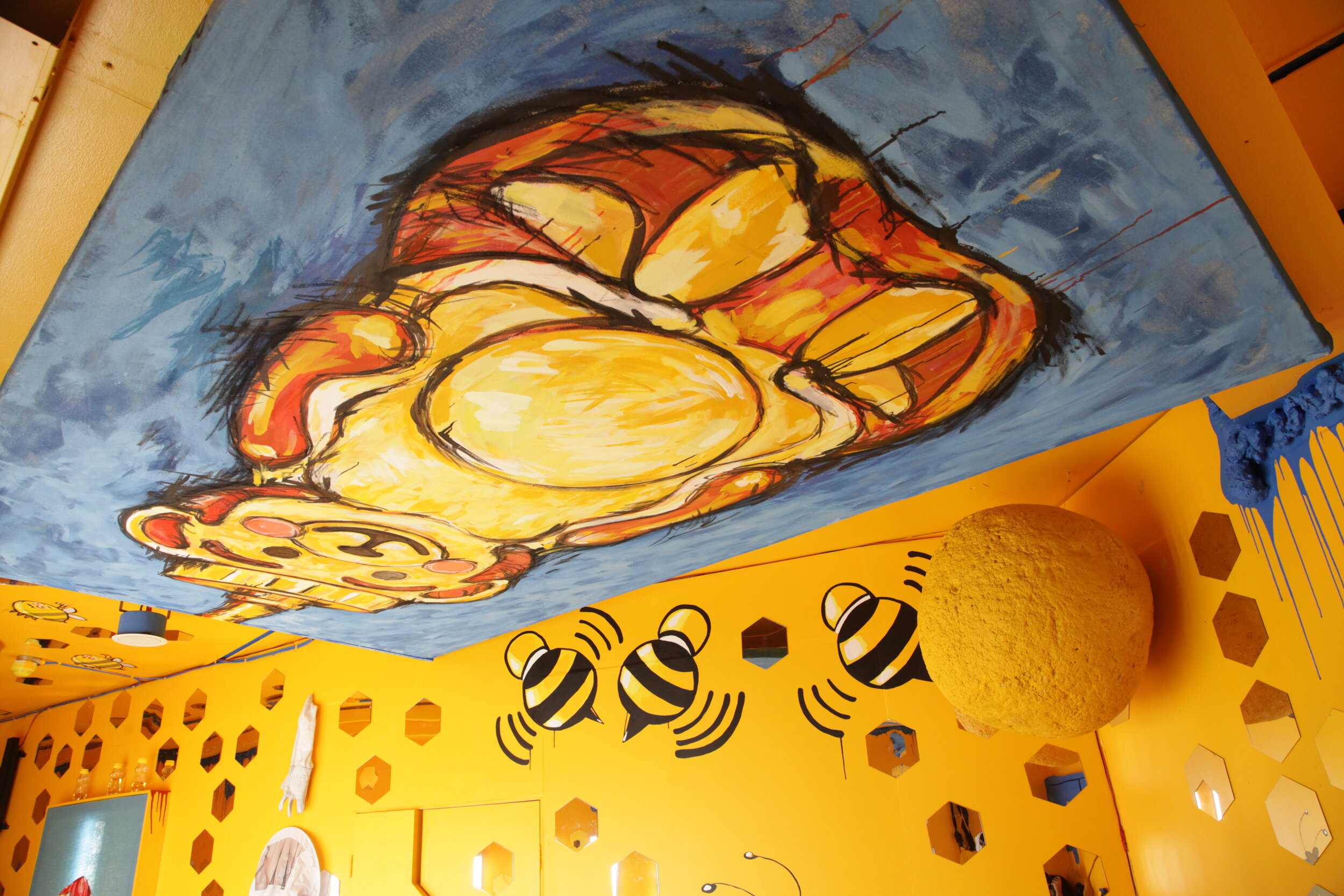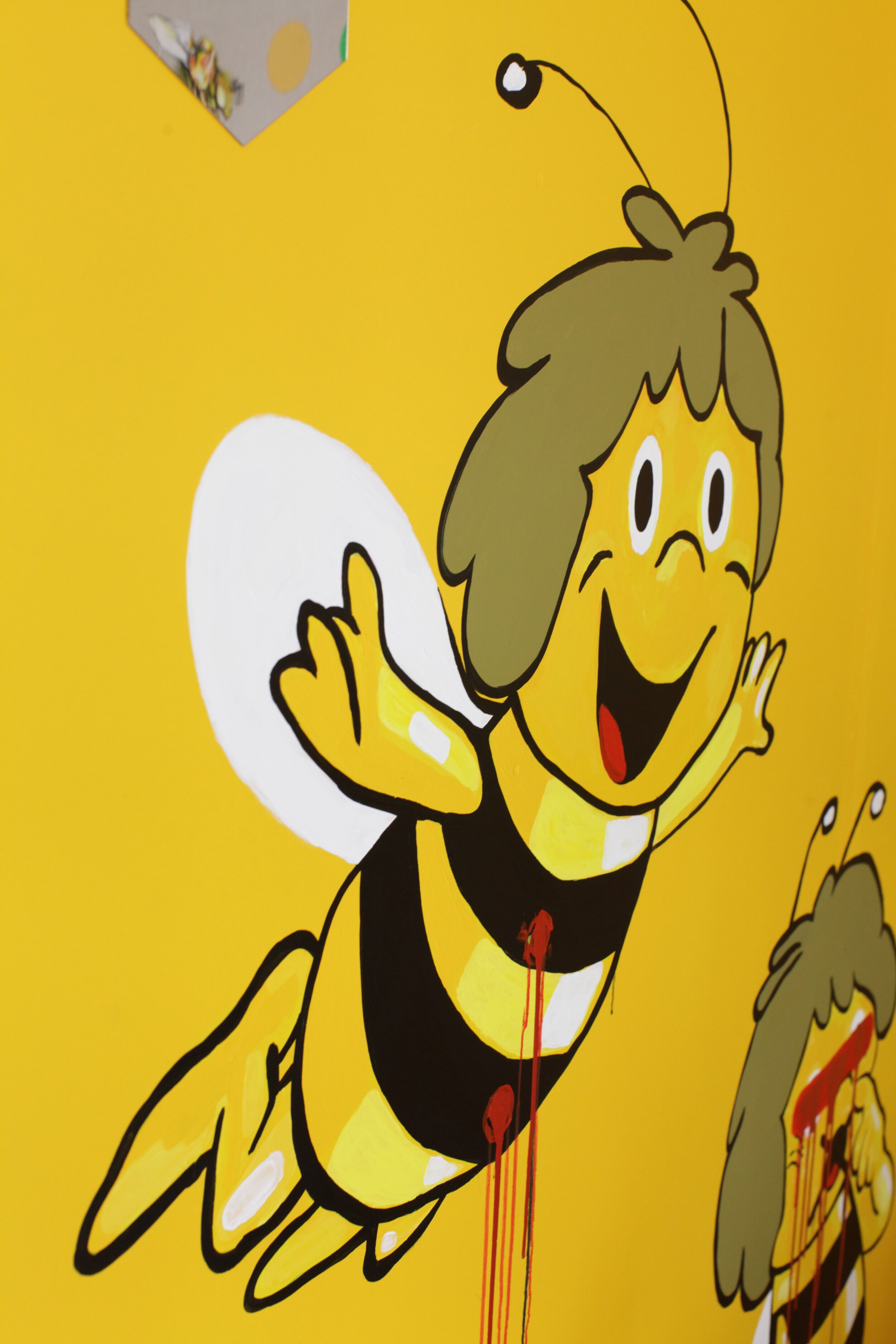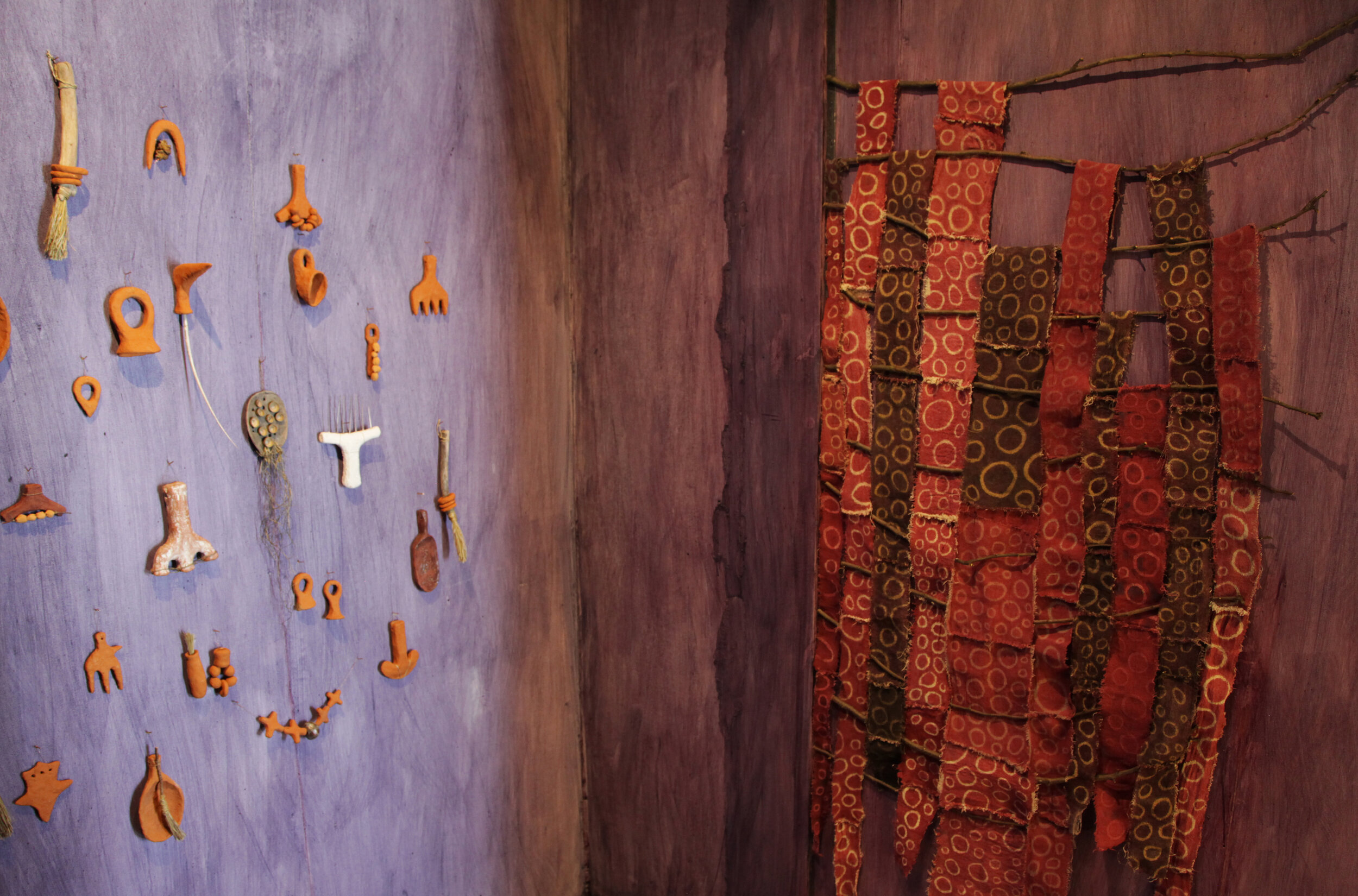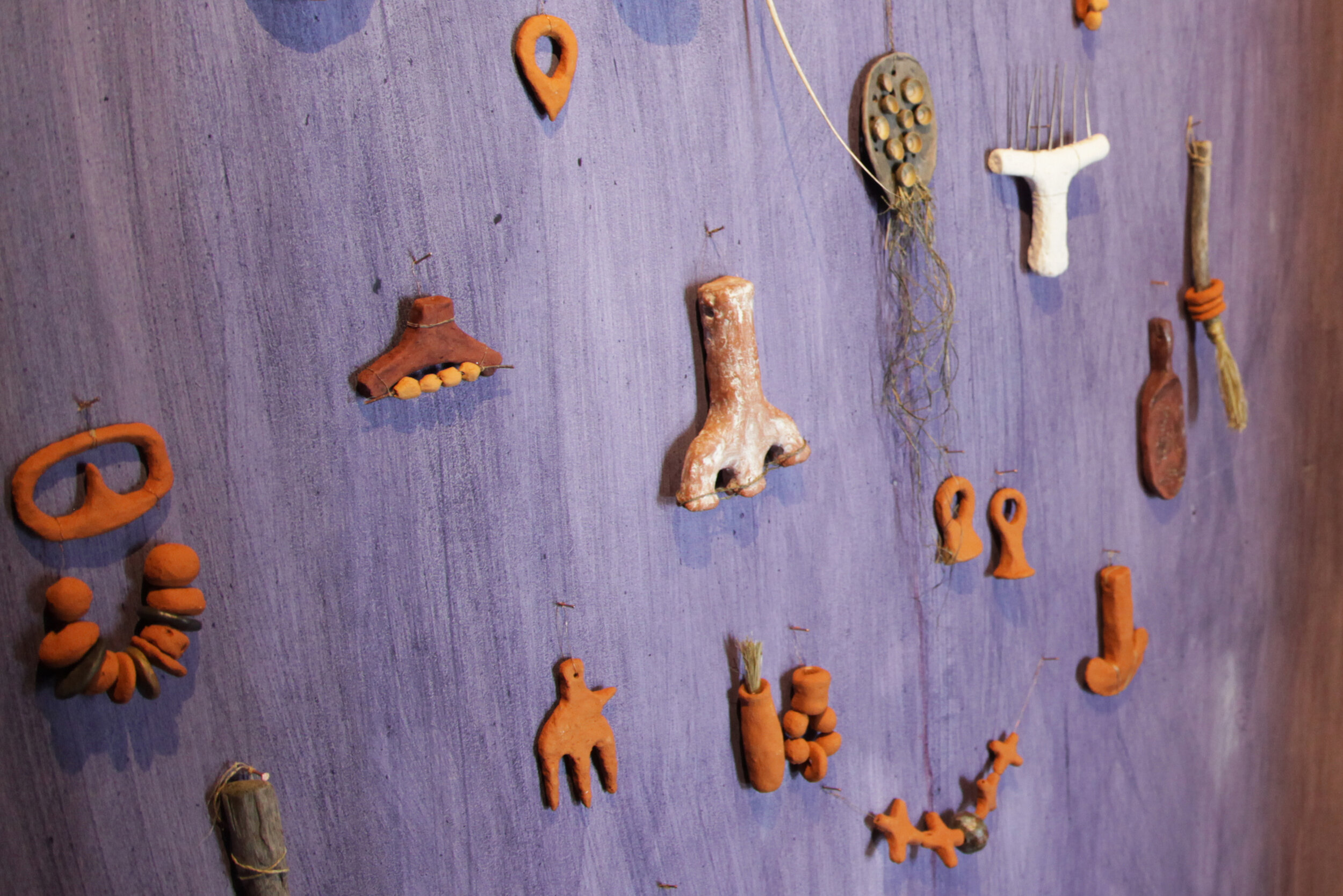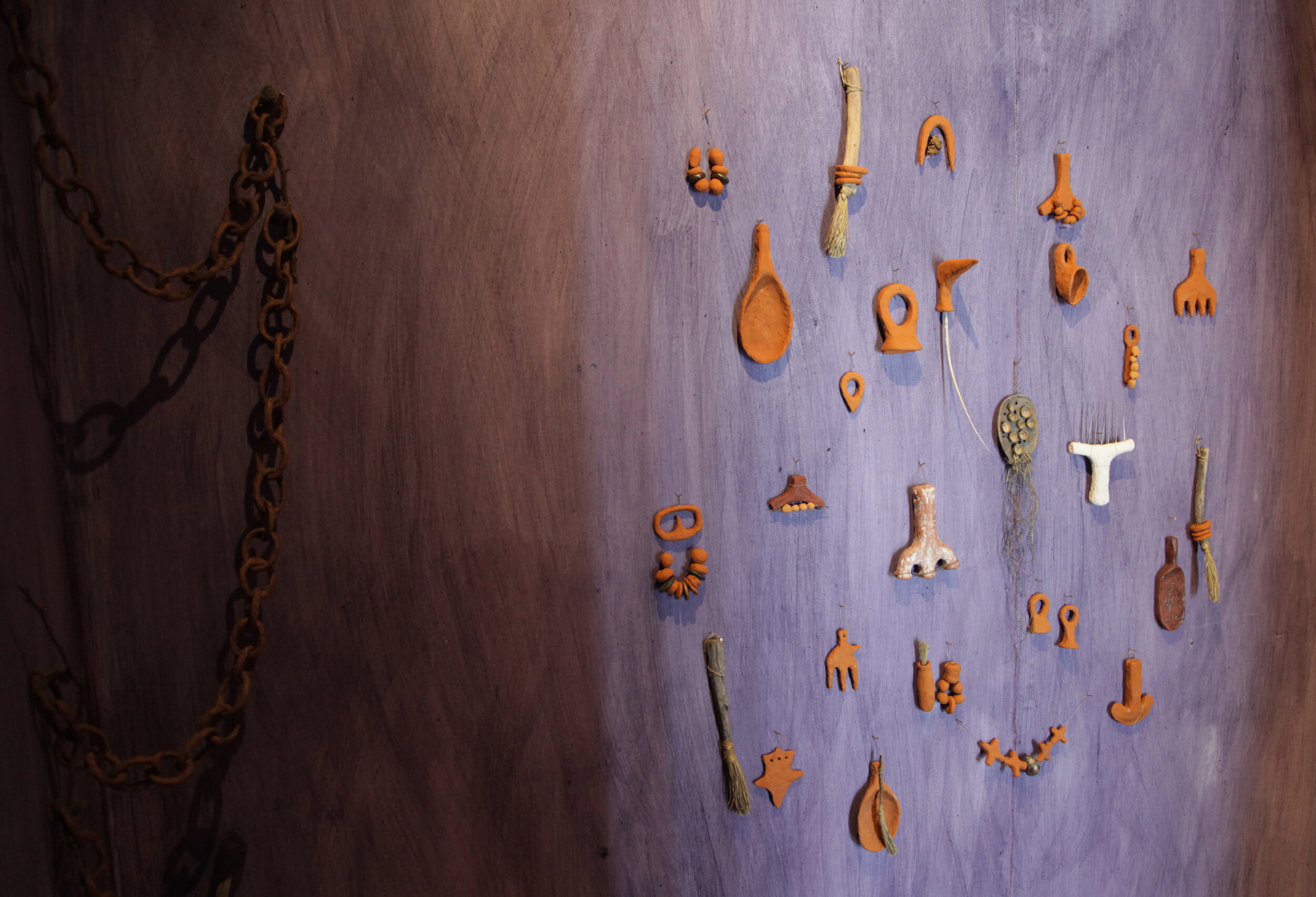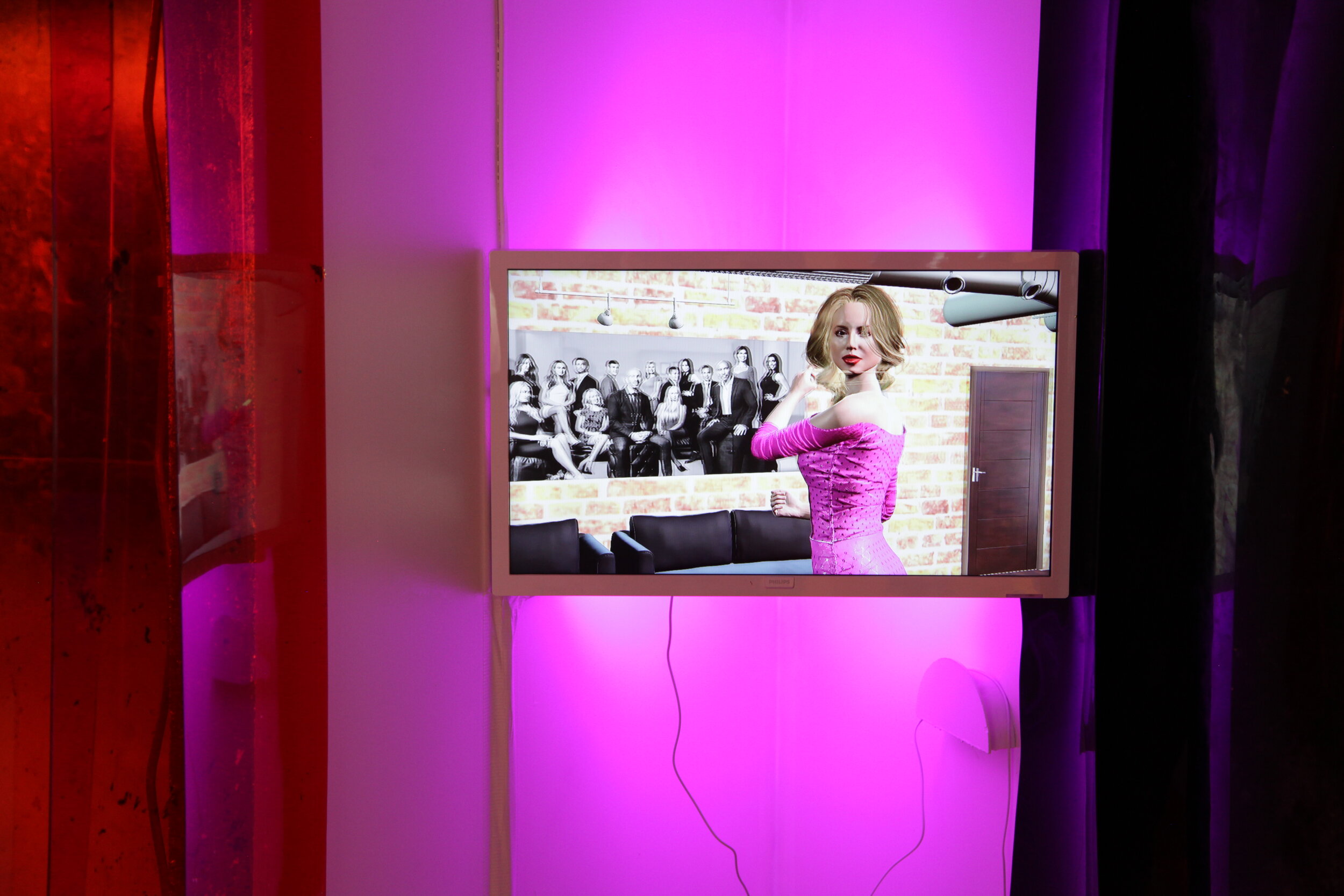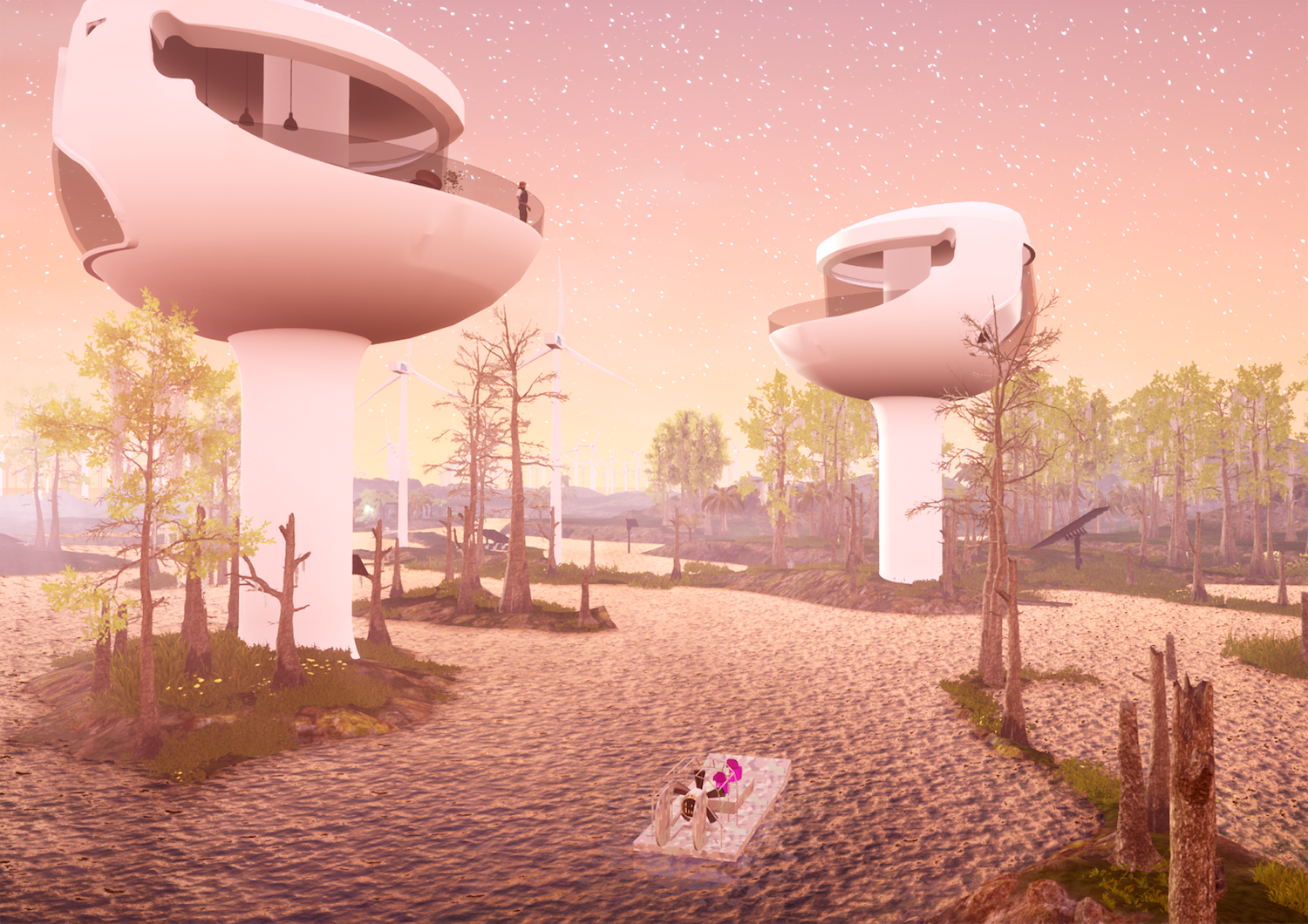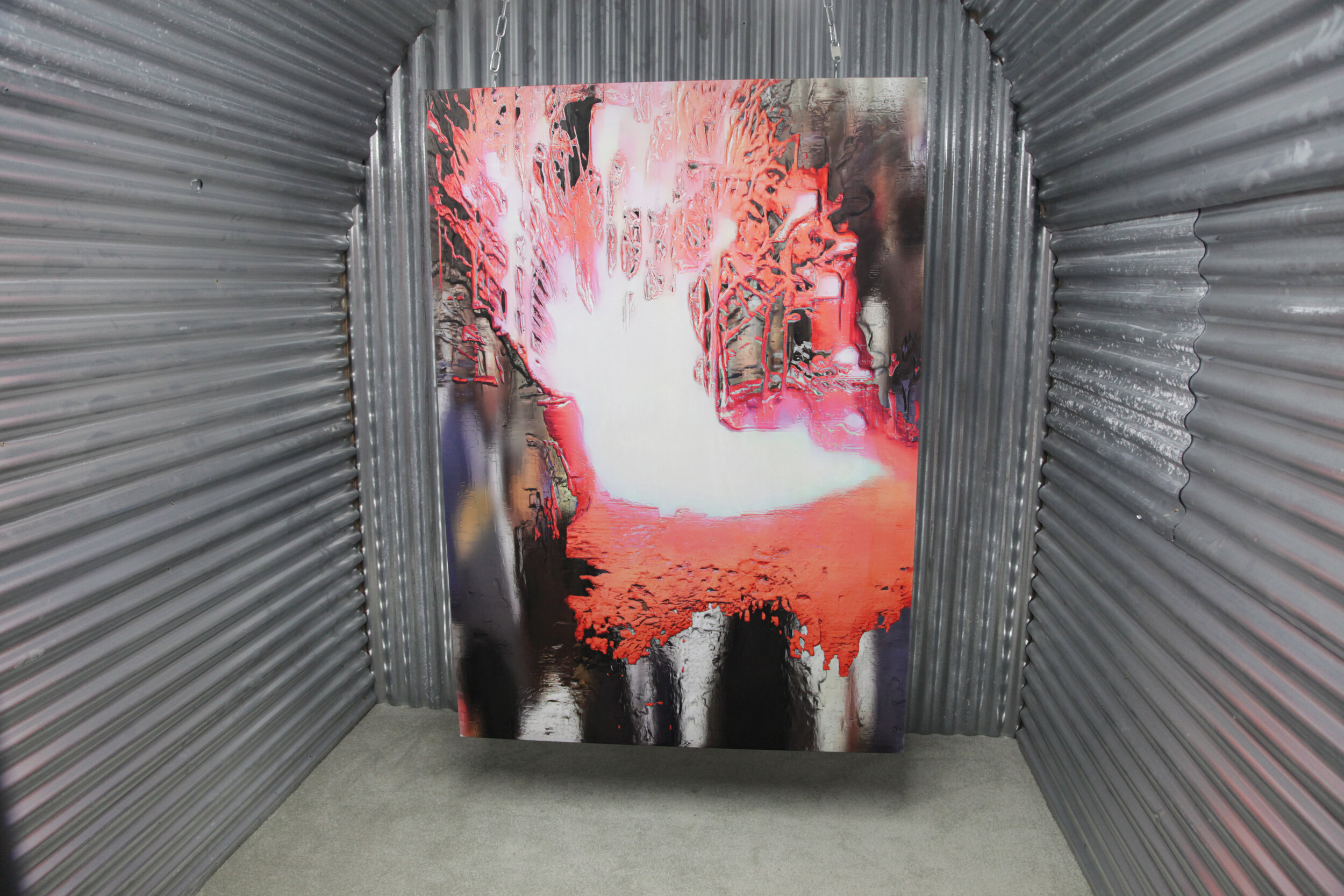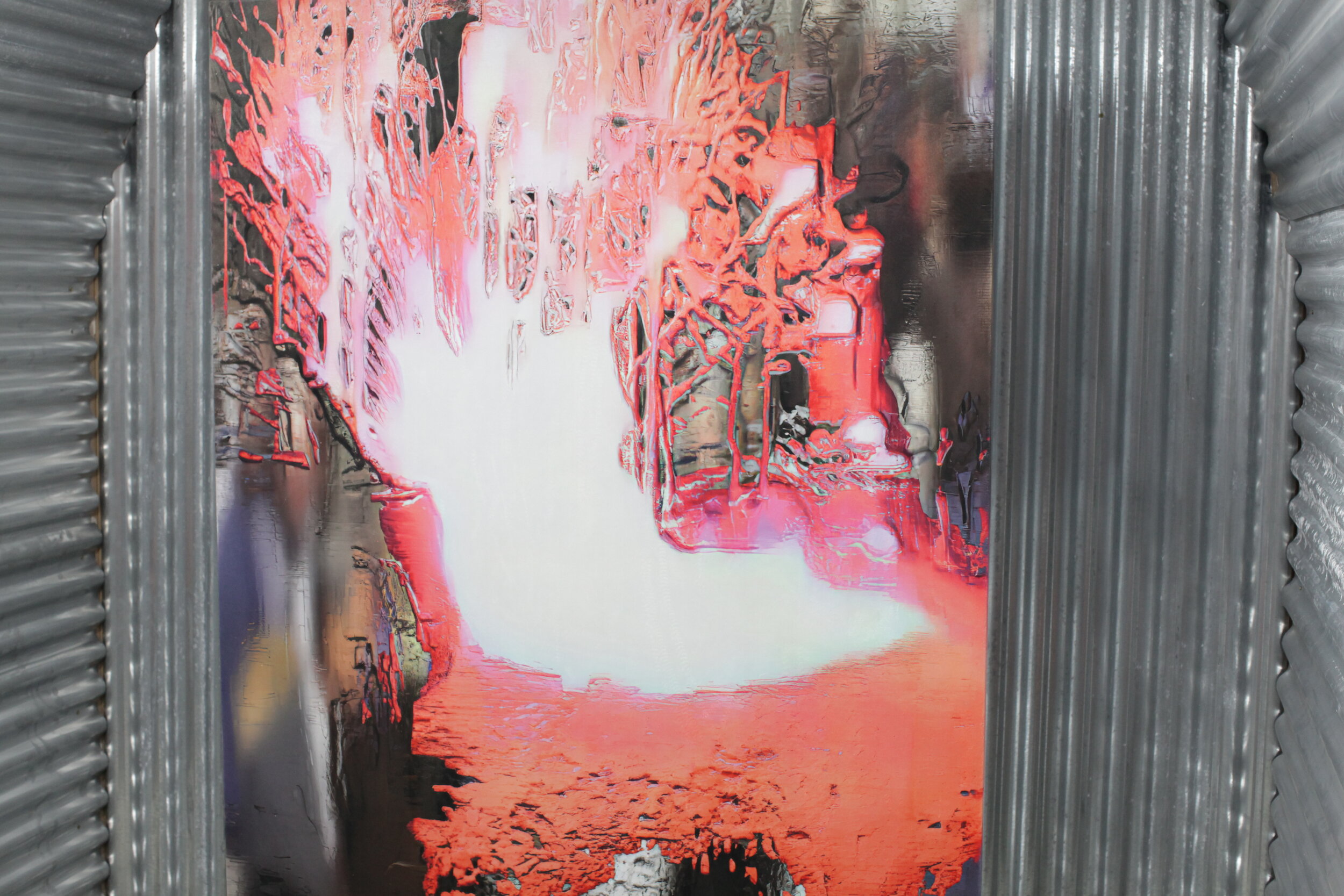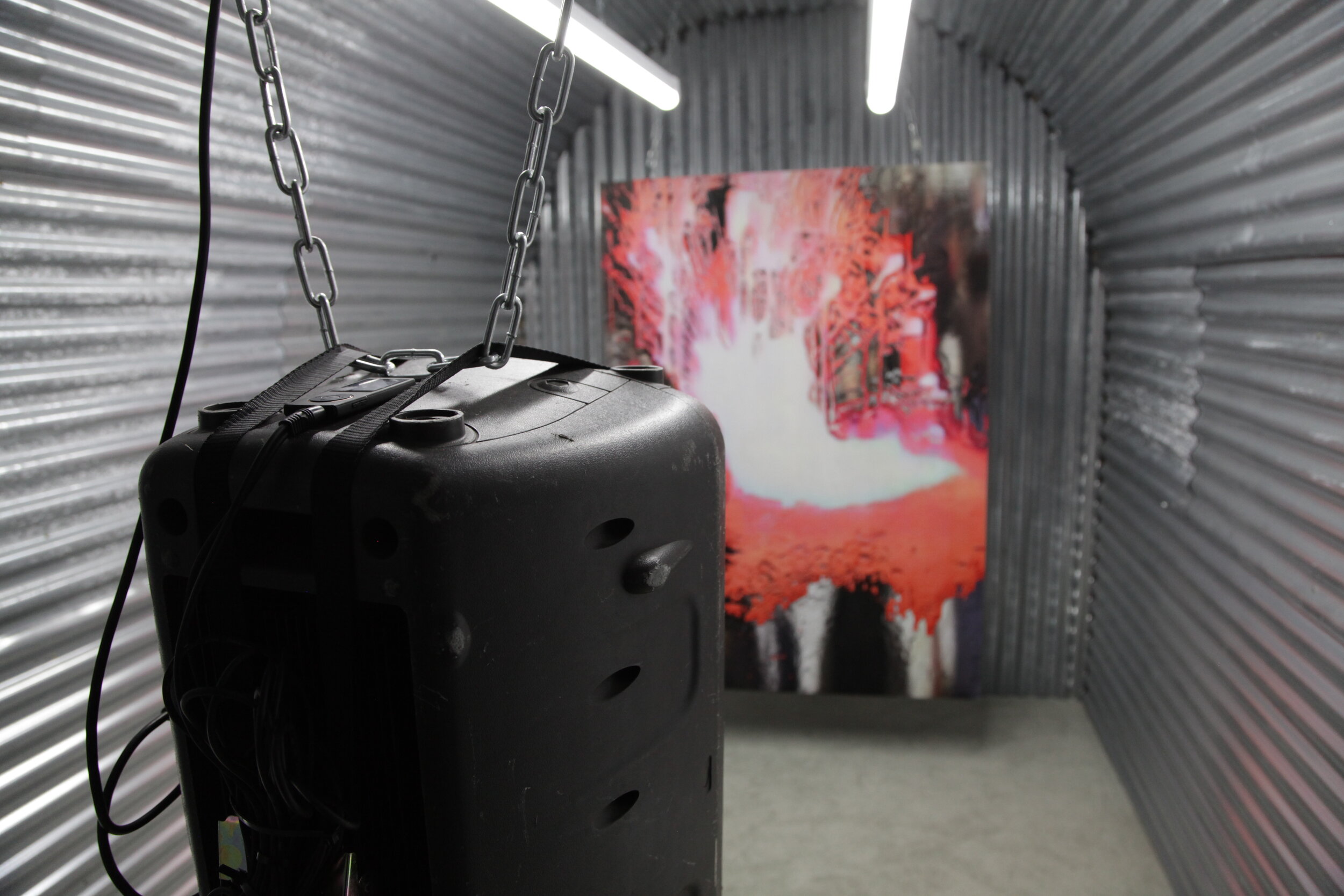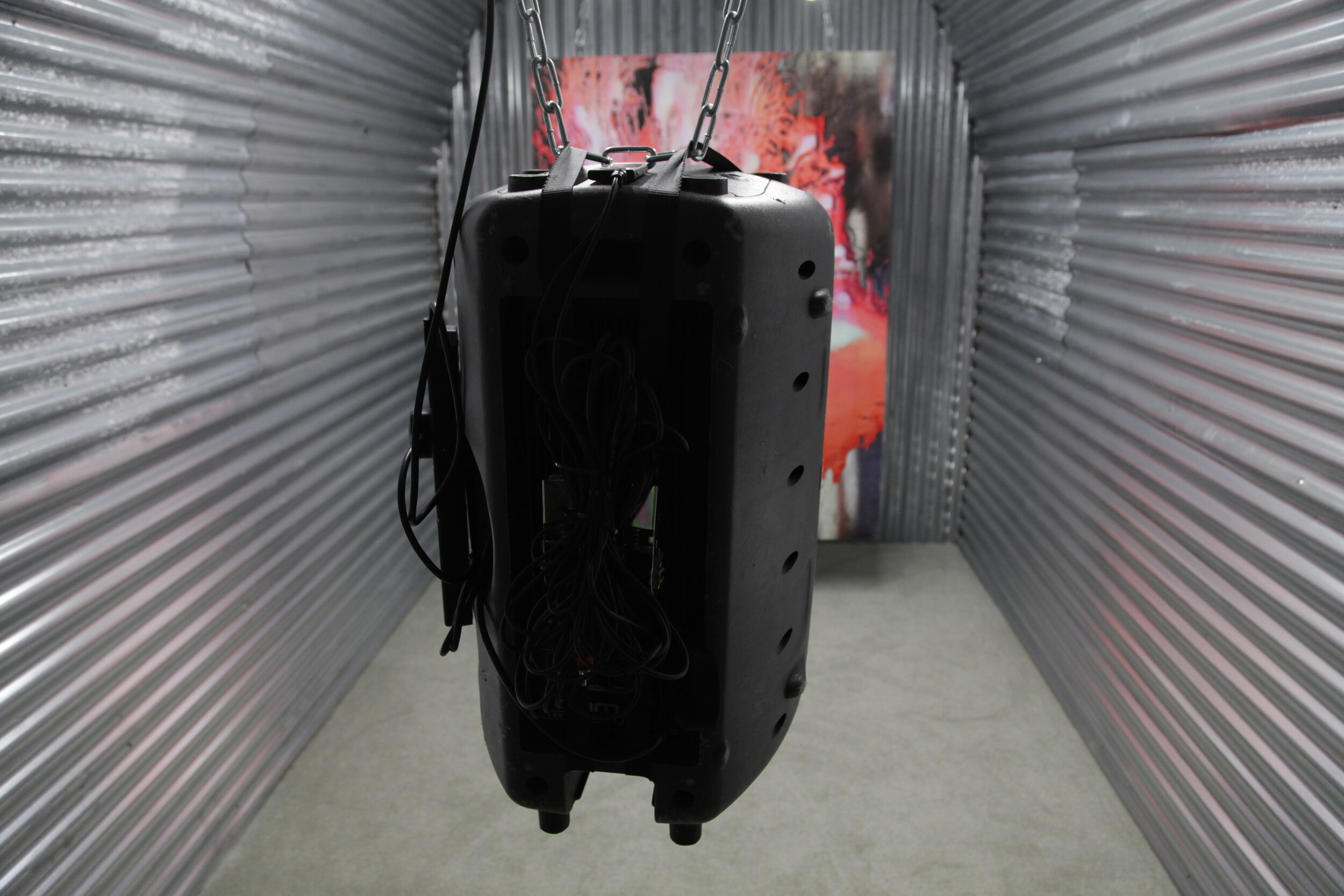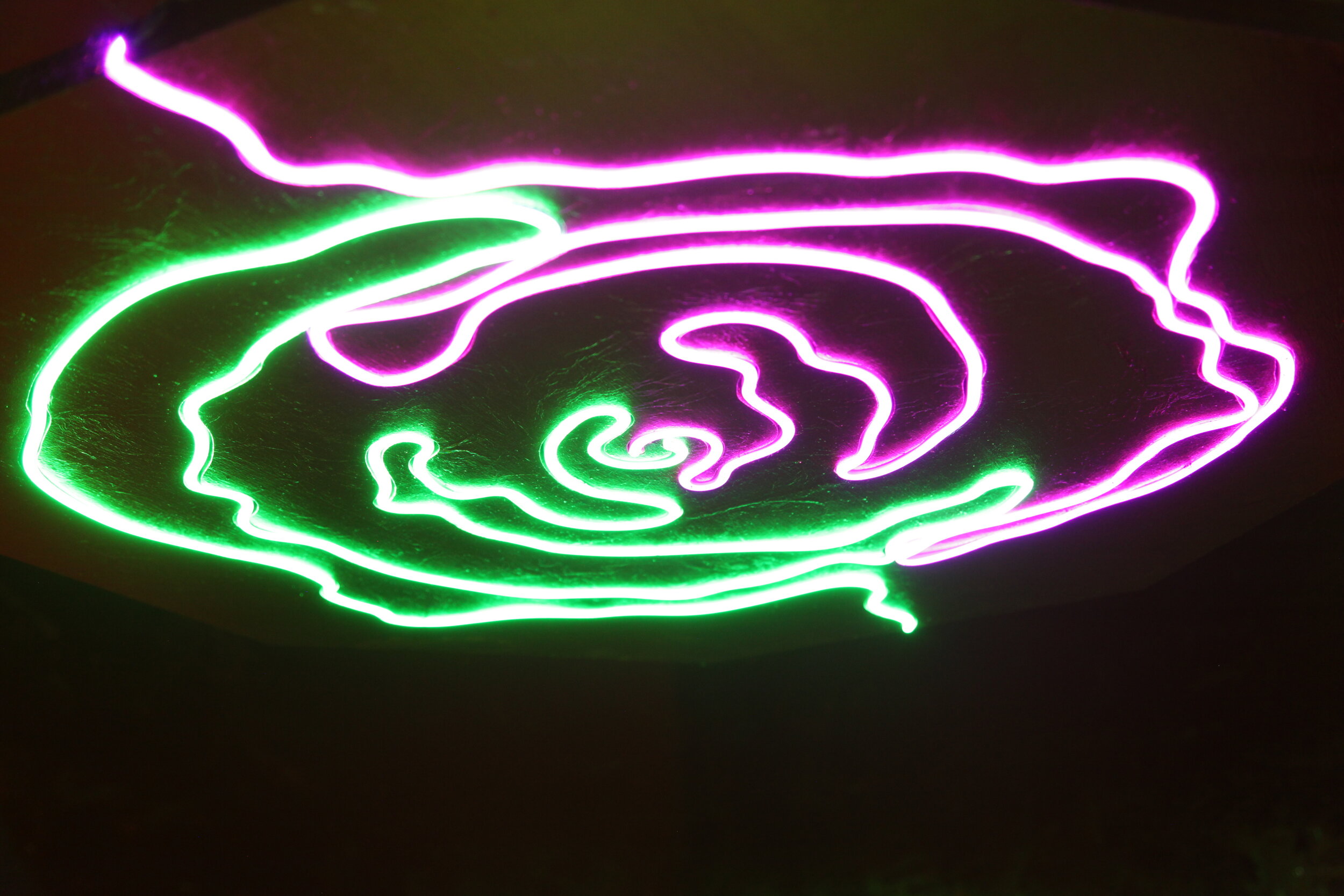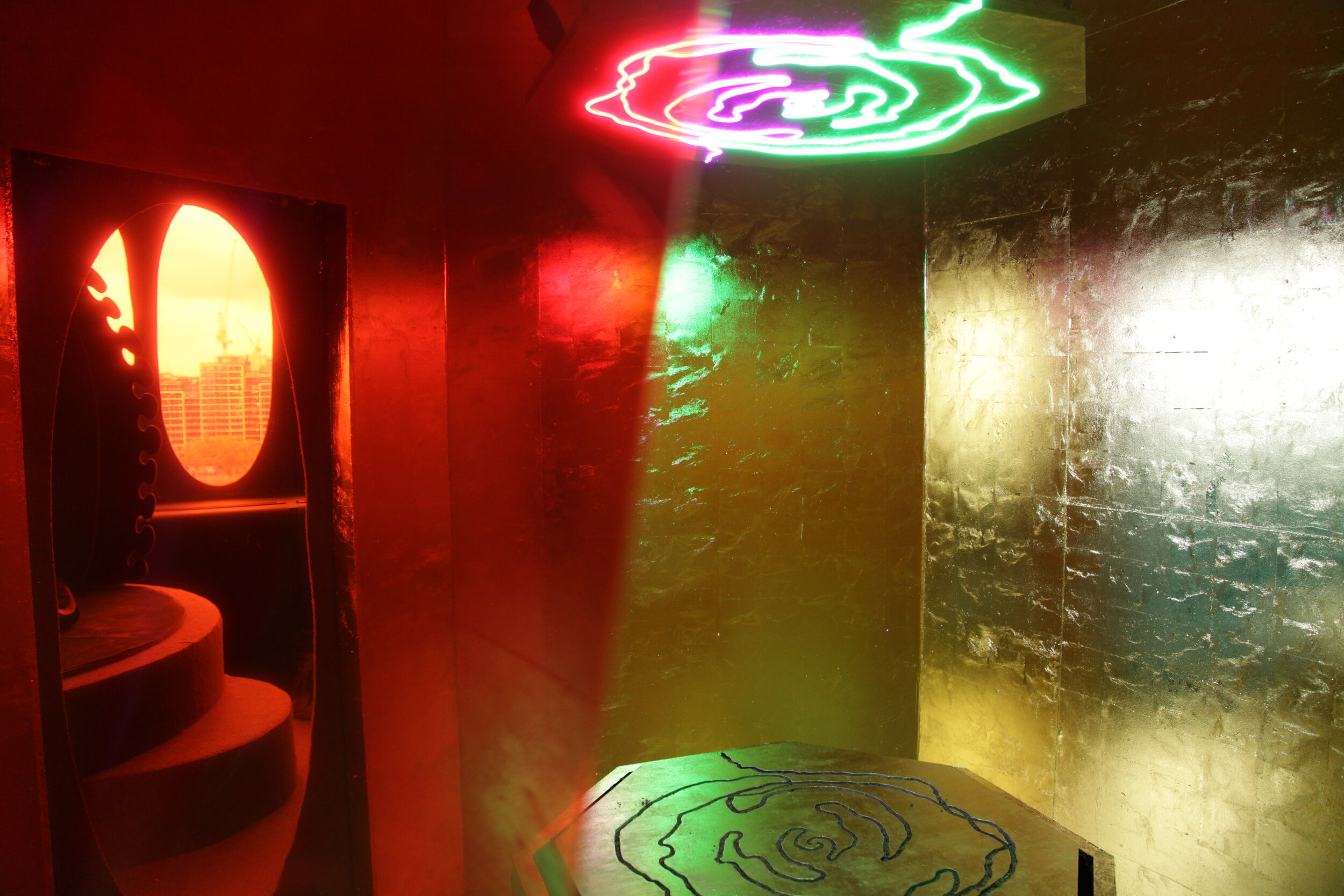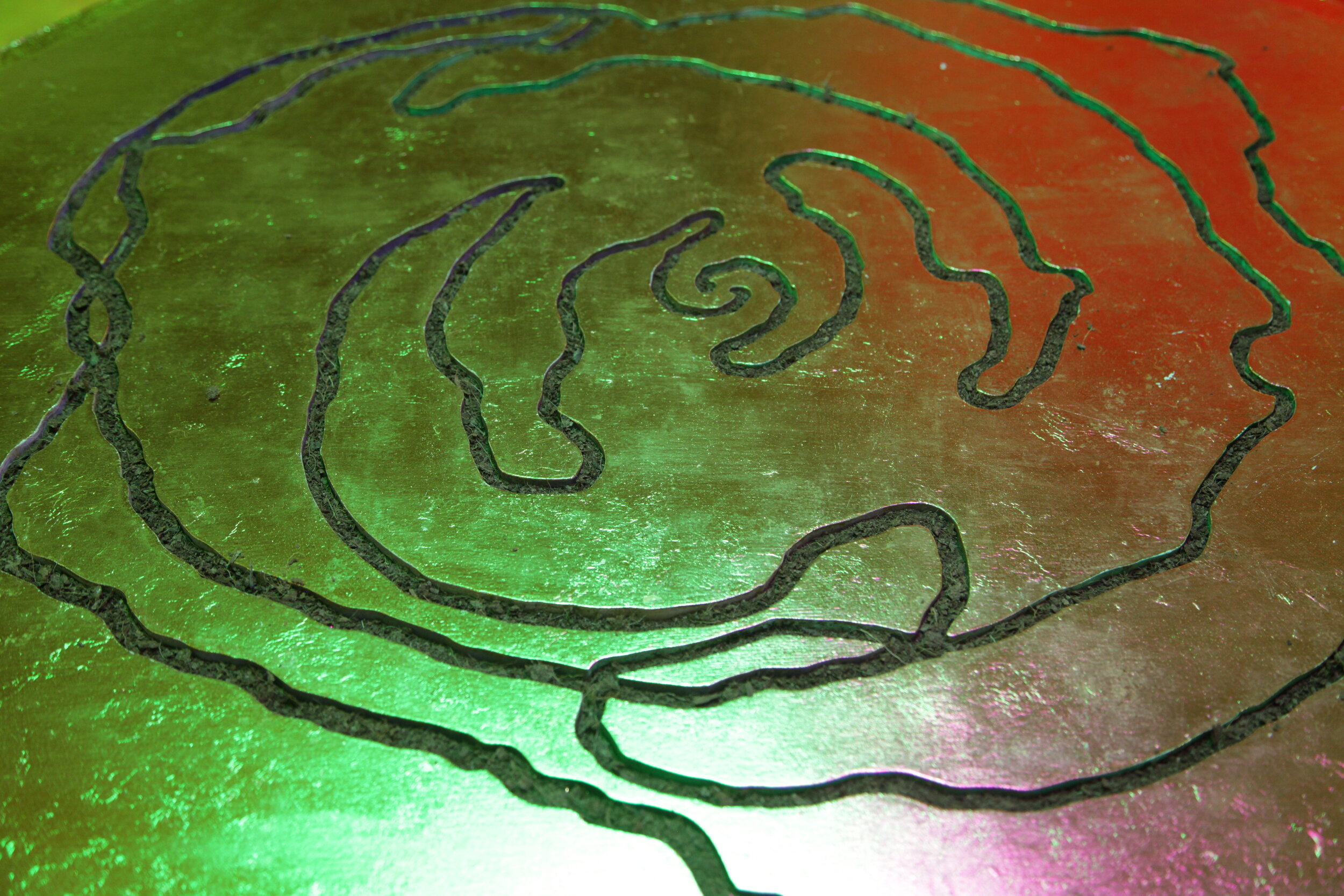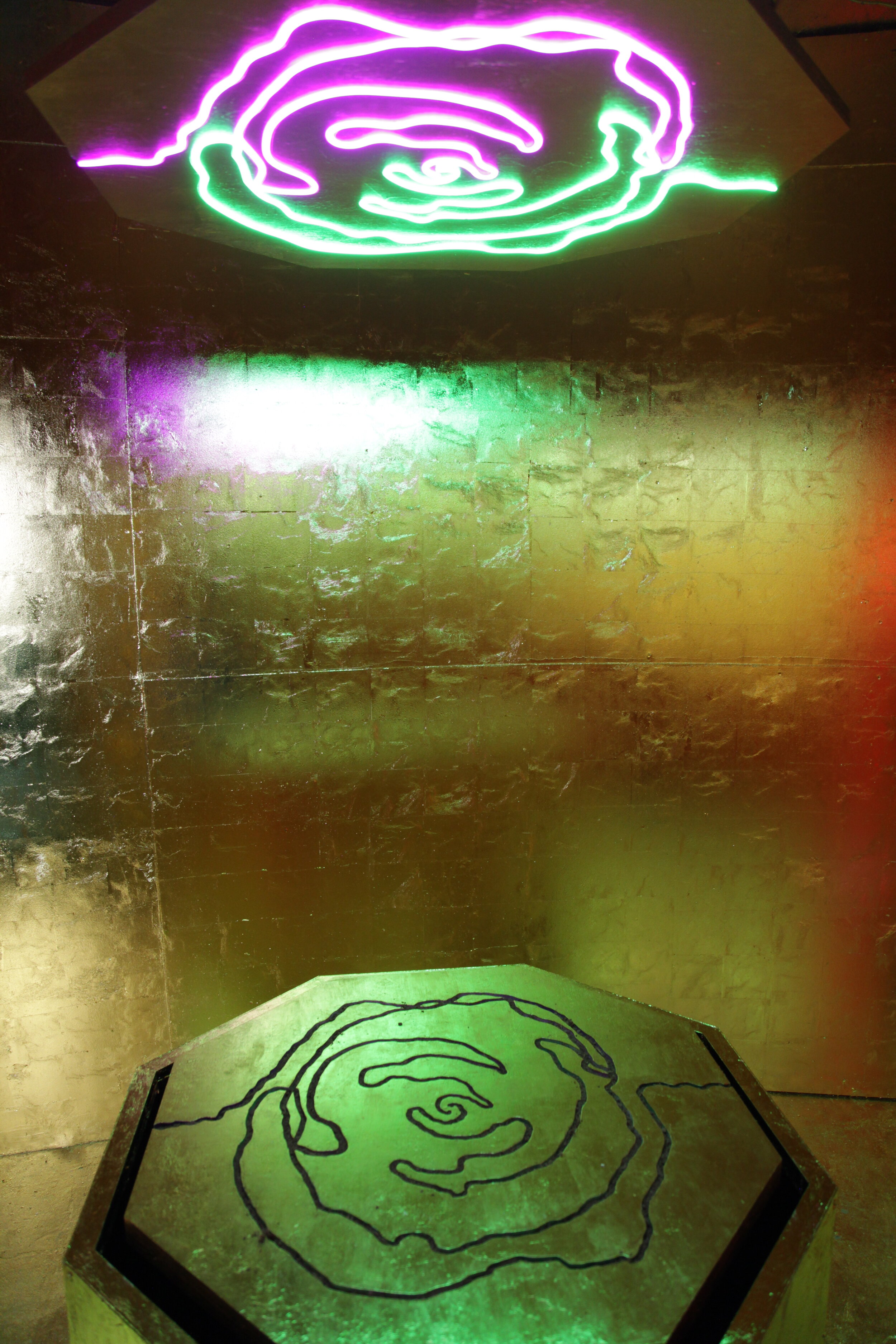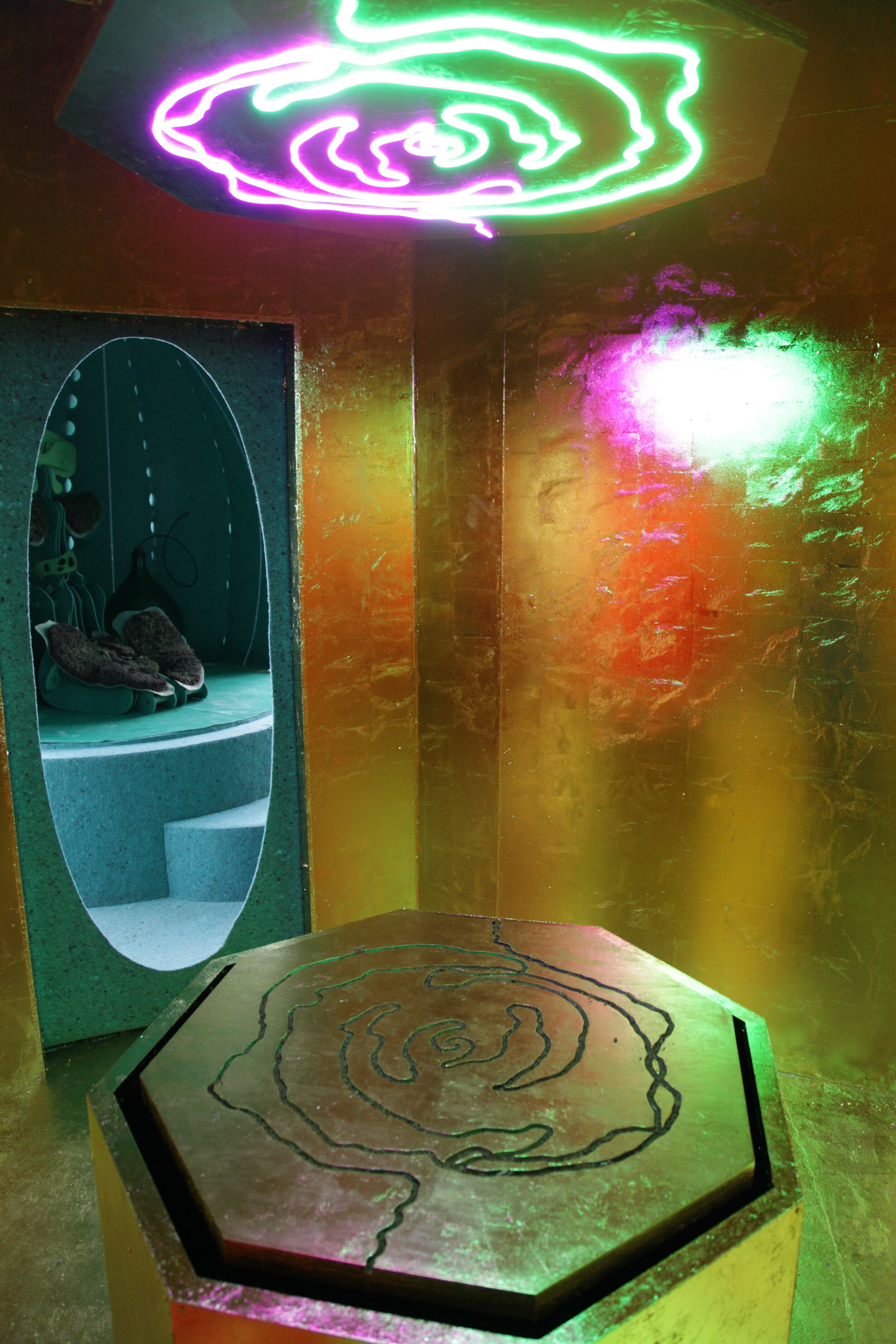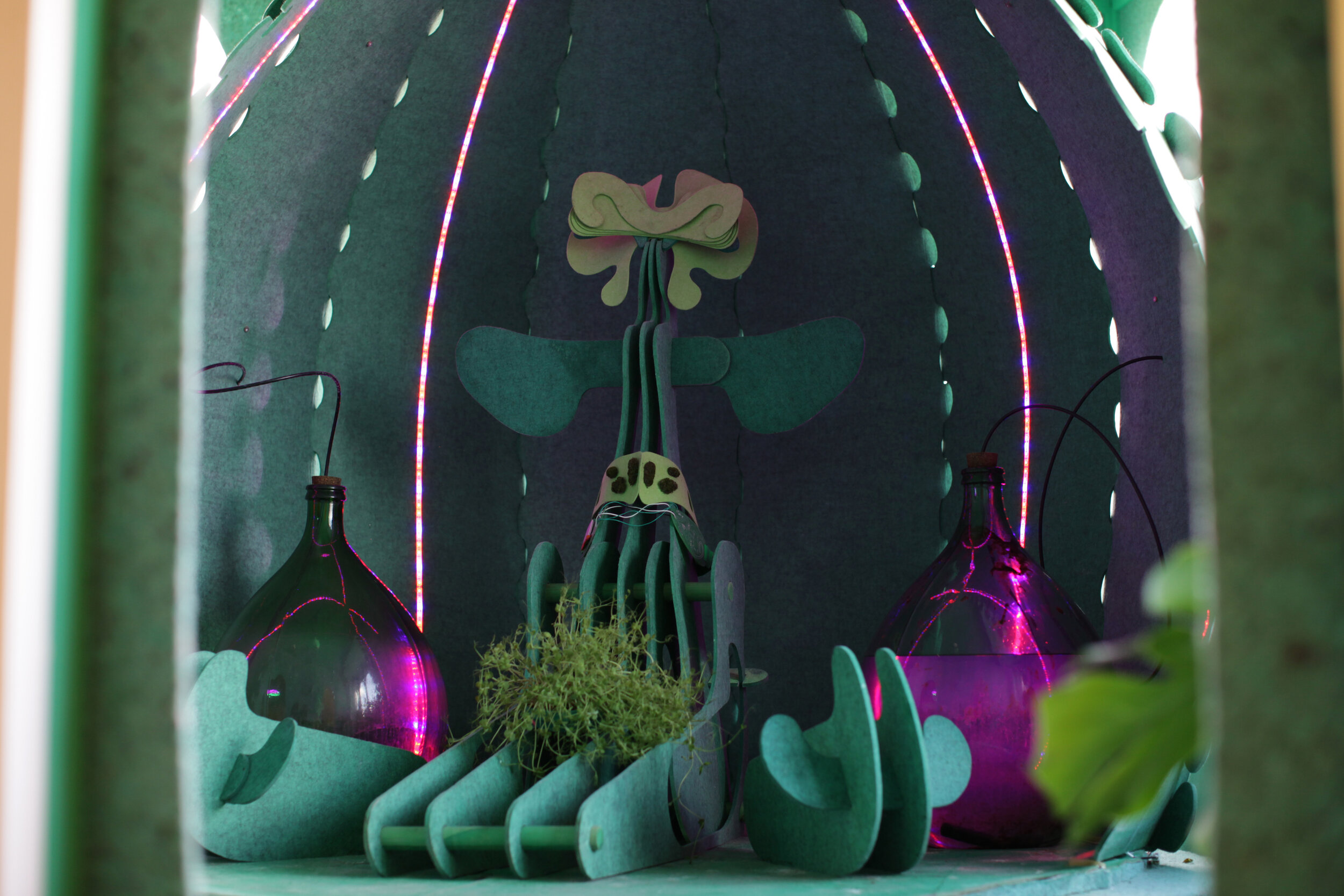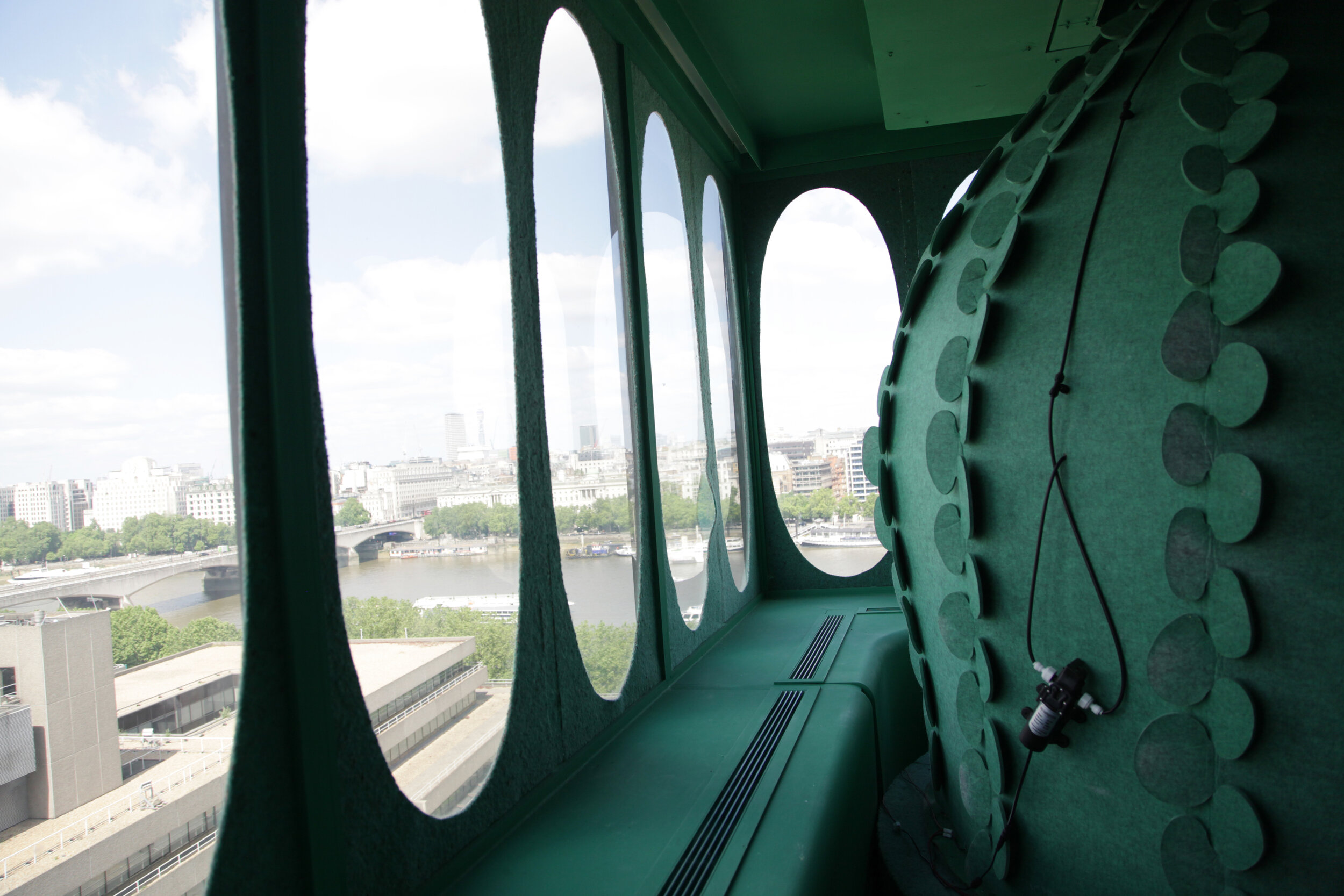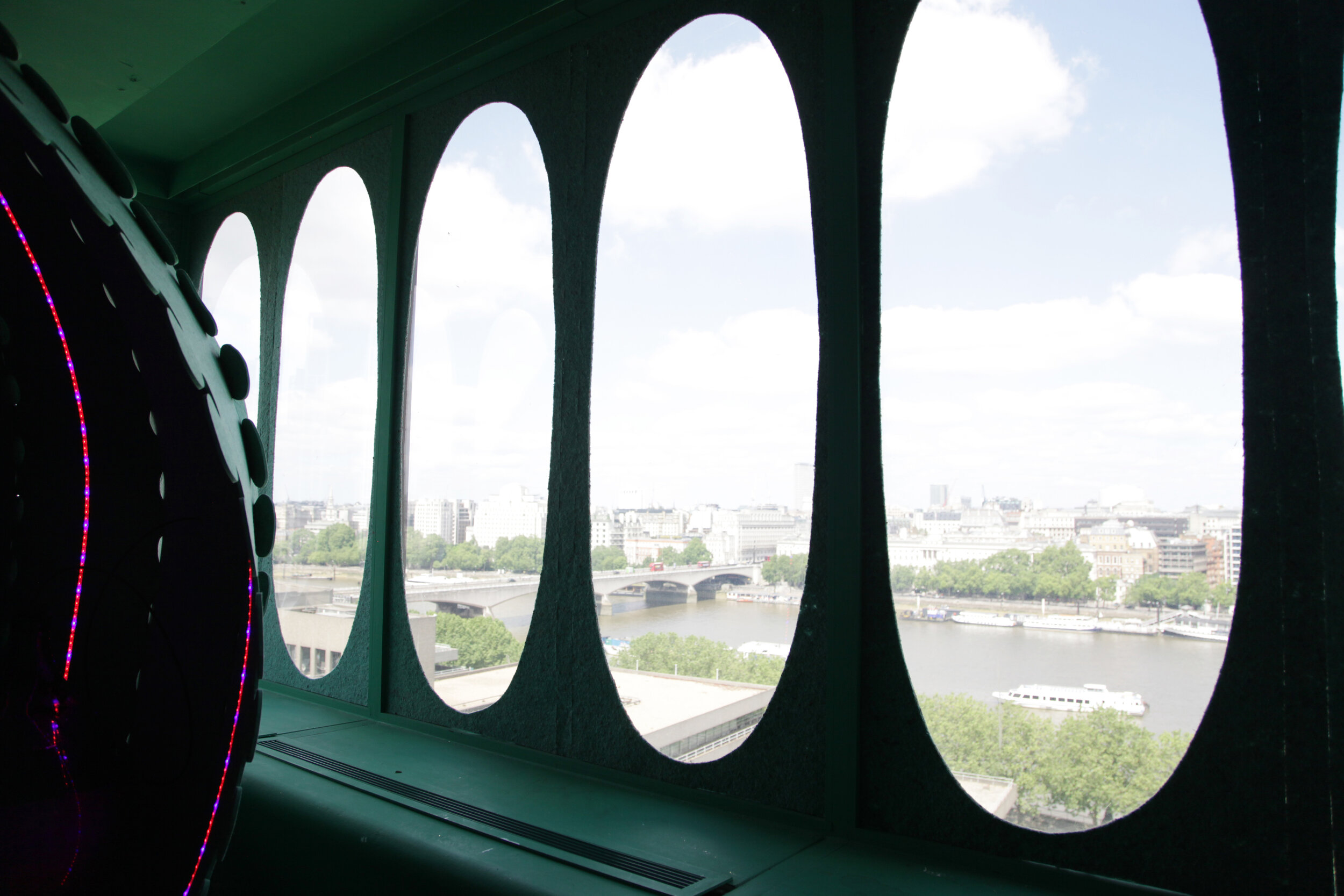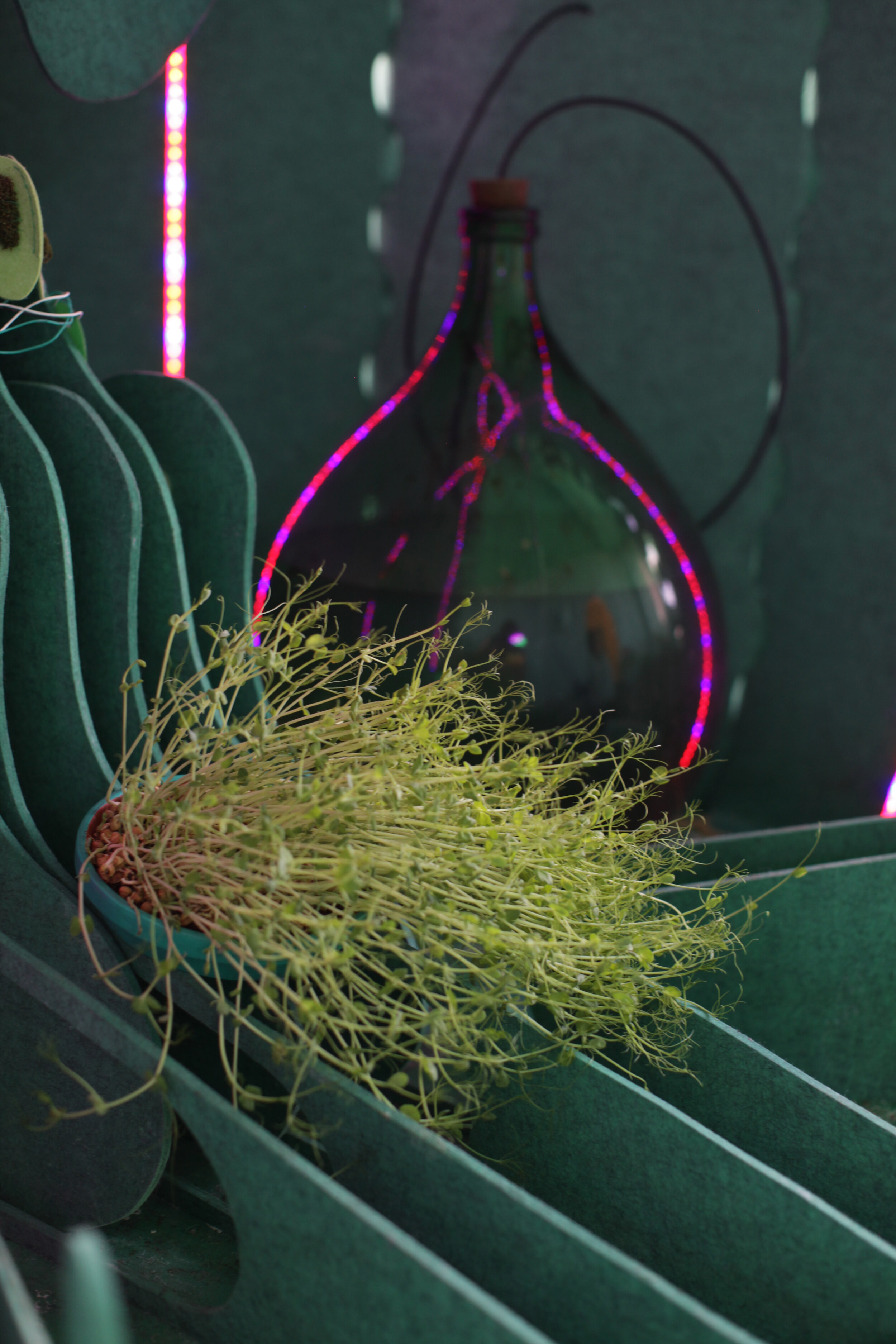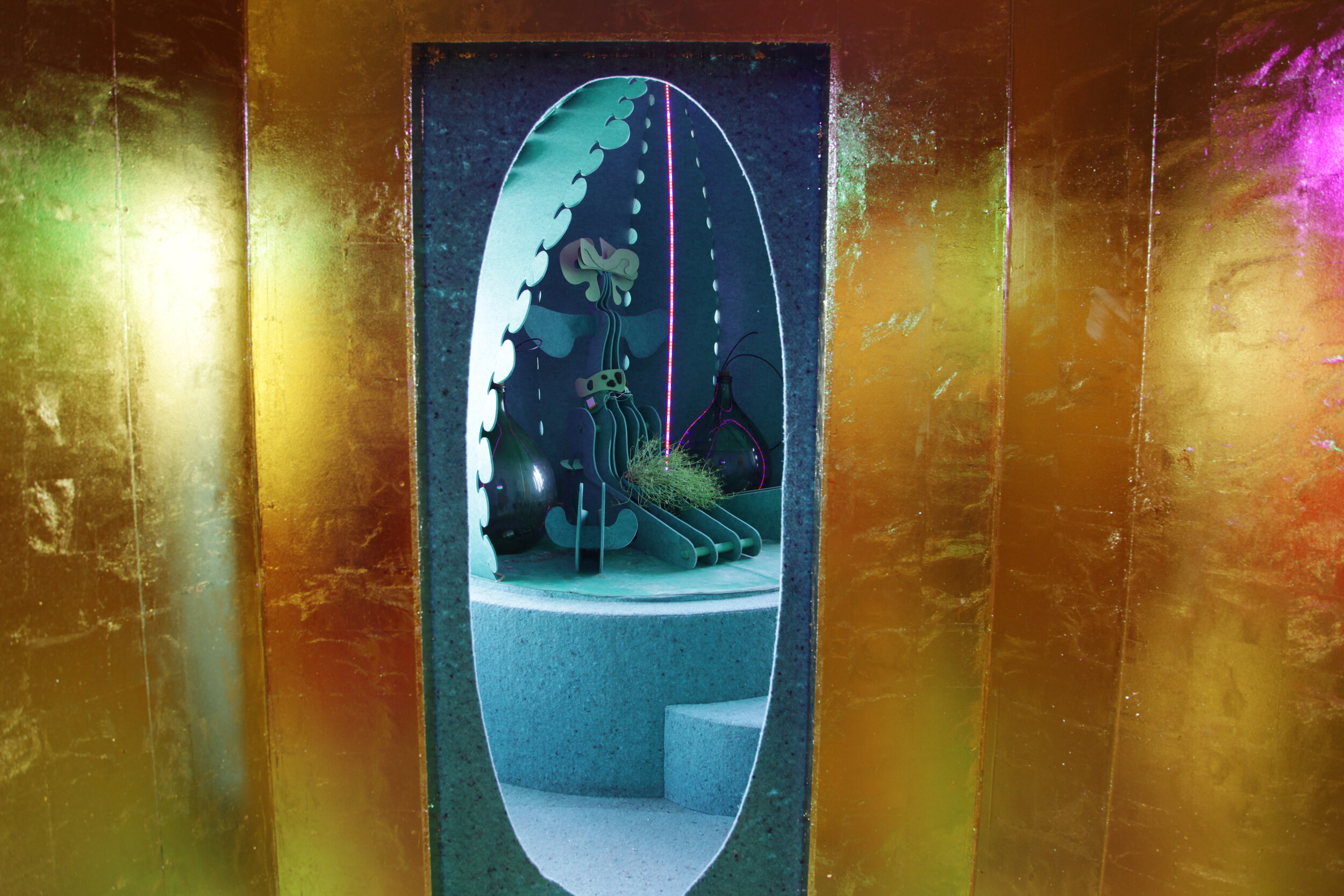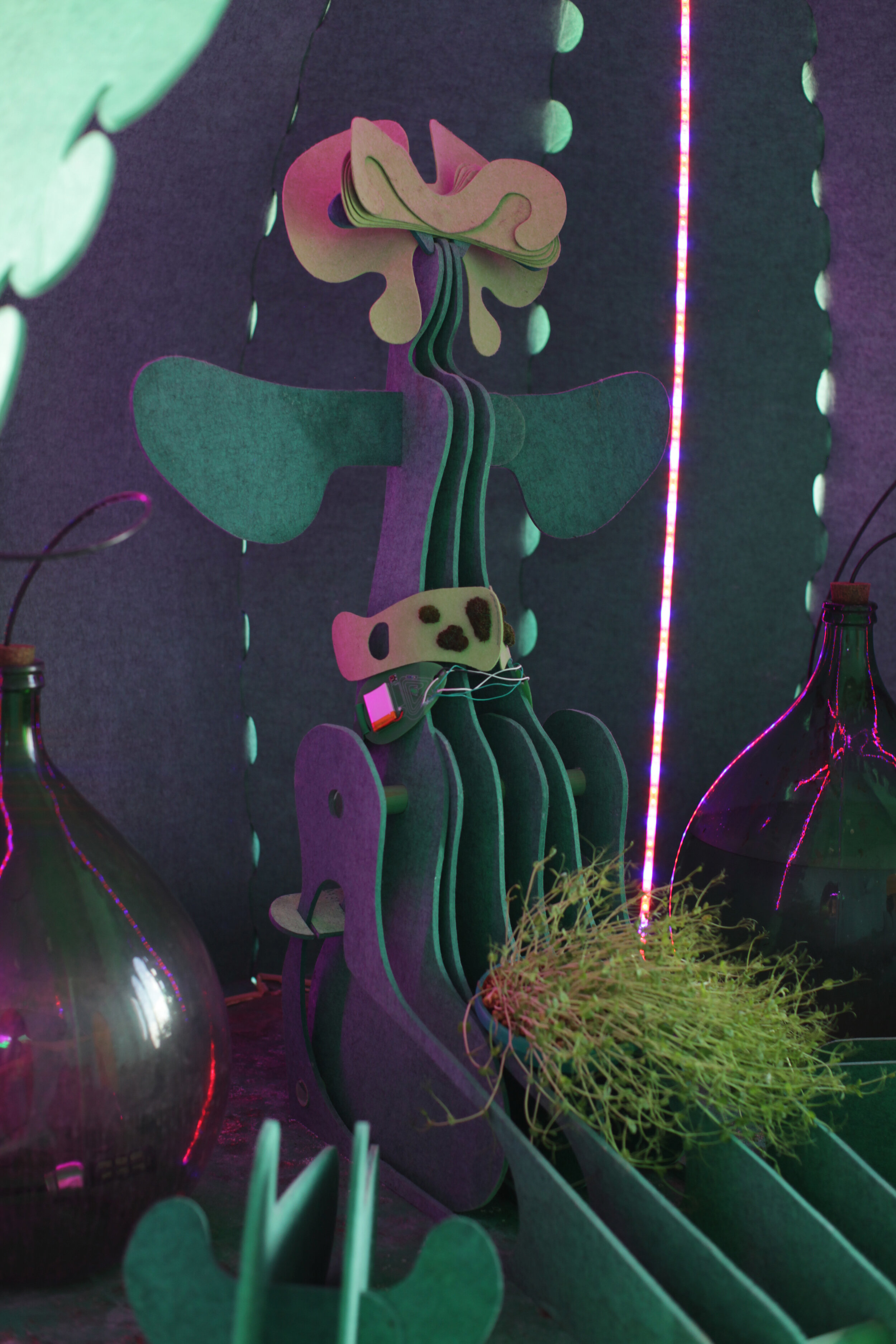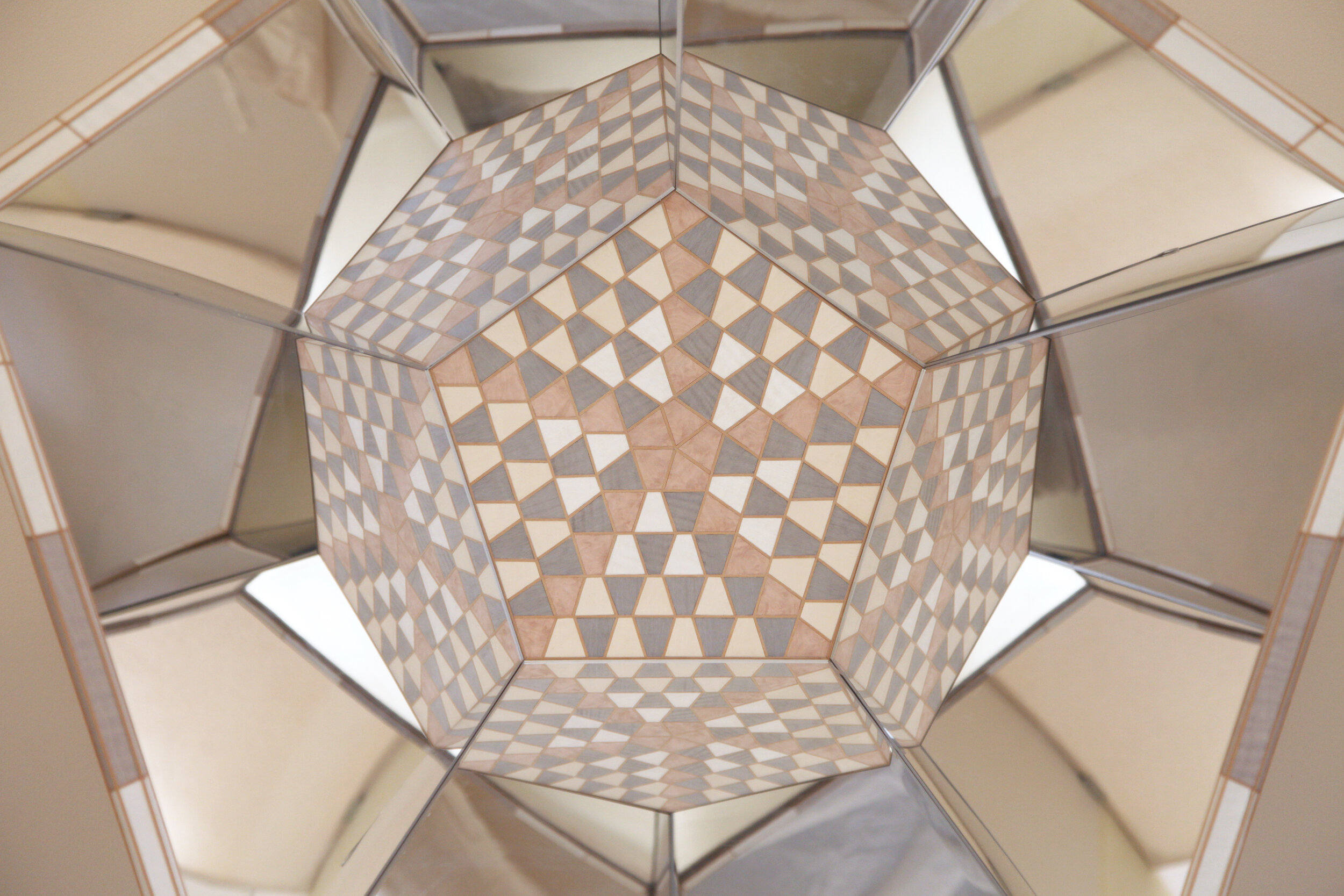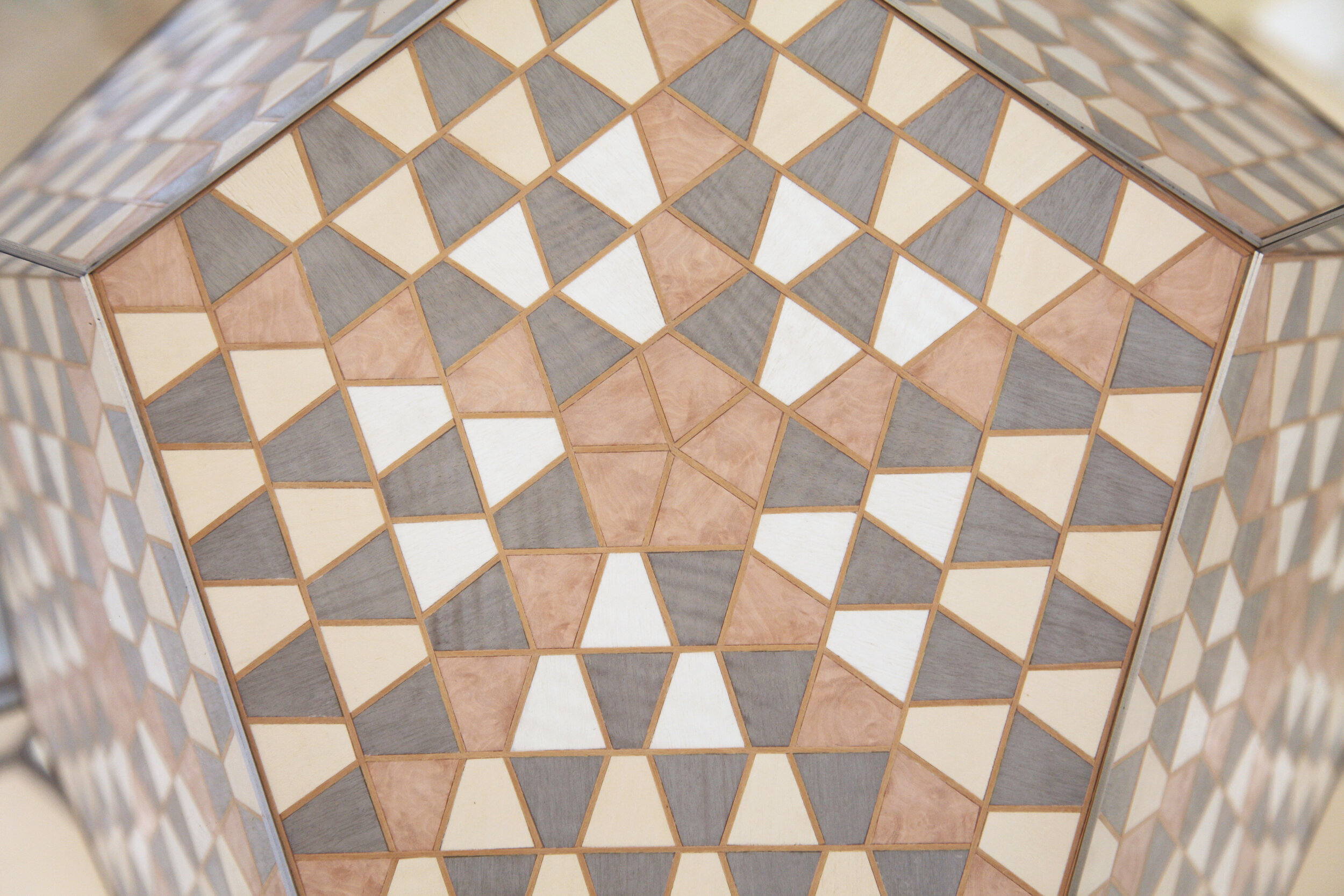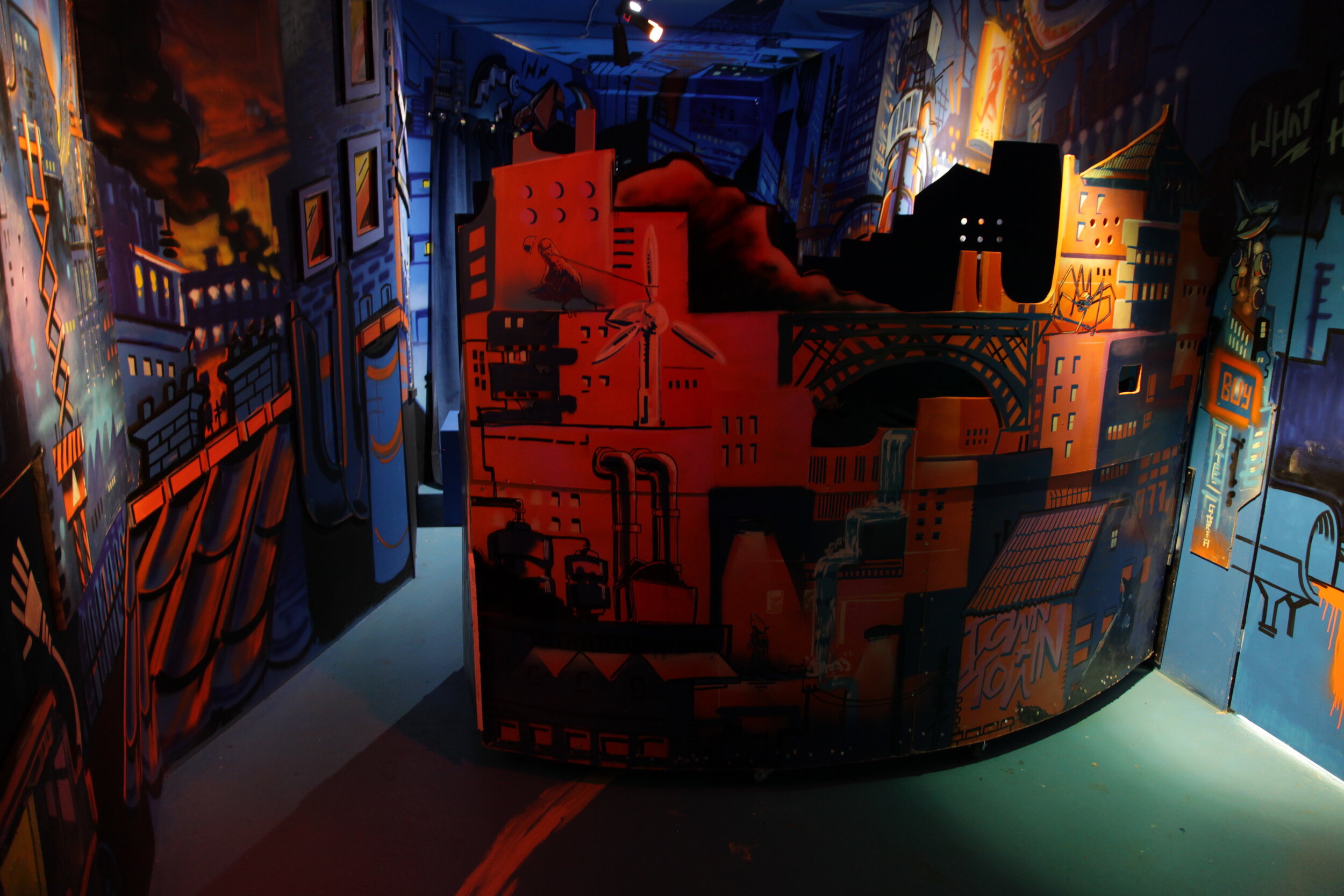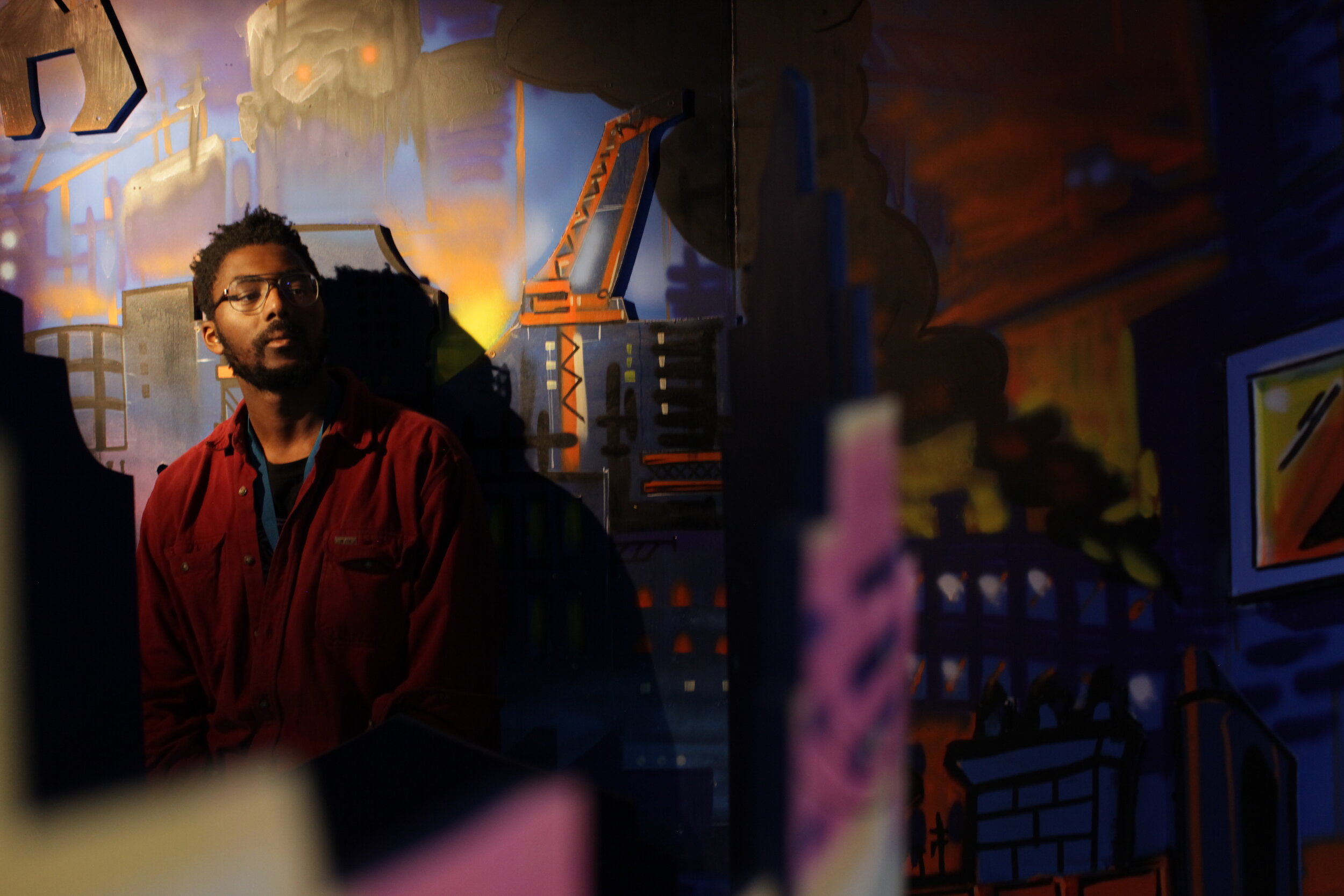TERRA NEXUS
19 May - 27 June 2021
Proposition Studios
60-72 Upper Ground, SE1 9LT
Artists: Ellen Pearson & Eleanor Beale, WR Saunders, Cristiano Di Martino, Catriona Robertson, Amanda Lwin, Alice Cazenave & Hannah Fletcher, Emma Jane Whitton, Rebecca Bellantoni, Sol Bailey-Barker, Tom Lines, Helena Doyle, Charlotte Osborne, Food of War, Sara Trillo, Alice Bucknell, Jack Warne, Finchittida Finch, Seads UK, Leila Dear, Wumzum & And Is Phi
Curated by Gabriella Sonabend
“BRILLIANT - HIGHLY RECOMMENDED!” Damien Carrington, Environment Editor for Guardian
“BEING LITERALLY ENVELOPED IN THE EXHIBITION’S WOMB-LIKE CORRIDORS OF CREATIVITY, TOOK US BACK TO WHEN CULTURAL PRACTISES WORKED HARMONIOUSLY WITH THE ECOSYSTEM.” Southwark News
Terra Nexus was an immersive exhibition featuring 25 artists curated by Gabriella Sonabend. First opening at Proposition Studios in Peckham in October 2020, the second iteration of the exhibition took place on the 10th floor of the former ITV Tower on the South Bank. With an expanded and reconfigured labyrinth Terra Nexus 2.0 developed from the first project with each artist pushing the multi-sensory boundaries of their former installations; reflecting on the human relationship with the biosphere against the backdrop of an ancient metropolis reawakening into a post lockdown reality.
Springing from the foundational idea that we need to shift away from a narrative of human dominion and independence in order to protect the biosphere, Terra Nexus installations explore: the necessity of living soil; the perpetual migration of species; the cascading threat of impending extinctions; ways to reconnect with nature; conflict arising from depleted resources; the future of cities and how humans will live within them. From the perspectives of insects and animals, through the eyes of scientists, artificial intelligence, plant life, ancient cultures and conflicting contemporary viewpoints; Terra Nexus is a wormhole of ideas.
0. Vegetating inside out by Eleanor Beale & Ellen Pearson
Sprouting and wilting, Eleanor Beale & Ellen Pearson’s wilderness is a carefully composed, planted, placed and painted sanctury created with the help of their mothers. Using plants sourced from commons and garden centres, their installation is woven together with an air of childhood nostalgia and fantasies of green idylls. The process of scavenging around commons harks back to the producers’ cooperatives and systems of collective ownership that these plots of land were initially created to bring about. In the work’s creation, the artists were called on to contemplate the resurrection of a now foggy, or otherwise unknown, memory of the sharing of public land and the future potential for collective agriculture.
The moss revives and dies, and is revived again, upheaved from mountain rocks to be woven through chicken wire structures. By watering the artificial garden daily, it is nurtured and cared for and grows, yet its expiry looms. For the most part, it will take on an endless process of rebirth, being repotted in different locations to eventually settle as a permanent part-dried, part-alive micro field-woodland hybrid (a permanent library of sorts). Both fake and real, this plot reflects tensions between invented ideals of ‘naturalness’ and the reality of landscapes within which we live, both pastoral and cityscape.
Ellen Pearson is an art director and design researcher. Her work broadly explores the realms of ‘artificial’ through fabricated realities, new technologies and semiotics. Eleanor Beale is an artist working both visually and with sound; investigating themes of landscape, memory, ‘naturalness’ and time. She draws from internal emotive landscapes and external pastoral and cityscape landscapes.
1. One Day As I Was Driving Home by WR Saunders
Dedicated to Arthur John Cunnington 1926-2020
One Day as I was Driving Home imagines a podcast encounter that stretches the current scope of the medium to a metaphysical level, one which, for the participants at least, could represent the seeds of a mindset shift, or could simply be another episode in a long running series.
Virgin epiphanies are a gift some might receive, out in the wild, alone, ahead of the curve, but for many of us, significant changes in thinking are a product of the networks/ecologies we inhabit exposing us to new ideas and stories. Often these experiences come via media we consume. Podcasts expose us to stories and new ideas more freely than has ever been possible in the past. The great potential for cultural growth therein is hard to miss. They represent another way to saturate our attention, are a powerful agent of distraction, on the plus side making life more bearable, but also allowing us to look past situations that need to change.
WR Saunders makes installations and films often concerned with the creation of the self — what constitutes it, what de-constitutes and reconstitutes it. Tangled with this is an interest in the theme of belonging: to a place, a time, a god, a community, a relationship, and the coping strategies we create when suffering from a lack of those things. With experience gained from documentary filmmaking he uses the semiotics of near-universally understood filmmaking modes, harnessing, mixing or subverting them
2. Metamorphic Nativity by Cristiano Di Martino
Cristiano Di Martino is a Neapolitan sculptor and painter. Profoundly influenced by his Southern Italian roots, his work embodies the tension between culture and environment. Using religious motifs, architectural structures, natural materials and sculptural methods rooted in the traditional 18th Century manufacture of porcelain in Bourbon Naples; his process is one of intricate construction and destruction, encapsulating the energy of a thriving culture positioned in constant threat of eradication.
Growing up beneath Mount Vesuvius, the artist was always aware of “the transience of humankind and its losing battle against such vast and majestic forces’. For him Naples “is a visual allegory of life and death, decay and rebirth.” His sculptures evoke buildings reclaimed by undergrowth, chaotic streets, eroding shrines, flamboyant human gestures and forgotten corners. Referencing human anatomy, tendril shapes morph from the landscape, shifting from bones into tree roots, evoking petrified skeletons beneath soil structures.
His intricate sculptural process is akin to architectural model making, creating stage sets for the audience to peer into, transforming us into giant deities inspecting another world. Seeking to pause nature at the height of its beauty, amidst chaos and harmony; he beckons us to zoom out, considering with a wider scope the forces of nature around urban environments.
3. WYRM by Catriona Robertson
Catriona Robertson makes sculpture and installations which explore architecture and the monumental, with a particular fascination for void spaces and the way these are filled in a rapidly developing concrete urban landscape. Conscious of the afterlife of materials; considering waste, reclamation, recycling & degradation; she seeks to use and re-use; absorbing discarded materials, evidencing the life cycle of a material as an integral part of the work.
Recycling materials from one installation to the next, her process is one of construction and deconstruction in an on-going cycle. Thus her materials become a life-force throughout her work, creating “a constant regurgitative flux, forming layers of synthetic sediments in a journey”. Working site-responsively she uses subsequent detritus, making and un-making the work in the same space, in a performative interaction between the object, audience and site.
WYRM was provoked by the artist research field trip to Agroecology sites across the UK, where her fascination with soil strata deepened. WYRM incorporates refuse from the Proposition Studios sites, materials collected from Wakelyns Agroforestry and Knepp Rewilding. It is a playful intervention that celebrates the importance of these creatures to the biosphere, considering the way they break down detritus and create rich soil which sustains entire ecosystems.
4. GUT-TER-ALL by Amanda Lwin
Amanda Lwin is an interdisciplinary conceptual artist whose practice is concerned with urban systems and how they interact with our identity. Projects attempt to reveal the way that systems and infrastructure underlie our societies and lives: networks that hold cities together but might be invisible or intangible.
Bulbous figures of mycelium and bioplastic lurk in a space that is part-bunker, part-cave. Walls effloresce with Gorgon-esque masks: glow-in-the-dark heads emerging from the blackness like bioluminescent mould. These figures, referencing Medusa, are not the decapitated monsters of Greek myth, but reflect a more ancient heritage of chthonic goddesses and masked seeresses, interpreters of gurgling voices from deep underground.
The installation re-envisages them as the spirits of our sewerage systems – a dank, wet world breeding urban legends like alligators, ninja turtles and fatbergs. A system that supports our everyday lives – invisible, unseen – in Combined Sewers, a gathering, digesting and regurgitating of all our viruses, DNA, recreational chemicals, bodily fluids, lifebloods.
Breeding resonances between the array of mycorrhizal networks that support tree and plant roots, and the vast, ethereal organism of hidden tunnels and services beneath city streets, an all-encompassing metallic drawing over the walls entwines ideas of labyrinths, cosmic diagrams and infrastructural plans, and is suggestive of the curlicues of copper and other rare metals (pipes, cables) that lie beneath us latent and interlaced.
Over the life of the exhibition the mycelium figures will blossom and fruit with grey oyster mushrooms. Oyster mushrooms can purify water of e.coli bacteria resulting from sewage, and other fungal species are able to extract gold and precious metals from e-waste. But fungi, which are neither plant nor animal, neither friend nor foe, can be threatening as well as life-giving: mould is a substance that infers decay and death. Neither plant nor animal, but a creepy in-between: a carnivore of rotting flesh; a grotesque, gut-ter-al goddess; sacred and profane.
5. Made By Many Hands: A Botanic Photo Lab by Alice Cazenave & Hannah Fletcher
Made By Many Hands: A Botanic Photo Lab explores the research, failures and possibilities in making the culture, processes and materials of photography more sustainable and environmentally conscious. Reworking the toxicity of chemicals and processes through the use of materials including clay, copper, algae, bacteria, yeast and leaves, Fletcher & Cazenave present an evolving laboratory of curiosities, reconsidering the future of the photographic industry.
Overrun with research papers, experiments, works in progress, diagrams and specimens, they evidence systems that integrate plants and multiple species of bacterial organisms into circular photographic systems. Their aim is to provoke conversations about waste and the under appreciated/under-utilised ability of plants & organisms. Their laboratory highlights serious issues surrounding the role of plants in our daily surroundings.
Alice Cazenave and Hannah Fletcher are collaborators working in plant based photographic processes. Cazenave is an experimental photographer, trained in Visual Anthropology. Her practice uses exploratative photographic techniques as an enquiry into changes in culture and society broadly. Fletcher is an artist working with cameraless and plant based photographic processes and co-director of London Alternative Photography Collective. Fletcher combines scientific techniques with photographic processes, creating a dialogue between the poetic and political; exploring environmentally and ecologically-focused issues.
6. Swimming in the Mud by Emma Jane Whitton
Emma Jane Whitton’s practice explores the idea of invasion through multi-disciplinary installation. She is interested in the uncanny and the intimate in material connections, looking at ways invasive behaviours are paralleled across different arenas, such as organic growth patterns, domestic and industrial environments, design and social interactions, in order to explore mercurial affects that echo social and environmental instability.
In this installation everything sticks together in an attempt to hold itself up. Pulling in the ground are bits of us, but which bits? The boredom and joy of this struggle invites the viewer to unravel things that stir beneath the surfaces.
7. I sit, I dream, I wish, I build and grow (For Rosemary) by Rebecca Bellantoni
I sit, I dream, I wish, I build and grow (For Rosemary), is centred around the metaphysical possibilities of the materials of the city. Considering the relationship between the psyche, soul, body and our lives in this environment. For this installation Bellantoni approaches concrete, rumble, soil and the colour black as a conduit to ancestral knowledge of the land, agriculture, community building and sustaining. The work speaks to the multiplicity of possibilities that arise from the opportunity to stop, listen and imagine new futures.
In her dark contemplative installation, architectural materials are punctuated with precious stones and cowrie shells. She examines the connection between the mono farmed landscapes of the Caribbean and the infrastructure of Britain, provoking questions about how in contemporary context one can approach these complex histories, using the fabric of the city itself.
Rebecca Bellantoni mines everyday occurrences and abstracts them. Investigating, through the lens of metaphysics, comparative theology, philosophy, religion and spirituality and their collective aesthetics. She gently prises apart the concept of the accepted/expected ‘real’ and the experiential ‘real’; looking at how these removed borders may offer meditative experiences and portals to self, collective reasoning and healing thought. Her practice encompasses video, performance, photography, textiles, printmaking, sculpture, writing & sound-text.
8. Wyrd Codex: The Last Hope Hotel or The Party At The End Of The World?
(Requiem For The Holocene) by Sol Bailey-Barker
Wyrd Codex plays with the concept of Technobiophilia (using technology to bring humans closer to nature) imaging a potential future where hybrid machine-animal-entities are responsible for terraforming the land, housing once thriving (now extinct) ecosystems like museum relics. Referencing James Lovelock’s theory of the Novacene, Bailey-Barker infers that neglecting to restore our endangered ecosystems, protect our insect populations and shift our relationship to resources and technology; may result in a future where our species loses the privilege of tending the land.
Sol Bailey-Barker is a multi-disciplinary artist fascinated by the connection between the development of technology, ritual and the transformation of landscapes. Working with natural and man-made systems he approaches his practice like a hyphae network drawing together archival information, found objects, science fiction and science fact, seeking to highlight the fundamental connections between all sentient beings and non-sentient things. Somewhere between a historian, an archivist, an engineer and an inventor, his installations beckon the viewer to question everything.
9. Follow-Through by Tom Lines
Follow-Through is a light box digital painting, a stained glass portal that reveals a place and an entity which eludes human or animal form. Interested in the crossover between human, beast and cartoonish monster, the work is perhaps a mirror to ourselves, a reflection on the way we inhabit space, encouraging viewers to see parallels in perceptions of nature.
Tom Lines works between the tangible and the digital realms of painting and sound, offering glimpses into a liminal world. Here surfaces break down and amorphous creatures populate nostalgic interiors “in the form of strange pets, bodily ornaments and soft toys”. Guiding the audience through domestic scenes, mundane fantasy and abject visions, he presents a form of auto-fiction on the borders between tongue in cheek and deadly serious. Beginning with embodied mind-states like depression and anxiety, he tries to generate a bodily-emotional reaction in the audience, fabricating ‘thick air’ with synthetic yet organic sound, ambiguous narratives and densely worked paint.
10. Perniciem Karesansui (Garden of Extinction) by Helena Doyle
Perniciem Karesansui is a cascading Zen garden. It meditates on the epochs of major extinctions and locates the viewer in this present moment as humanity faces the sixth mass extinction. It longs for a collective conscious awakening through which humanity is enlightened to regenerate the biosphere and in doing so, save itself. At the heart of the piece hangs a 4.5 billion year old meteorite; a reminder of the fragility of Earth & the enormity of the unknown beyond.
This meteorite was observed falling to earth in 1516 near the city of Nantan in China. It burst during passage through the atmosphere and the pieces were scattered across a vast field. This fragment was not discovered until 1958, when many meteorites were gathered for smelting to make metal for the rapid industrialisation of China.
Helena Doyle is a multi-disciplinary artist, filmmaker and educator working across mediums from installation, video, fulldome and street theatre to land art. With a background in film, her arts practice developed from a desire to create ‘real time’ experiences that encourage connection and contemplation. Sanctuary is a major theme in her work and she creates immersive ‘soft architecture’ inspired by sacred geometry, folk crafts and Zen design principles. The relationship between nature and technology features in her work, with a particular interest in sustainability, biomimicry and self-organising-systems.
11. Harvest Womb by Charlotte Osborne
Harvest Womb features a wunderkammer of evolving sugar specimens hanging from the ceiling and rising up through the floor. Referencing the micro-organisms we carry inside us, which also exist in other bodies of life on earth, Osborne beckons us to acknowledge our mutual interdependence, which begs the question; If the non-human exists in the human, can we really be so separated from nature?
Charlotte Osborne is a multidisciplinary artist whose sculptures and paintings meet somewhere in the middle of both media. Her paintings depict gummy, jungle-like vines, biomorphic shapes which press and squeeze together. Her subjects are trickster-like beings teetering between something human and non-human; evading such distinctions. They suggest an eerie intimacy with nature, advocating for the dissolution of the hierarchical attitudes towards species. The strangeness, horror, tenderness and laughter of ecological awareness is outlined: we are inextricably enmeshed with and permeated by the biosphere.
In sculptural form, Osborne’s subjects are brought to life as swirling specimen within over-sized test tube and jars. Using transformative viscous materials such as boiled sugar, her sculptures continuously evolve, dancing and evoking associations to cell structures seen through microscopes, intestinal matter, deep sea creatures, slug-like formations. They remind us of the fluidity of all living matter and become emblems for a hybrid model of thinking.
12. Colony Collapse Disorder by Food of War
Colony Collapse Disorder beckons the viewer into the epicentre of a disrupted hive where the worker bees have abandoned the Queen leaving behind only adolescents and nursing bees who are incapable of maintaining structure. This peculiar natural phenomenon has been increasing globally since 2006 leading to the decline of honey production and more importantly of bee populations. Several possible causes for CCD include: pesticides; infections with various pathogens; malnutrition; genetic factors; loss of habitat and changing beekeeping practices. Human behave is unleashing a bee apocalypse which is not a speculative fiction but rather an unfolding reality which if not rapidly countered will affect not only the way we eat, but also how we survive.
The installation includes a special collaboration with Zinaida Kubar (video) and Rupert Earl (sound). Kubar’s video tells the story of a bee population in Chernobyl reflecting on the biosphere’s ability to adapt following the destruction of mankind.
Food of War is an international collective of artists, writers and activists whose projects highlight the relationship between conflict, culture and food; exploring themes such as growing scarcity of food, the impact of increased mono farming and the decimation of ecosystems. Whilst reflecting on major issues they also celebrate food as a way of reconnecting humanity with one another and with the biosphere, advocating for creative eating experiences which invite audiences to learn about the history and contemporary relevance of food through multi-sensory community dinners.
Hernan Barros is a Colombian writer and conceptual artist whose socially engaged work collaborates with community groups, facilitating others in telling their stories. Omar Castaneda is a Colombian multidisciplinary artist whose obsession with food has dominated his art practice for over a decade. From the political implications of sugar; the relationships of power between humans and fellow creatures in the animal kingdom; the deconstruction of cans as a reflection of consumerism; he combines personal narratives with research into the history of colonialism, and consumption and trade of natural resources.
13. Hortus Conclusus by Sara Trillo
Hortus Conclusus is an enclosed garden-inspired space reflecting the harmonious interconnectivity of species in a sensitively managed landscape. It is made entirely with materials found at four organically managed sites including unprocessed dug clay and many kilograms of foraged blackberries used to make ink. The blackberry painted walls reference the crucial nature of brambles to an ecosystem, home to thousands of birds species, brambles found on the edges of fields, the transition zones of forests are thriving and largely overlooked habitats. Trillo’s hand made tools echo the process of netting, ringing and counting birds, a practice which takes place across the world to track and understand bird species, migrations and shifting populations.
Sara Trillo’s practice has evolved from a painting background and now operates more within the expanded field. It combines research, walking and making - exploring hidden spaces, heterotopias and ancient settlements. There is a strong narrative and making component to the work and an interest in archaic processes of making. With a studio in Margate many of her recent projects have focussed on Thanet, a former island with a multiplicity of mythologies. There she has made expeditions to find elusive littoral places within an increasingly urbanised landscape, including seeking tidal spaces that fleetingly reveal historical landing sites.
14. Ecovisions for an Anti-Apocalypse read by Emma Ladji
Swamp City by Alice Bucknell
Alice Bucknell is an American artist and writer based in London. Her current work uses speculative fiction to critically address ideas of technological utopias and the role of architecture in contributing to global inequity and ecological destruction.
Swamp City is a promotional video announcing an exclusive partnership with LA’s foremost luxury real estate brokerage. As rampant wildfires eat up what remains of California, and New York is reclaimed by the Earth’s rising tides, Swamp City invites you into an enhanced relationship with nature.
Ecovisions for an Anti-Apocalypse draws together the diverse ecologies and uncertain futures of the Cornish peninsula and the Florida Everglades. This audio piece envisions dual dystopian futures of post-apocalyptic farming and escapist eco-tourist retreats. Drawing the stakes of our climate crisis and anthropocentric habits to their logical end without any intervention, Bucknell brings together two distant ecologies to present the universal harm of a world uncritically reliant on technological progress. The final part opens up new grounds to imagine alternative futures that are possible for a society that exists in collaboration with the biosphere rather than in spite of it.
15. Teh Ybos Paly Iwht Rfewosirk by Jack Warne
Teh Ybos Paly Iwht Rfewosirk is an environment of orphaned sounds and visions. Housed in a corrugated steel structure mimicking an agricultural storage site and evocative of a conflict refuge; sounds stripped of their identity and place are projected outwards resonating off the wavelike surface of the metal and towards a composited image pressed into fabric. Teh Ybos Paly Iwht Rfewosirk, calls upon the notion of the virtual error and physiological sensation in a moment where technology seeks to embed itself within the human body.
Jack Warne is a multi-disciplinary artist based in London. His work includes the creation of digital paintings, sound, sculpture and performance. Warne’s practice is inspired by technology and its affects on perception & consciousness. Often taking its form as multi-sensory installations. Using found recordings, CGI, simulation and artificial intelligence to construct physical installations, Jack Warne’s digitally rendered memories mutate and overlap.
16. Rest + Rebirth by Finchittida Finch
Finchittida Finch is a Lao-British artist and alchemist based in London. Born in 1989 to a Lao refugee and a charming working class Londoner, Finch grew up seeing adventure, meaning and refuge in secret urban jungles, fashion and ancient spiritual wisdom. Her practice seeks to honour and learn from humanities intimate relationships with nature and her current work explores the cycles of life, death and rebirth in nature, drawing parallels between ecological, psychological and astrophysical breakdowns and breakthroughs. She utilises this life cycle in order to heal personal intergenerational and collective trauma.
Using sculpture, jewellery and ritual performance, the artist is fascinated by the inherent properties of materials, the stories attributed to personal objects and the way these can carry histories and preserve cultures which have been uprooted and displaced. In particular she is interested in gold and the way her own family’s narrative of escaping violence is connected to a history of gold objects carried by refugees the world over as a means of life insurance. The resilience of gold is explored in contrast to the impermanence of fruit; the same attention afforded to adorning jewellery is given to fruit which are intricately carved and then left to rot.
Rest + Rebirth is a temple of solitude and regeneration where guests are invited to reflect, release and rejoice around a fountain of life and death, featuring ice sculptures and traditional Lao ornamental fruit carving that melt, transform and decay across the course of the exhibition.
17. Triptych by SEADs UK
Humans cannot thrive without our connection to nature. Nature is the finite source of all materials from which technology is crafted. Technology is essential to support the number of humans on this planet. Human, nature and technology are inseparable parts of the same system. As it becomes increasingly clear that our human-centric approach to ecology is dangerously flawed, Triptych aims to address the underlying philosophy of their shared present and future. It is often said ‘We are One’, it must also be felt. Humans can use the tools of science, data and reason, but most of our daily choices are driven by instinct and unconscious bias, formed throughout our lives in response to many factors including our upbringing, education and the stories we hear. Positive future visions can form a collective belief in our ability to change for the better.
Triptych is a new narrative, containing a collection of rituals, ceremonies and emotional tools designed for the modern mind. Triptych is a figure of three parts. In them we meet and celebrate technology, nature and the archetypal human in a state of synergetic balance.
Apex Pod: The Triptych wears a living suit of sedum succulents. This suit is nurtured by the Apex Pod. LED grow lights and a responsive misting system are linked to The Triptych, who is able to control these elements through embedded sensors in the suit. The Apex Pod is designed to move. SEADs UK do not believe in a one off installation, in linear consumption: create, use, waste. We are circular, we are modular, we are made of many, we can be broken apart and reconstructed. Create, use, recreate, use, recreate, use. Many parts of the Apex Pod started as something else. For example, plastic water bottles transformed into PET Felt or salvaged wine-making glass carboys repurposed as water reservoirs. The Apex is a place to gather, interweaving applied technology, living nature and human ritual, where we can connect to the feeling of oneness and mutual arising.
SEADS UK is made up of Freyja Swell, Louis Rutherford, Alice Stewart and Hector Dyer - an autonomous chapter of SEADS.Network.
18. Pentalith by Leila Dear
Pentalith explores the properties of the golden trapezium in relation to B. bigelowii, the smallest known plant species to utilise the fractal benefits of the golden ratio. It has a unique regular dodecahedral structure, approximately 10 micrometers across and a fossil record going back 100 millions years. In this installation Leila considers the golden trapezium as a 2D tiling system and mirrored optical illusion with hand cut wood veneer.
Leila Dear is a British-Iranian artist and educator based in London. Leila’s practice originates from her position as a subject to truth. Often working in the first place with geometric techniques – straight line and compass constructions, or with elemental phenomena such as pure vibration – she explores the commonalities between art and science. Grounded in a research practice that reads scripture alongside science fiction, feminist histories, symbology and design science, her work seeks to cultivate an embodied understanding of pattern, kinship and self-transcendence.
19. Metapolis by And Is Phi & Wumzum
For Metapolis, the artists sought to create a journey through a fragmented environment; a society driven by progress and our forgotten origin. Sculptural paintings, crafted by Wumzum, each encompass layers of the city we navigate on a daily basis. It is a material and psychological undertaking that often leaves us disoriented and at times disempowered. Ghosts of ruins, creatures, and cognitive dissonance form a landscape that leads one to a question, presented by a fragile but prolific peony flower. At the altar it asks: What is holding the city together? Drifting through the space soundscapes hum from the city’s districts. The journey suggests our psyche unfolding as we grasp for a truth we long for, but simultaneously struggling to connect with.
The soundscapes are curated by And Is Phi with a team of musicians and producers made up of Zethu Maseko, Henry Onwardi, Pie Eye Collective, and D’Vo. The sound transforms the cityscapes into speaker boxes both in despotic and utopian conversation. Metapolis offers a movement through urban anxiety, our resilience, and a longing. A longing to be in harmony with a natural world that includes ourselves.
Wumzum is an illustrator, muralist, and animator, whose work draws on the visual language of comics and games. His themes explore characters, environments, and scenarios which frame community in movement. With a strong passion for music his practice also contributes to London’s eclectic music scenes. He documents the musicians around him and has a growing catalogue of album art, as well as performance painting at live music events.
And Is Phi is a musician, writer & curator. She focuses on metamorphosis, storytelling & myth making, as a means of imagining alternative futures. ‘We can only move towards what we first can imagine’. The driving force of her work is a re-examining of everyday life searching somewhere between the colloquial and wonder. A frequent collaborator within London’s Jazz & Beat scenes, she and producer D’Vo are developing left field genre-bending project ‘Sawa Manga’.
All photographs by Gabriella Sonabend & courtesy of London Curatorial & the artists.


